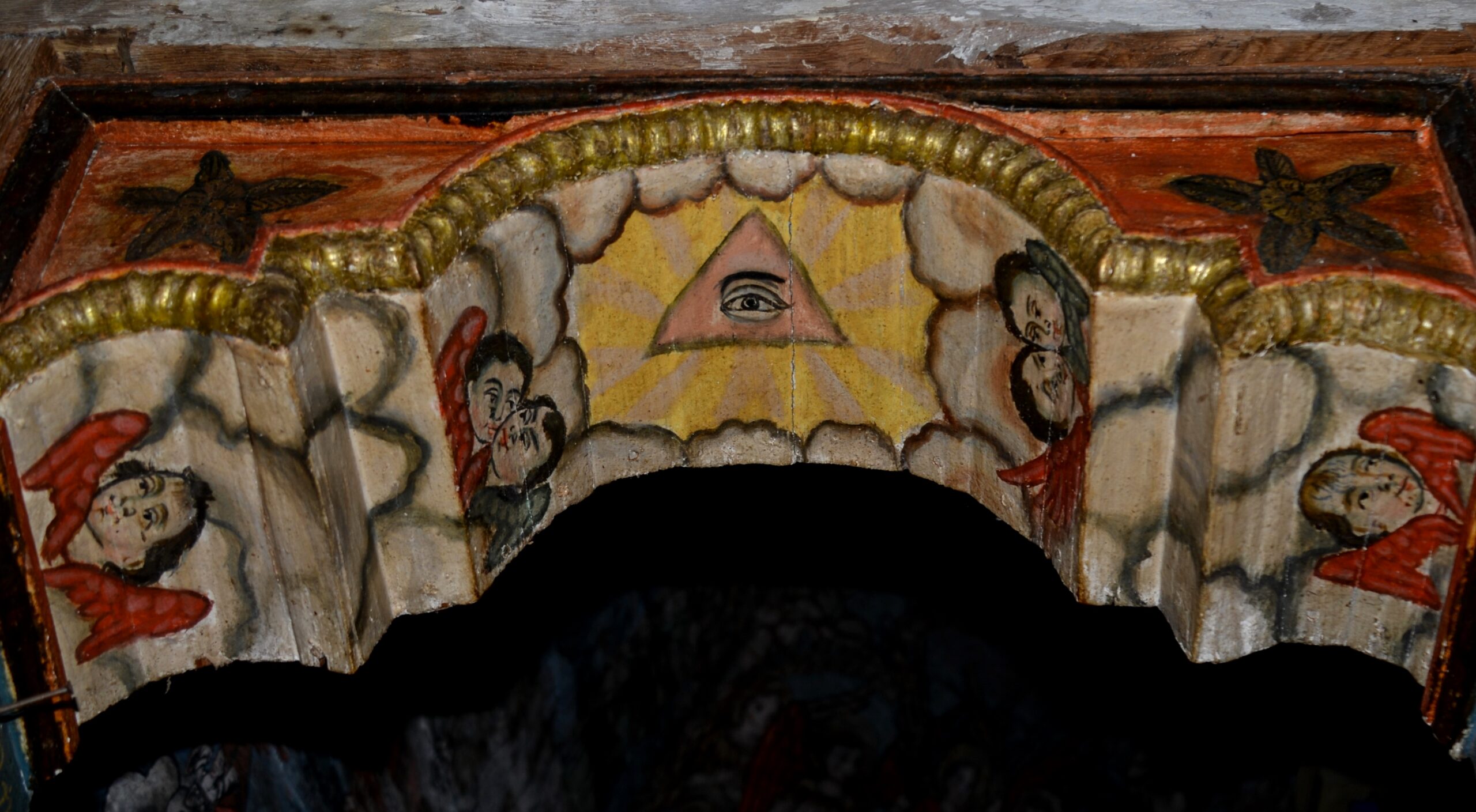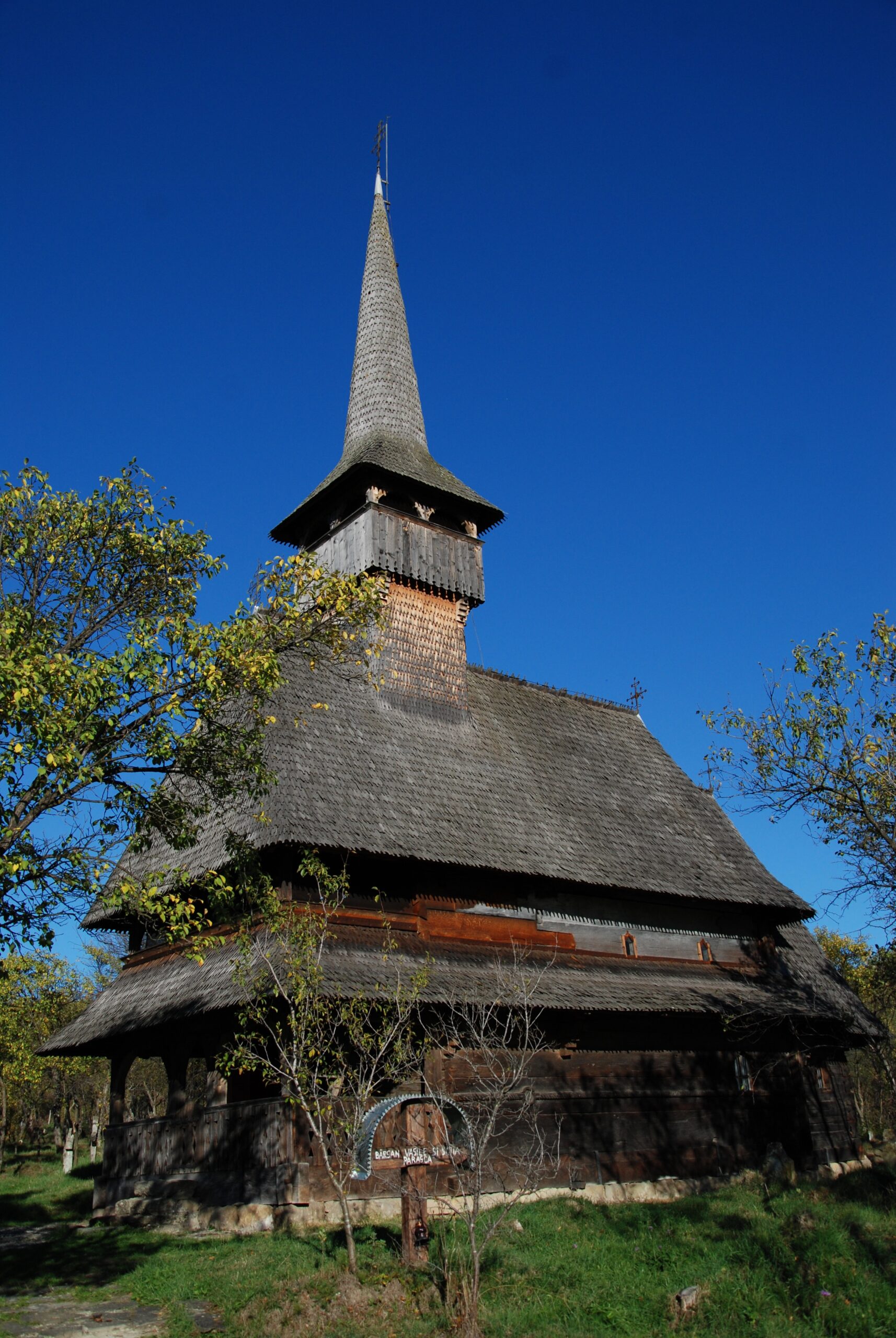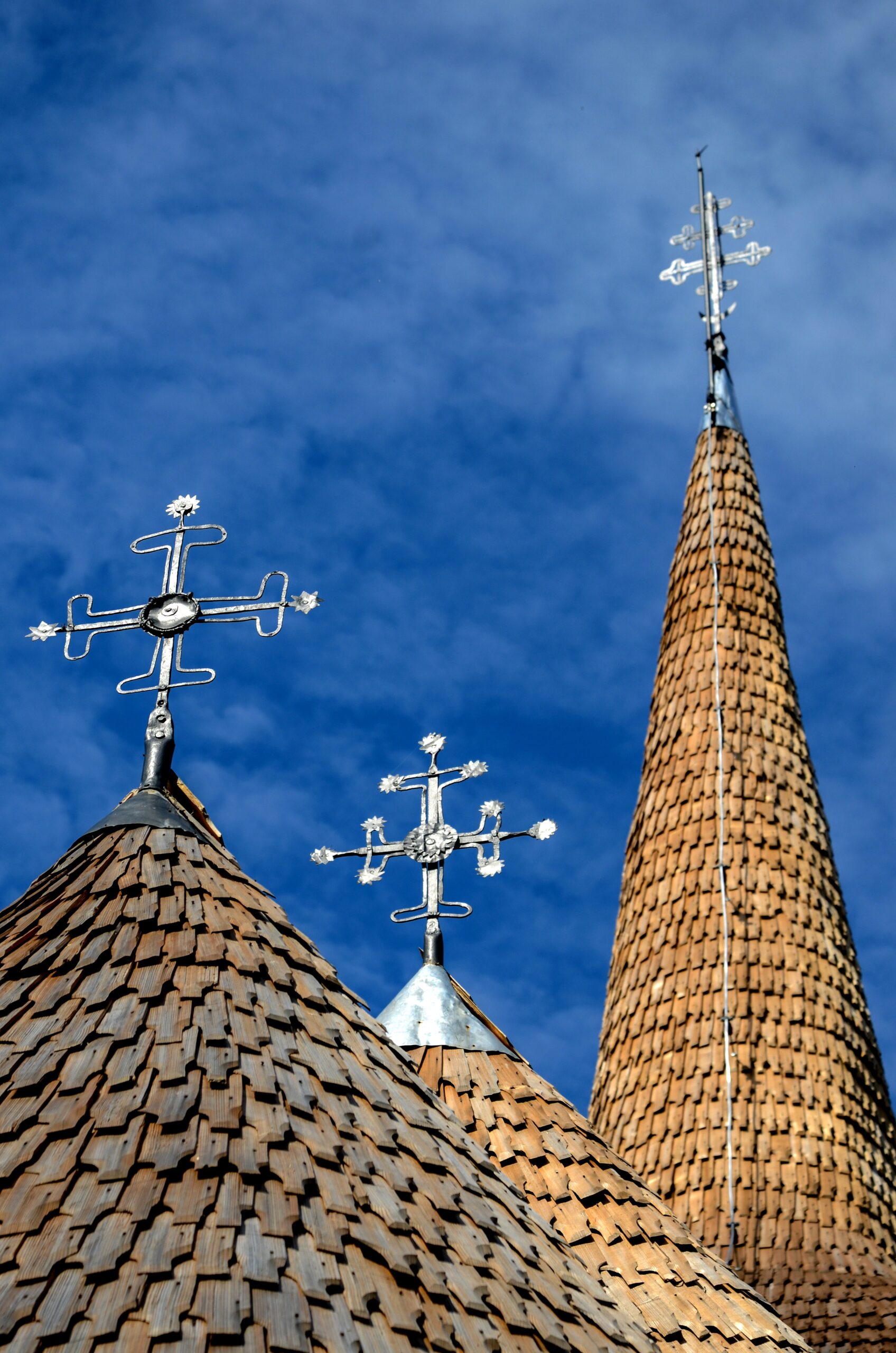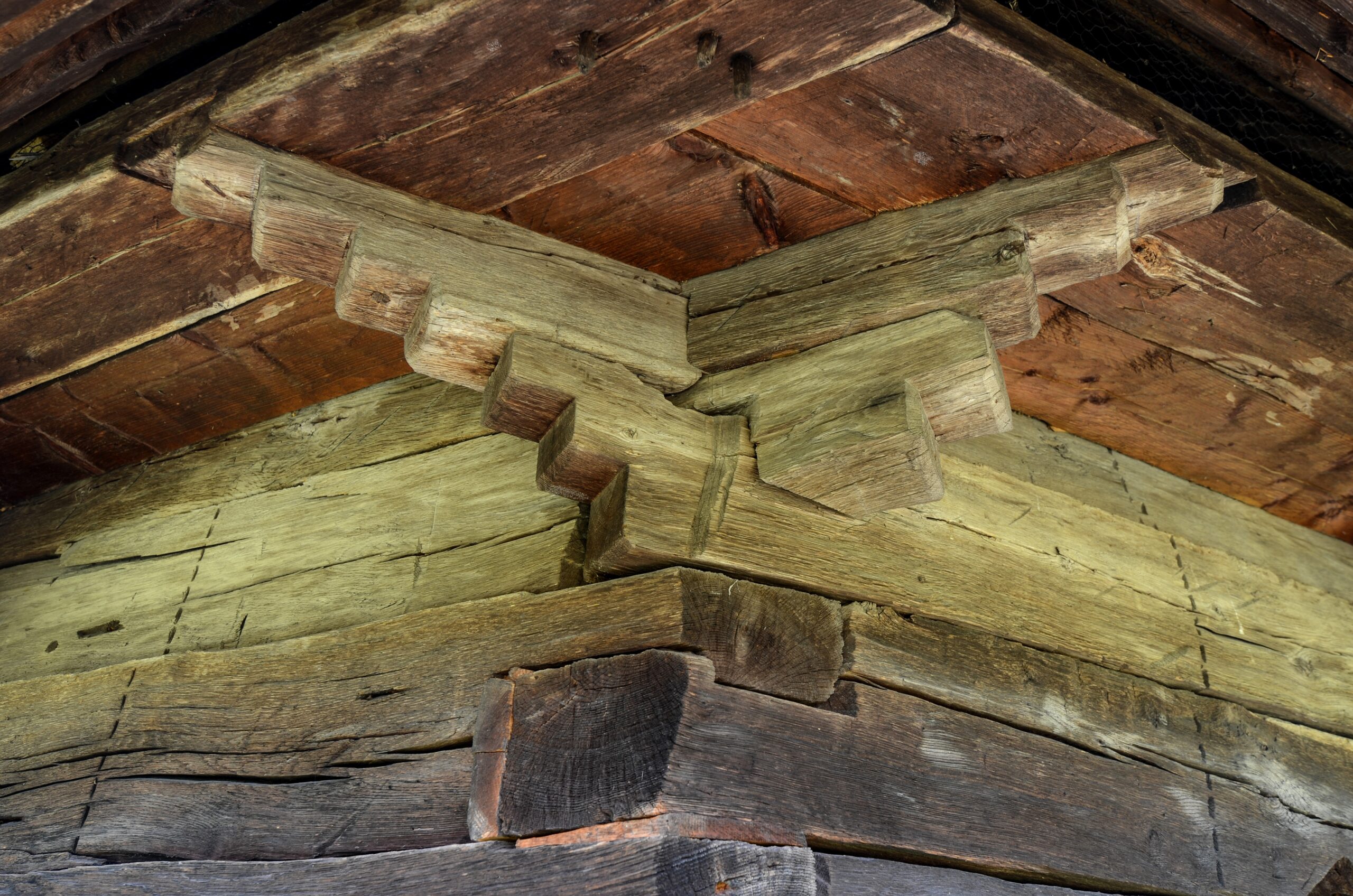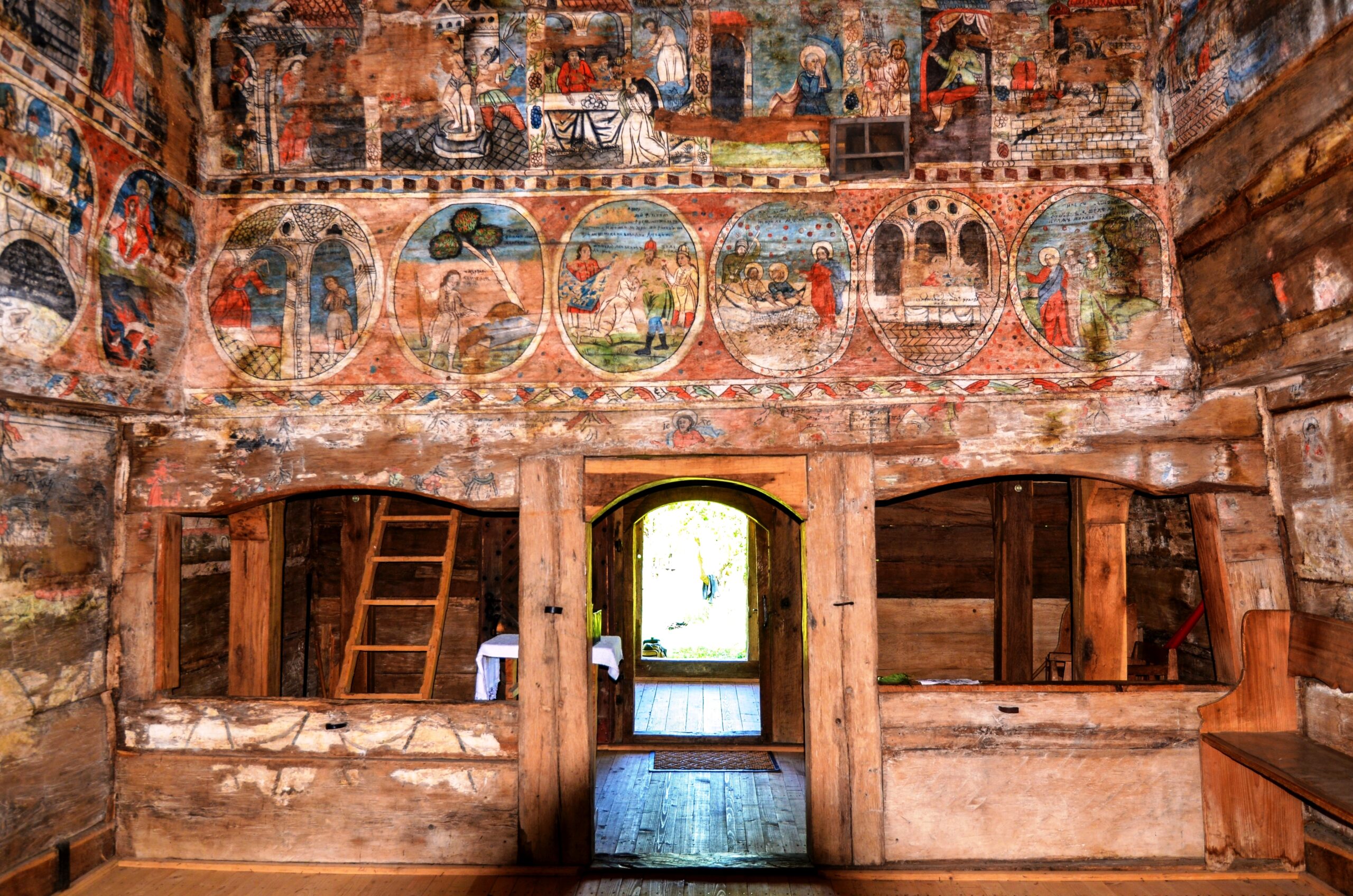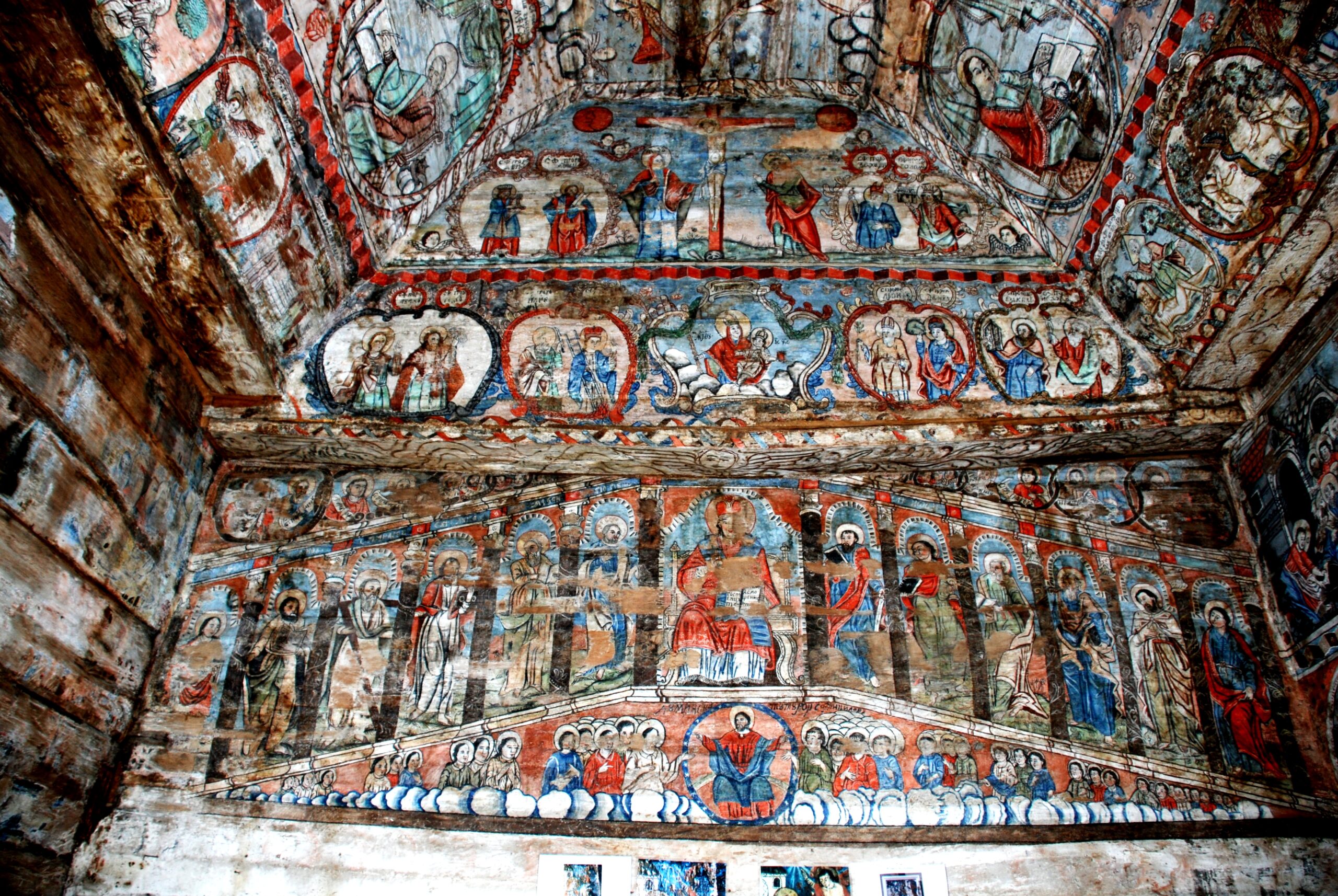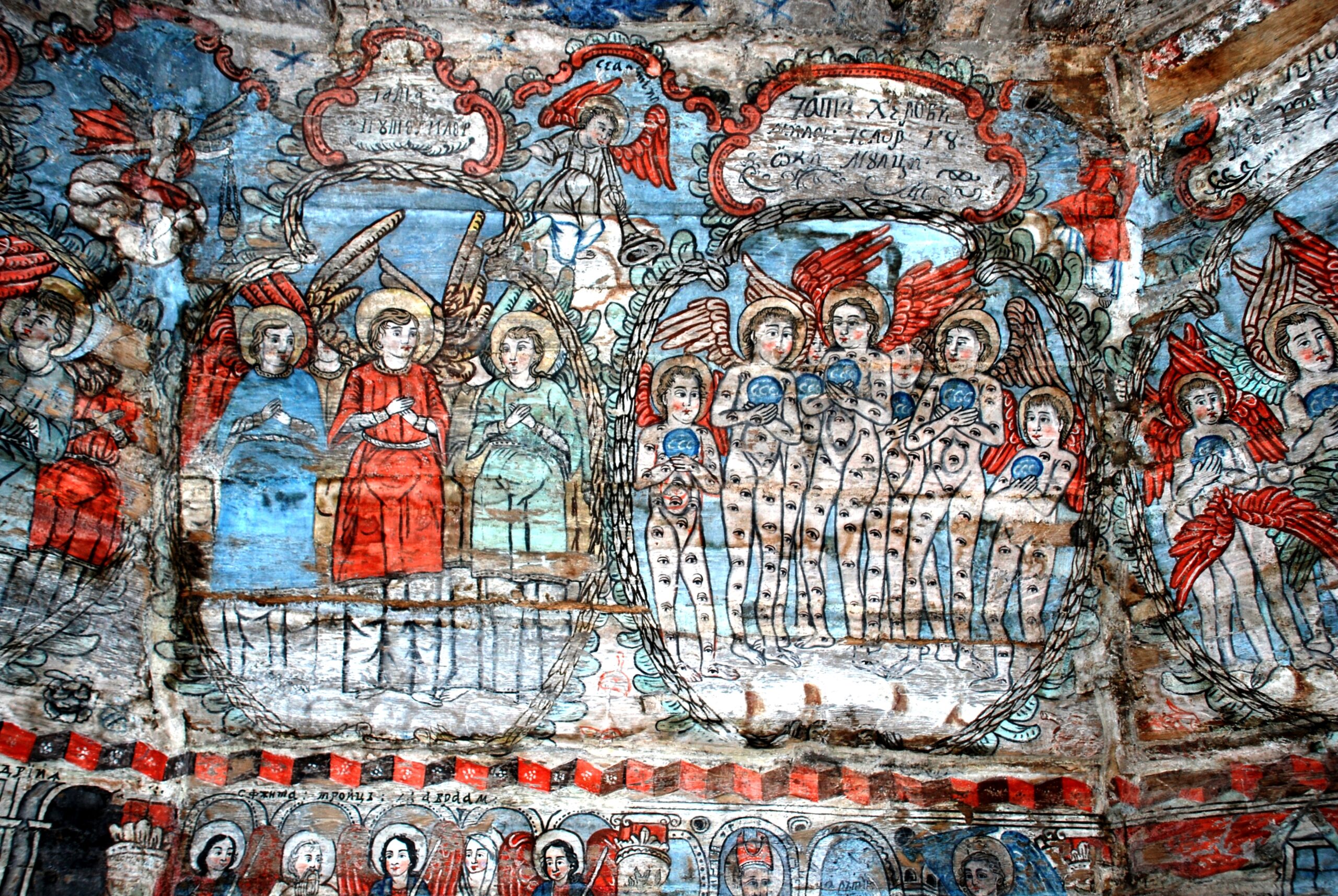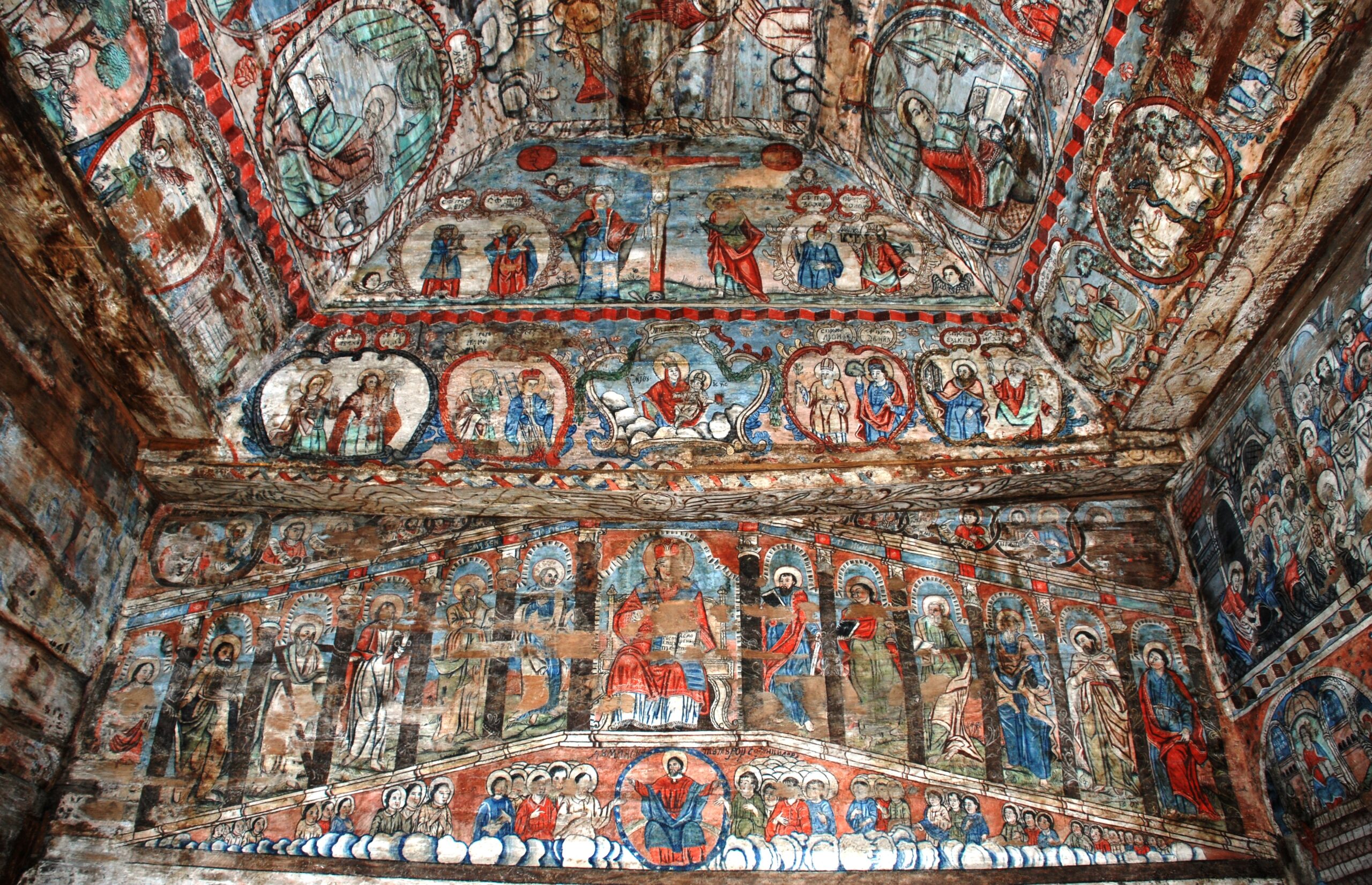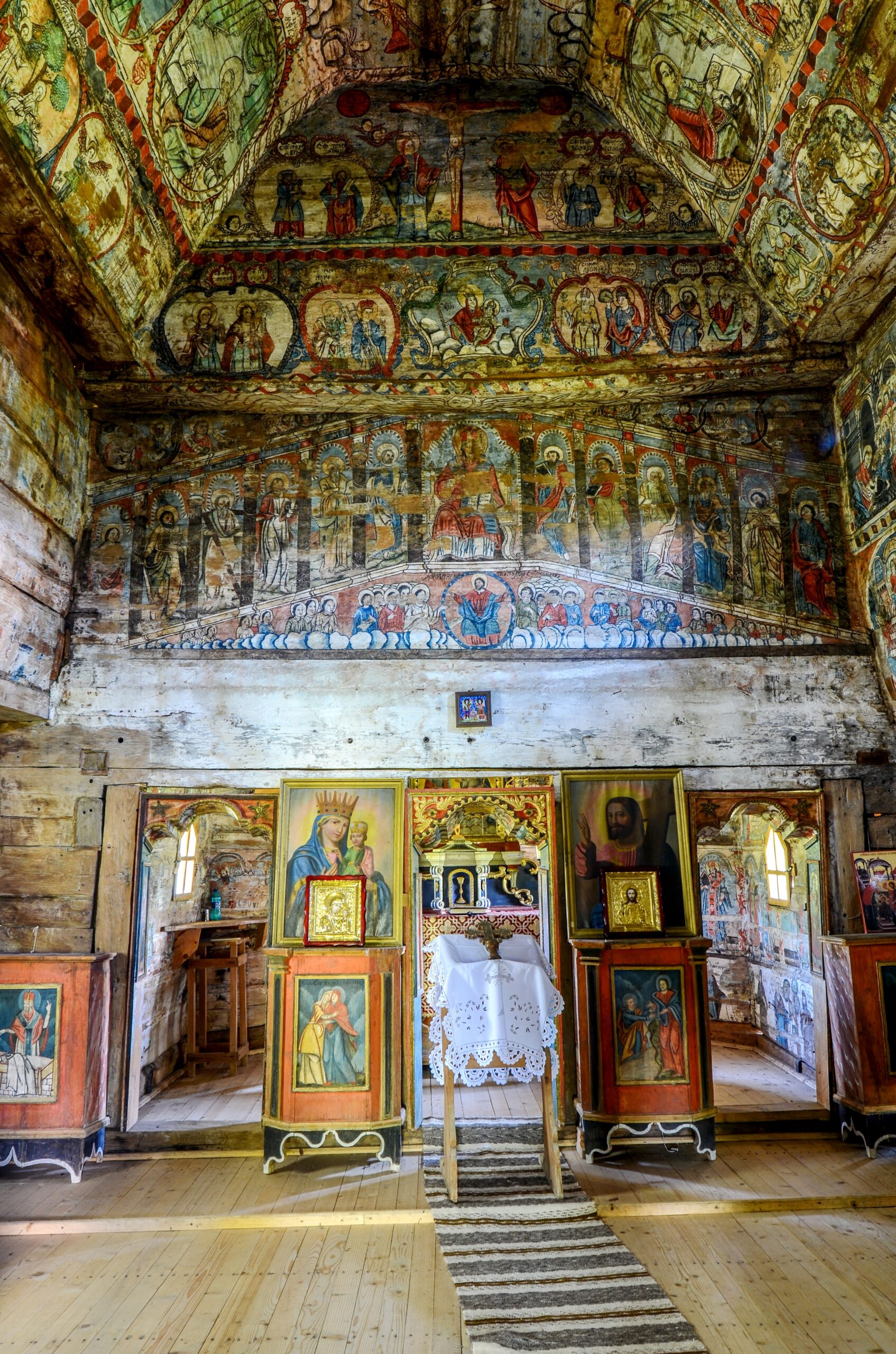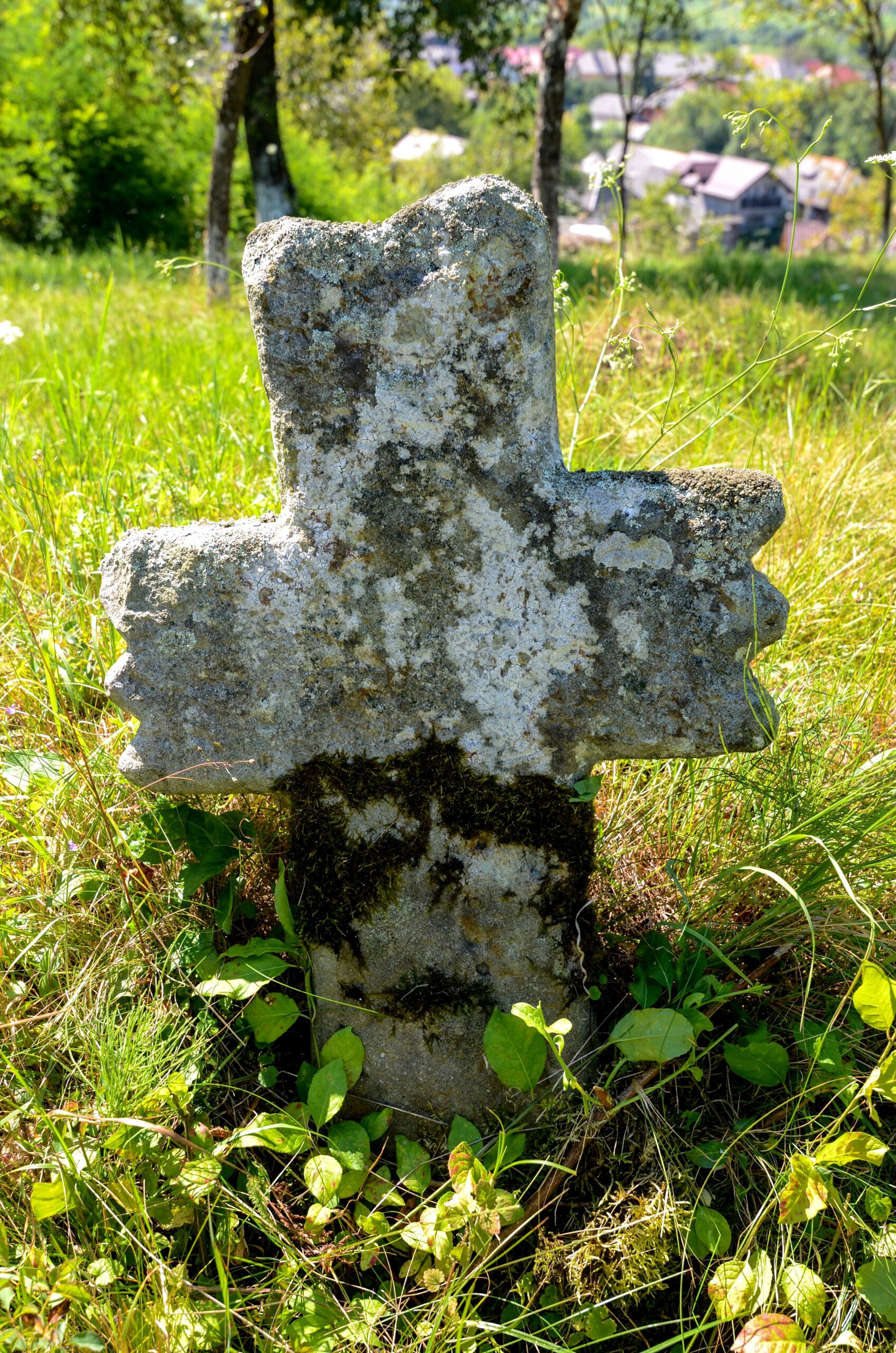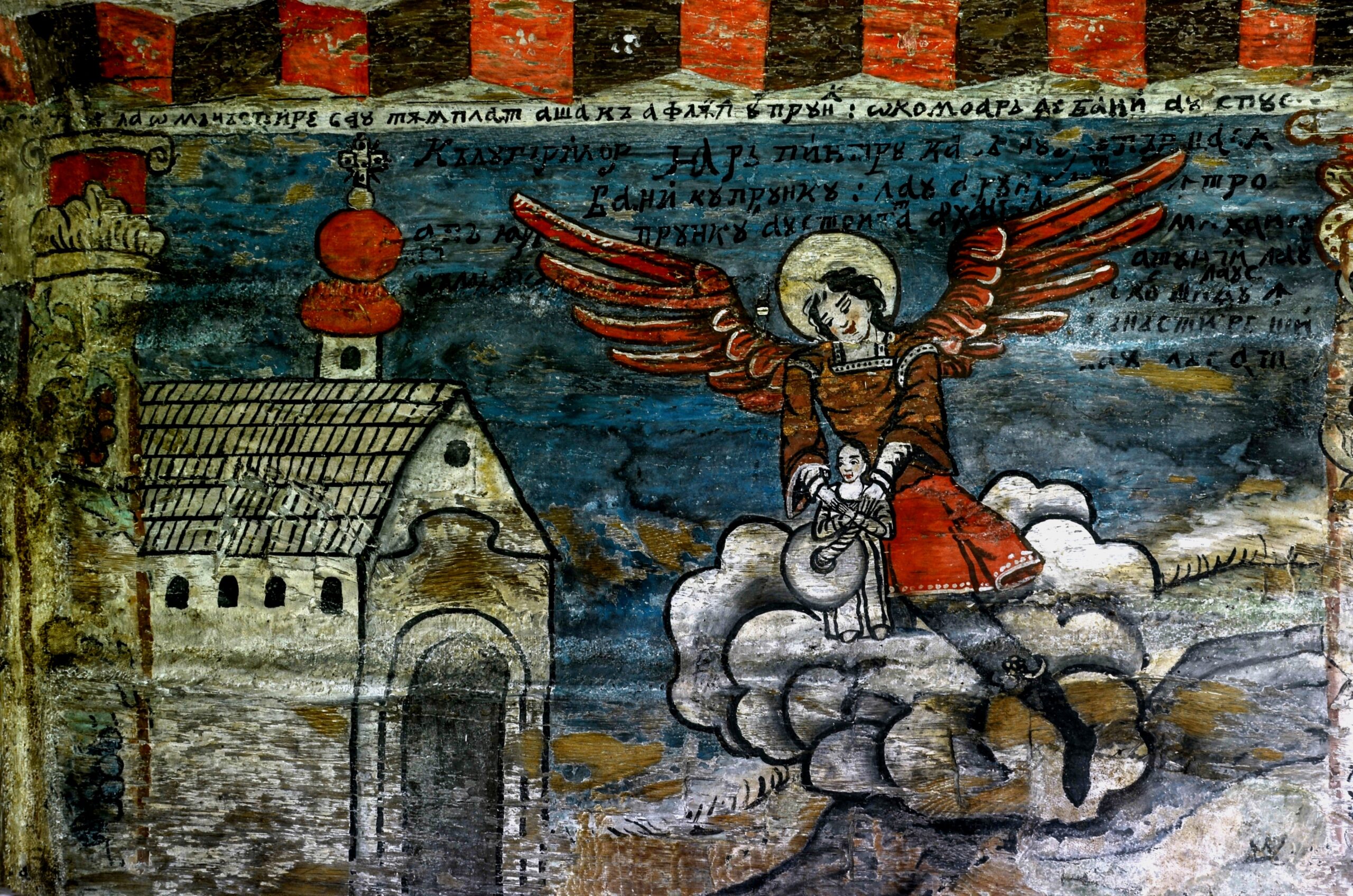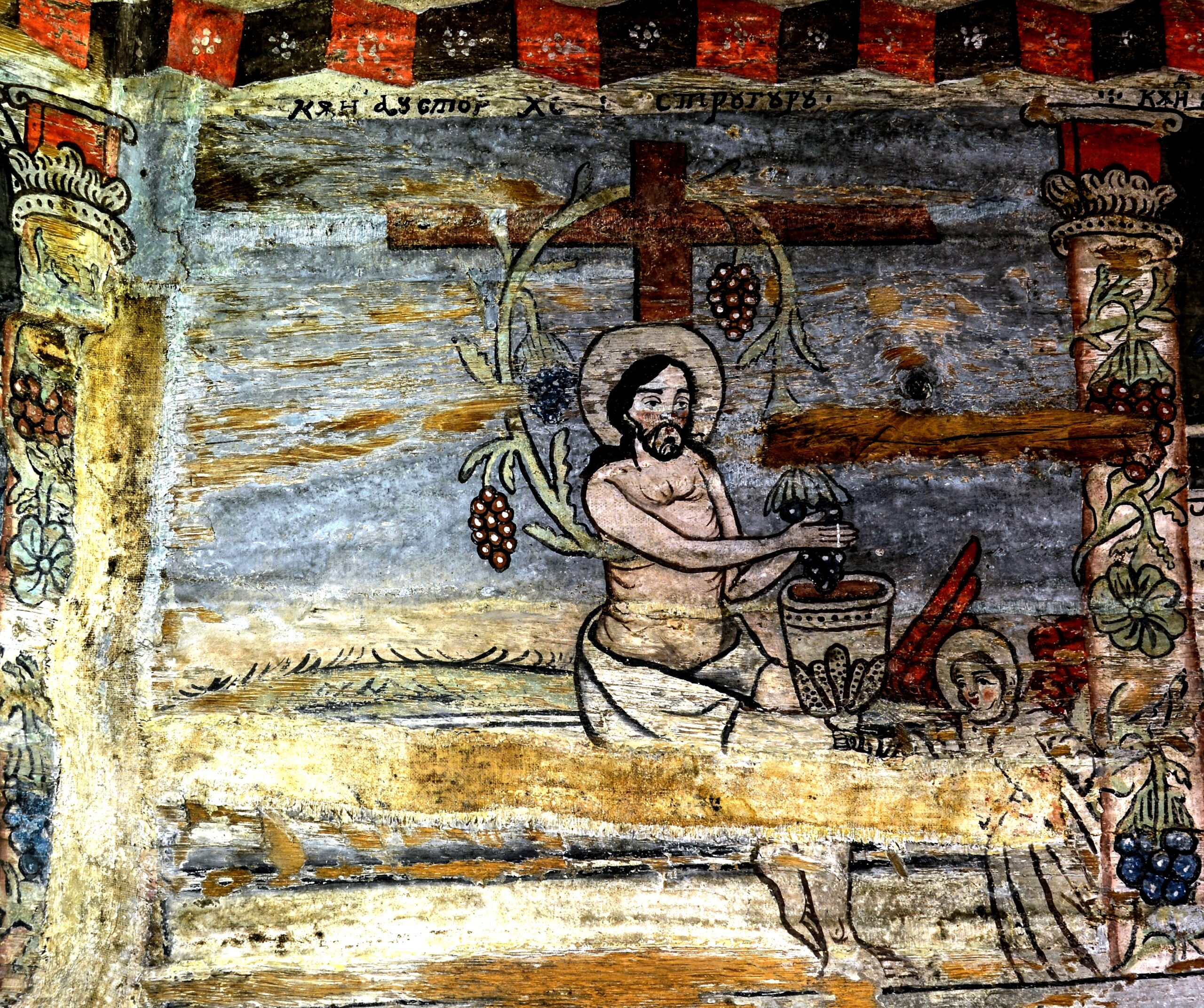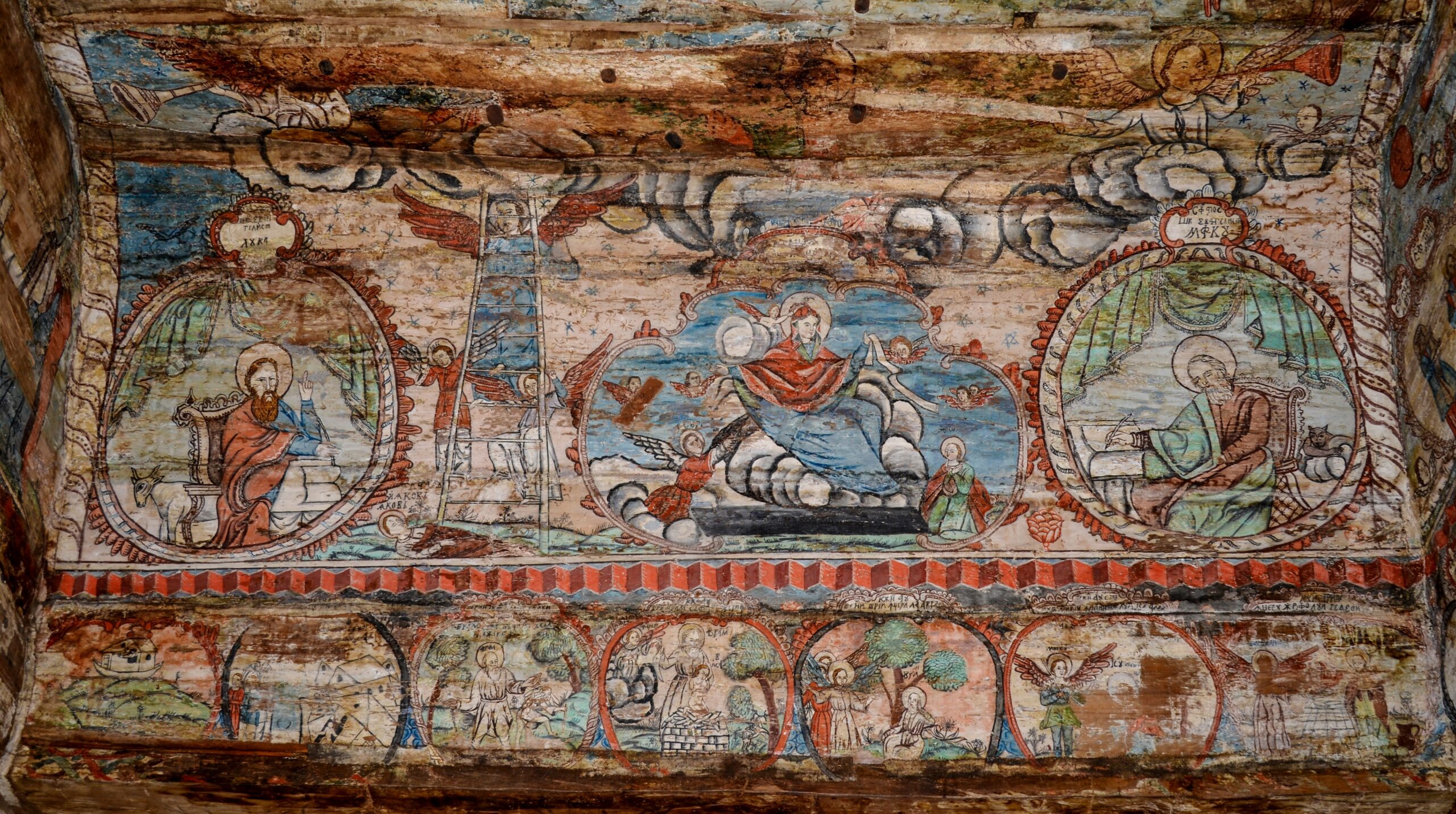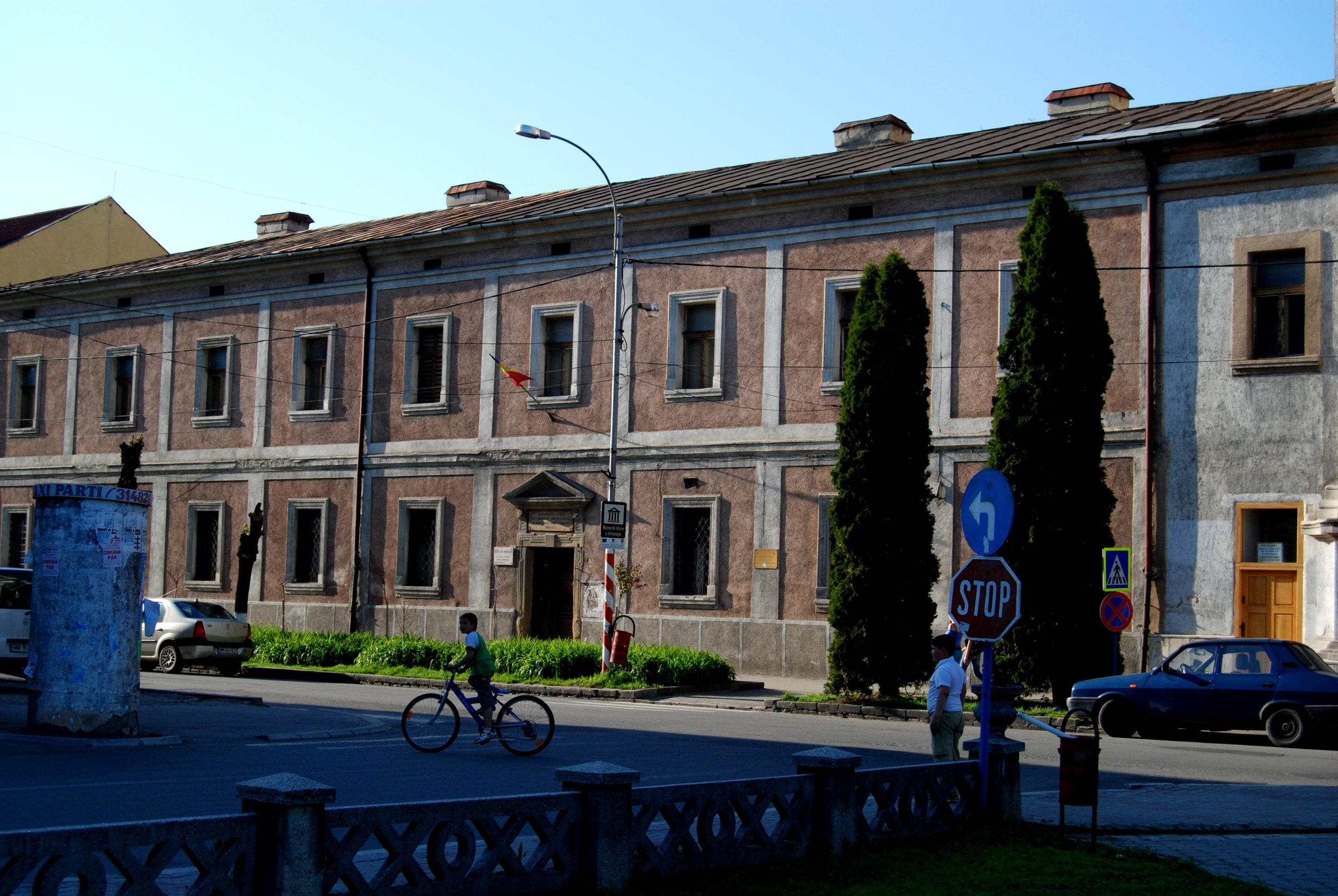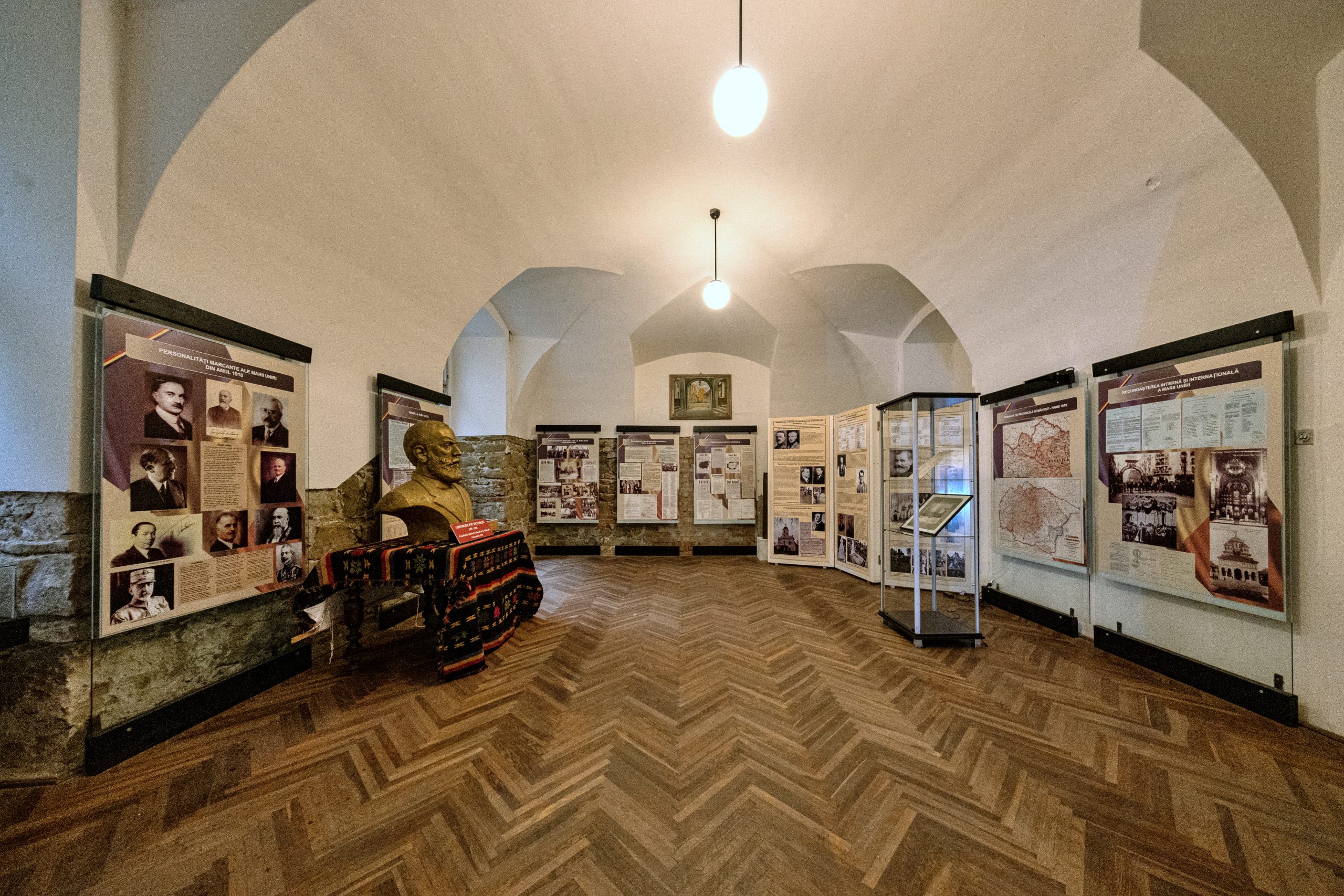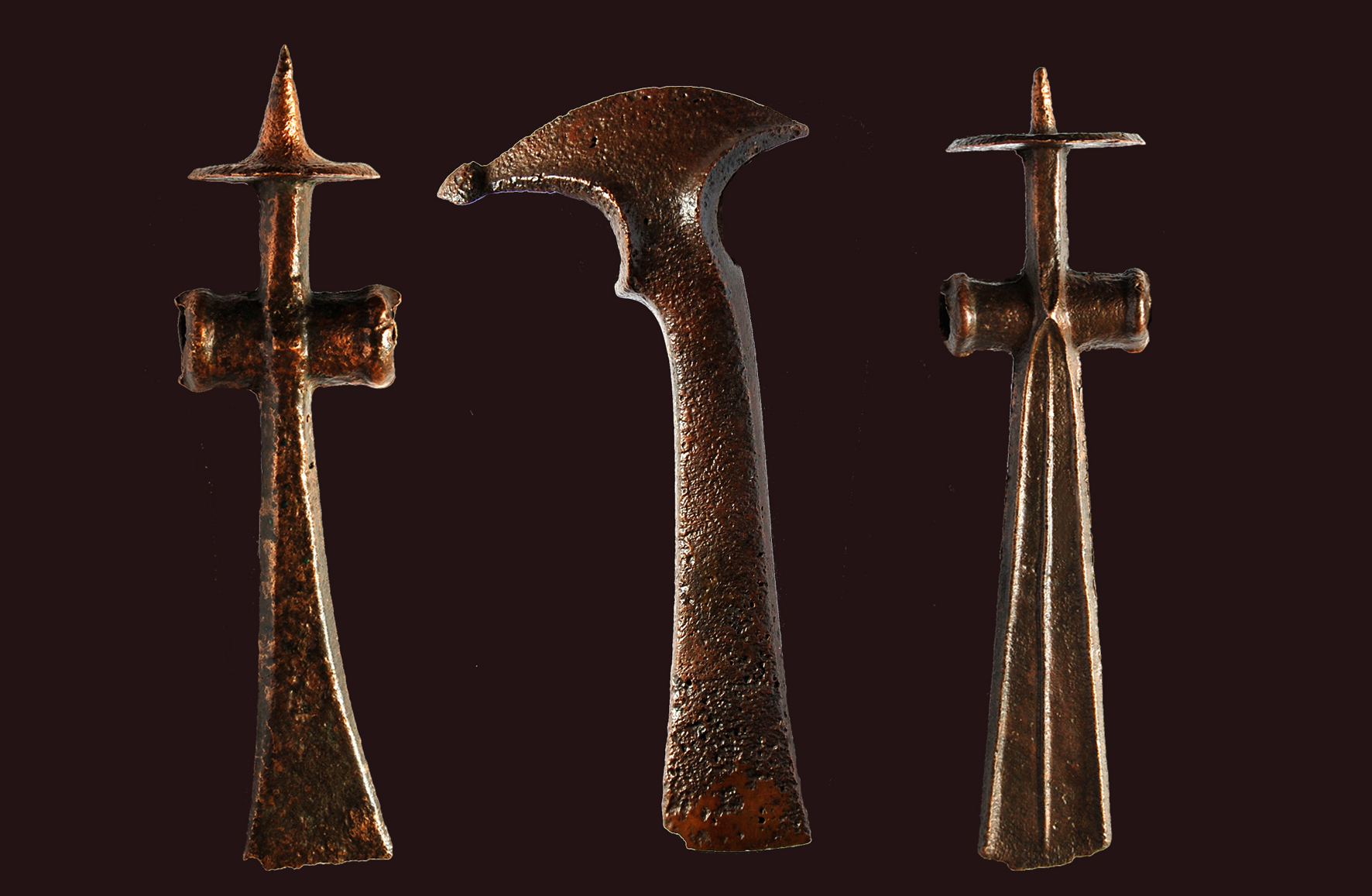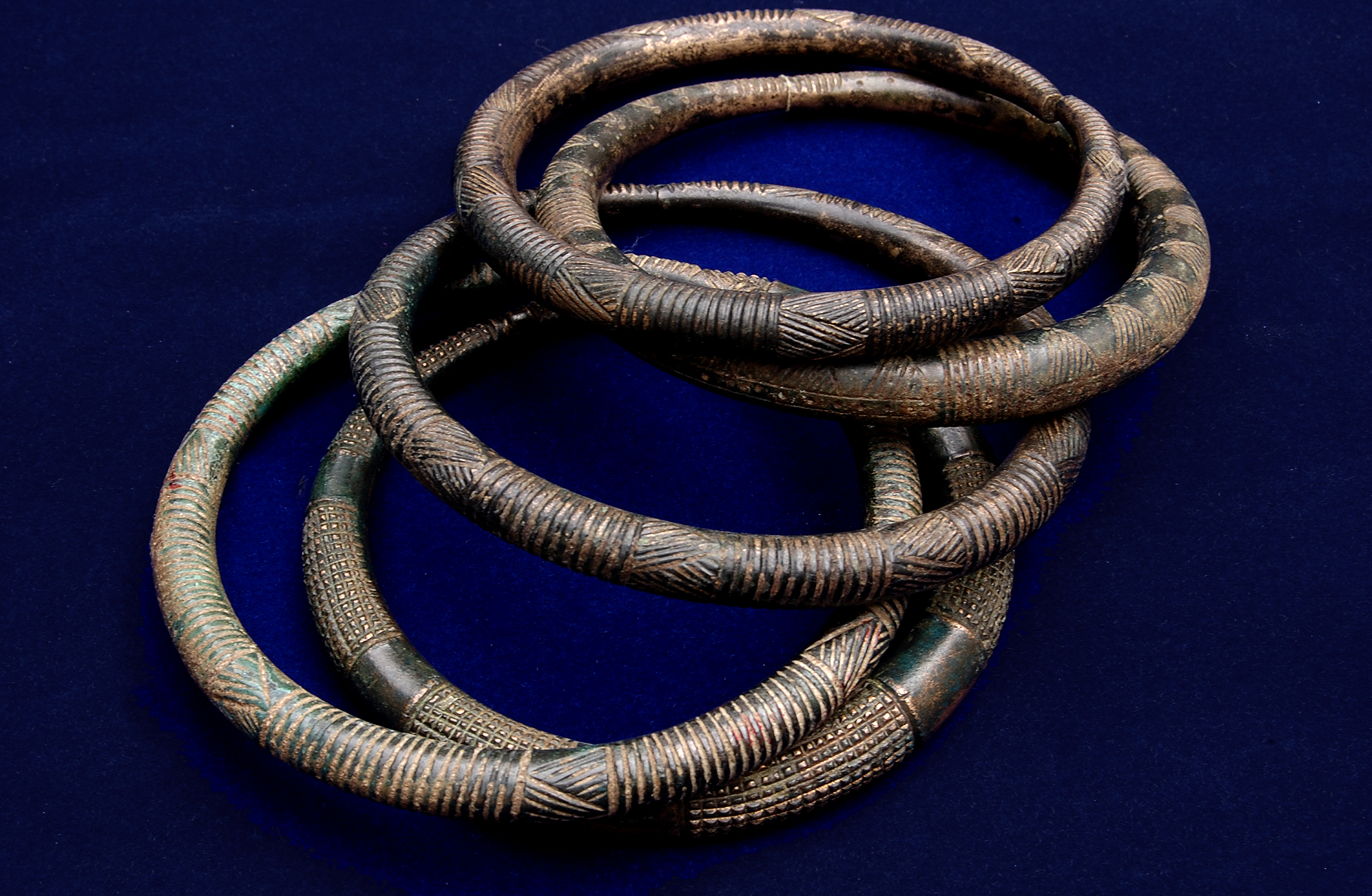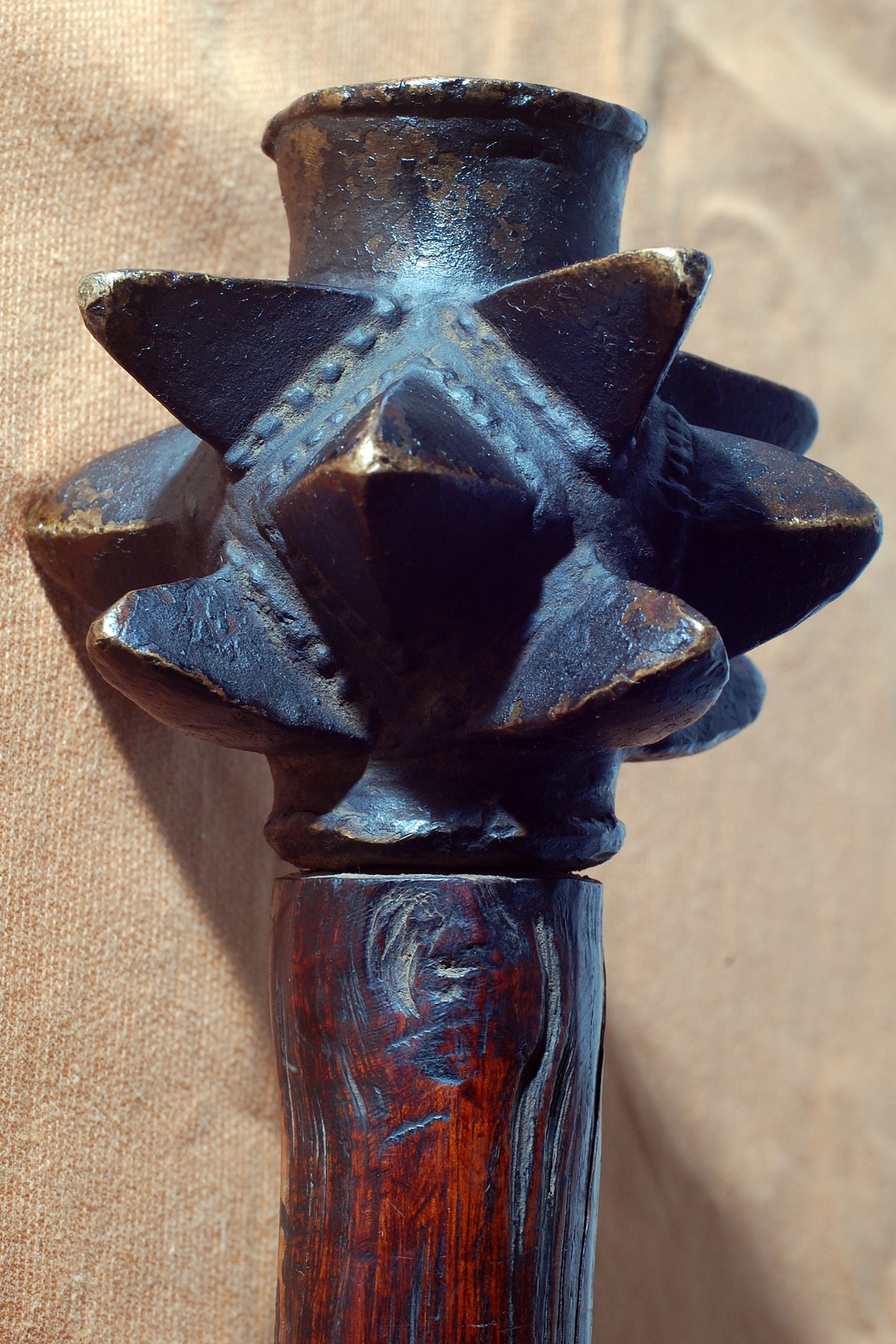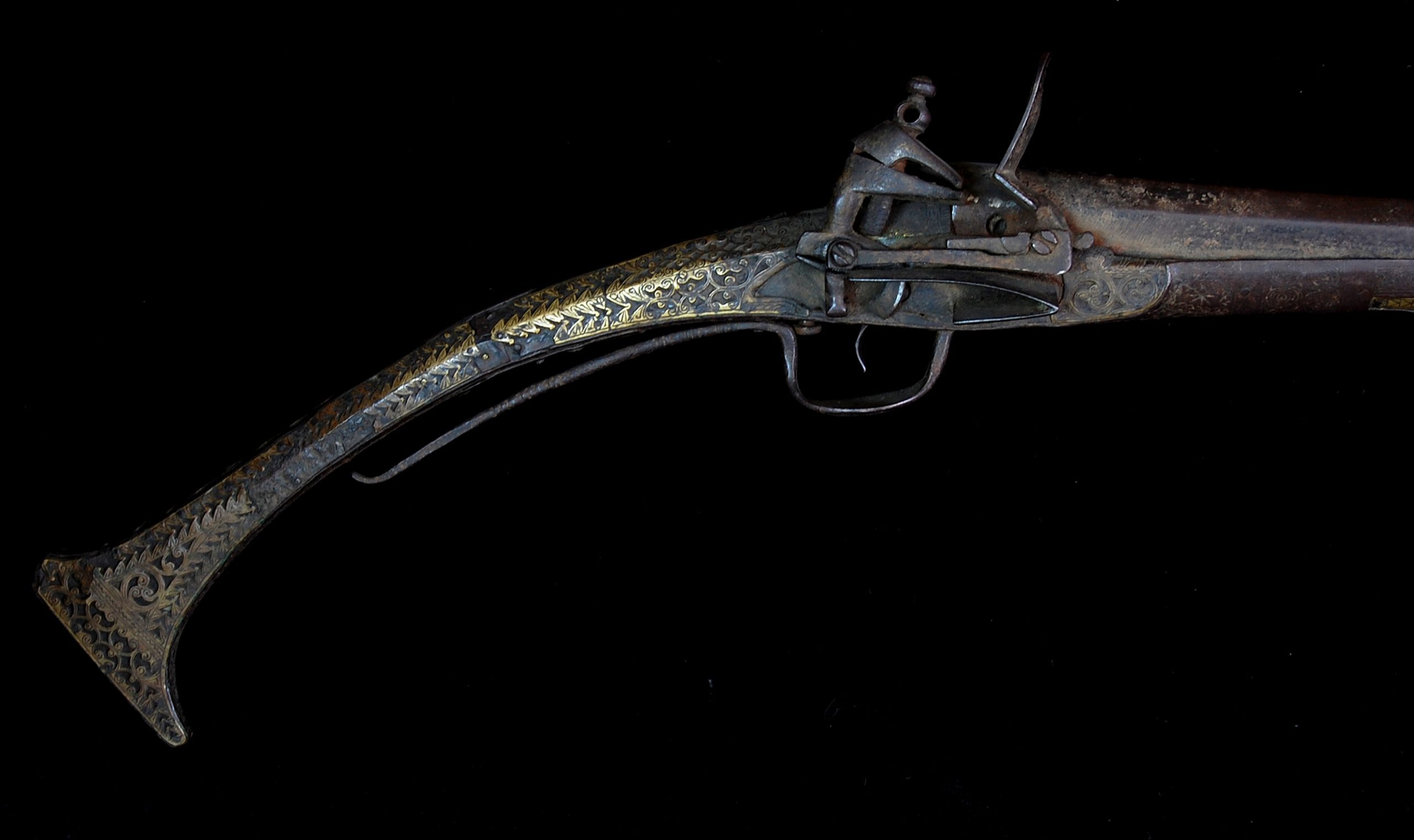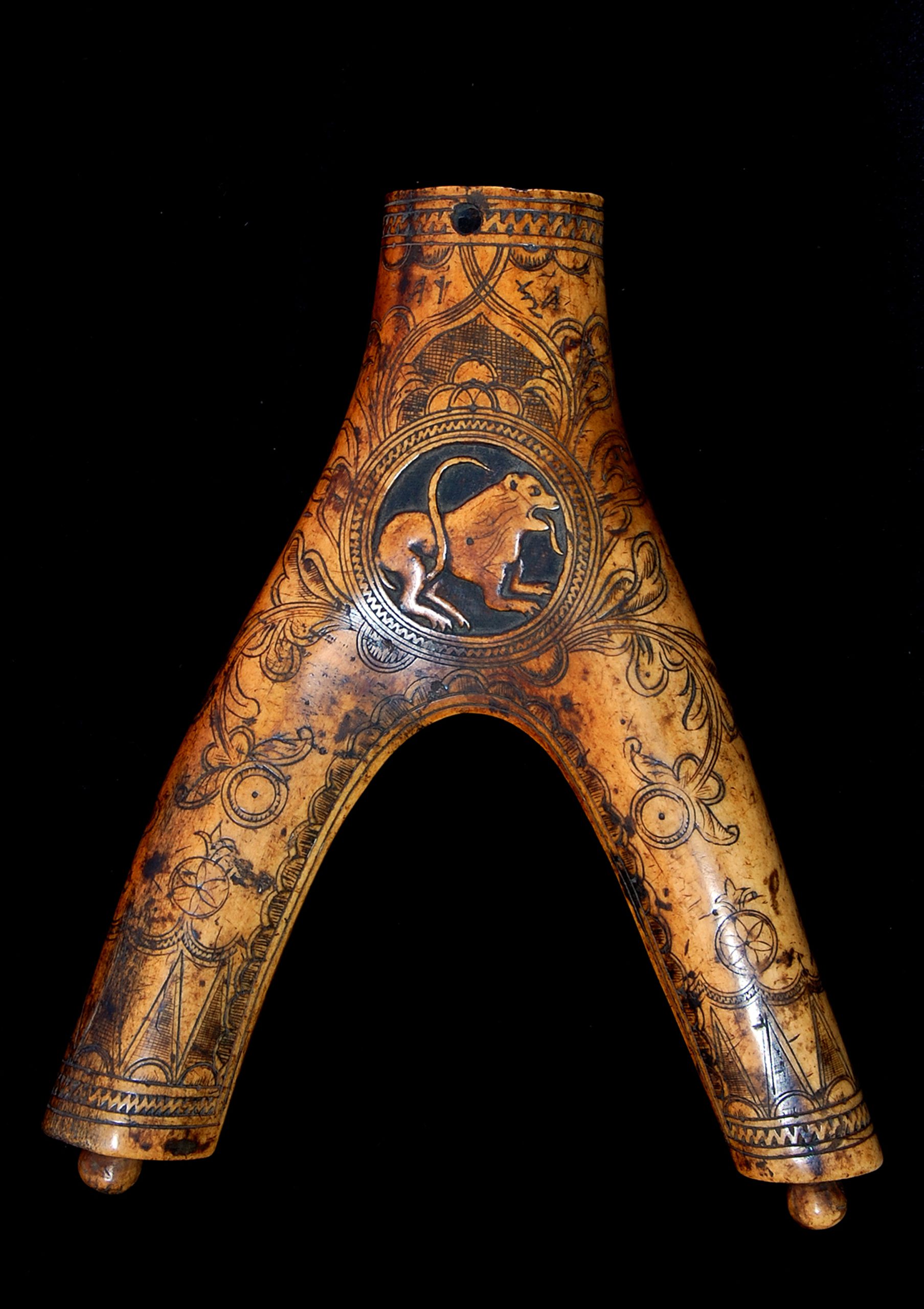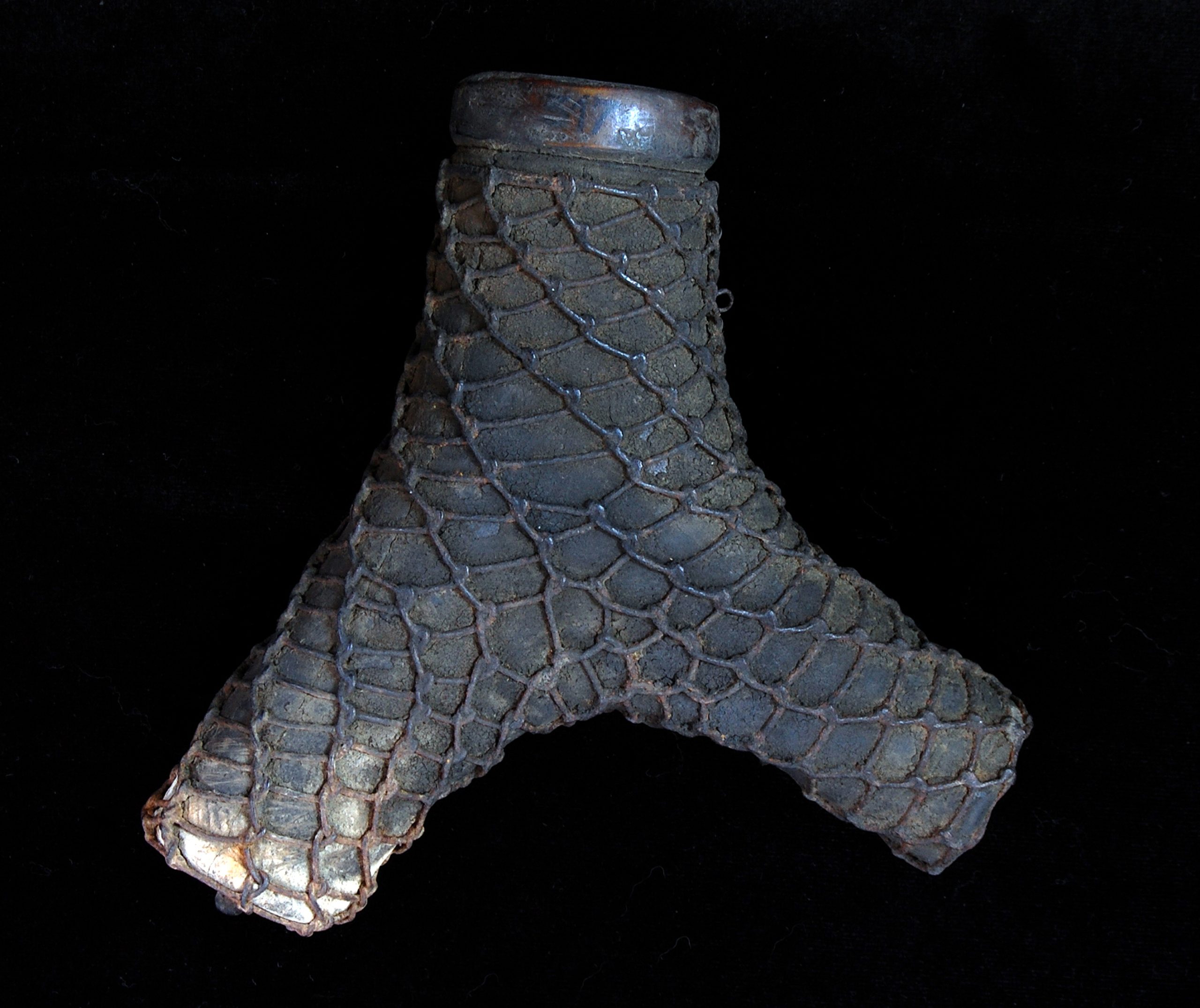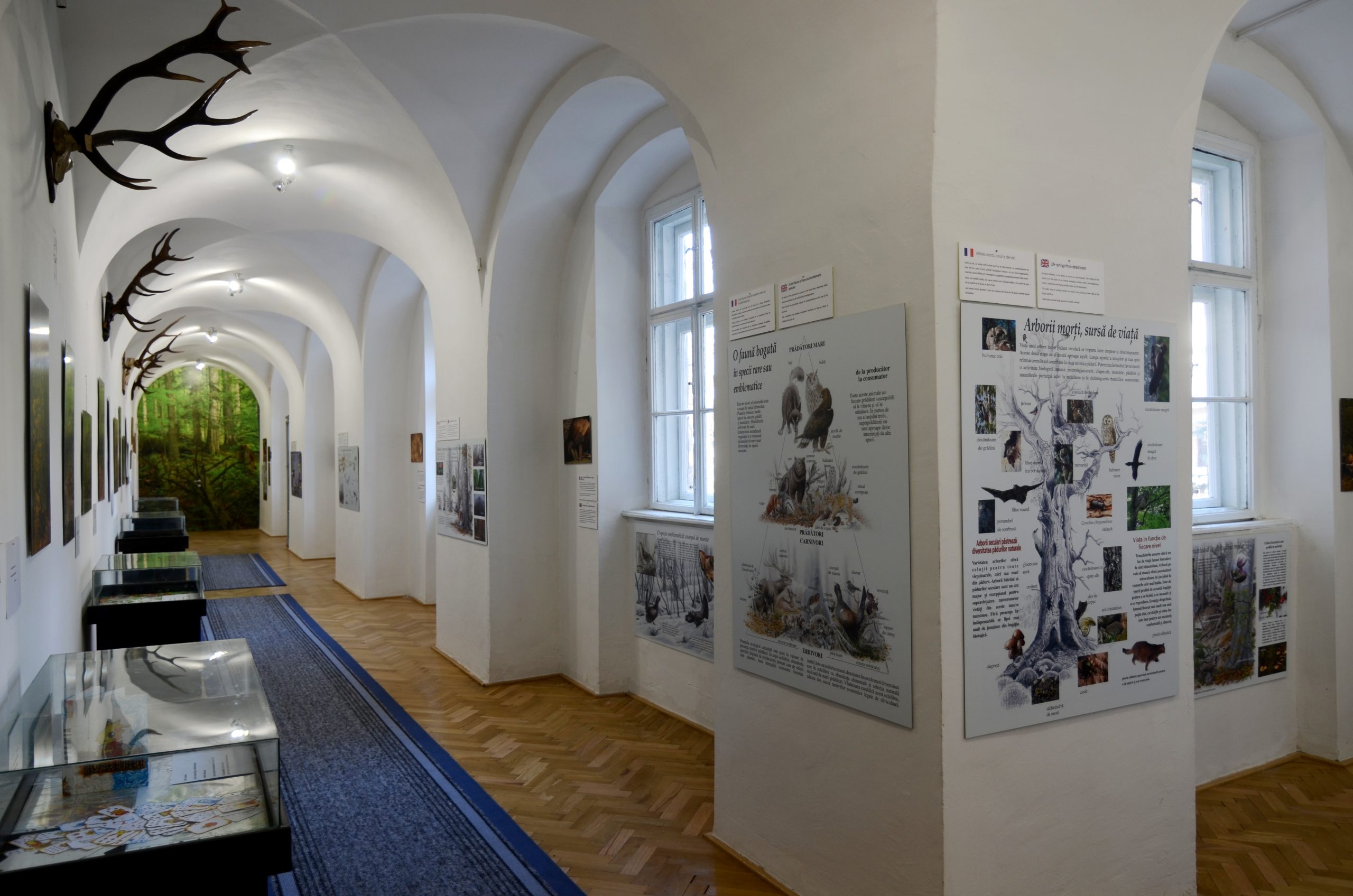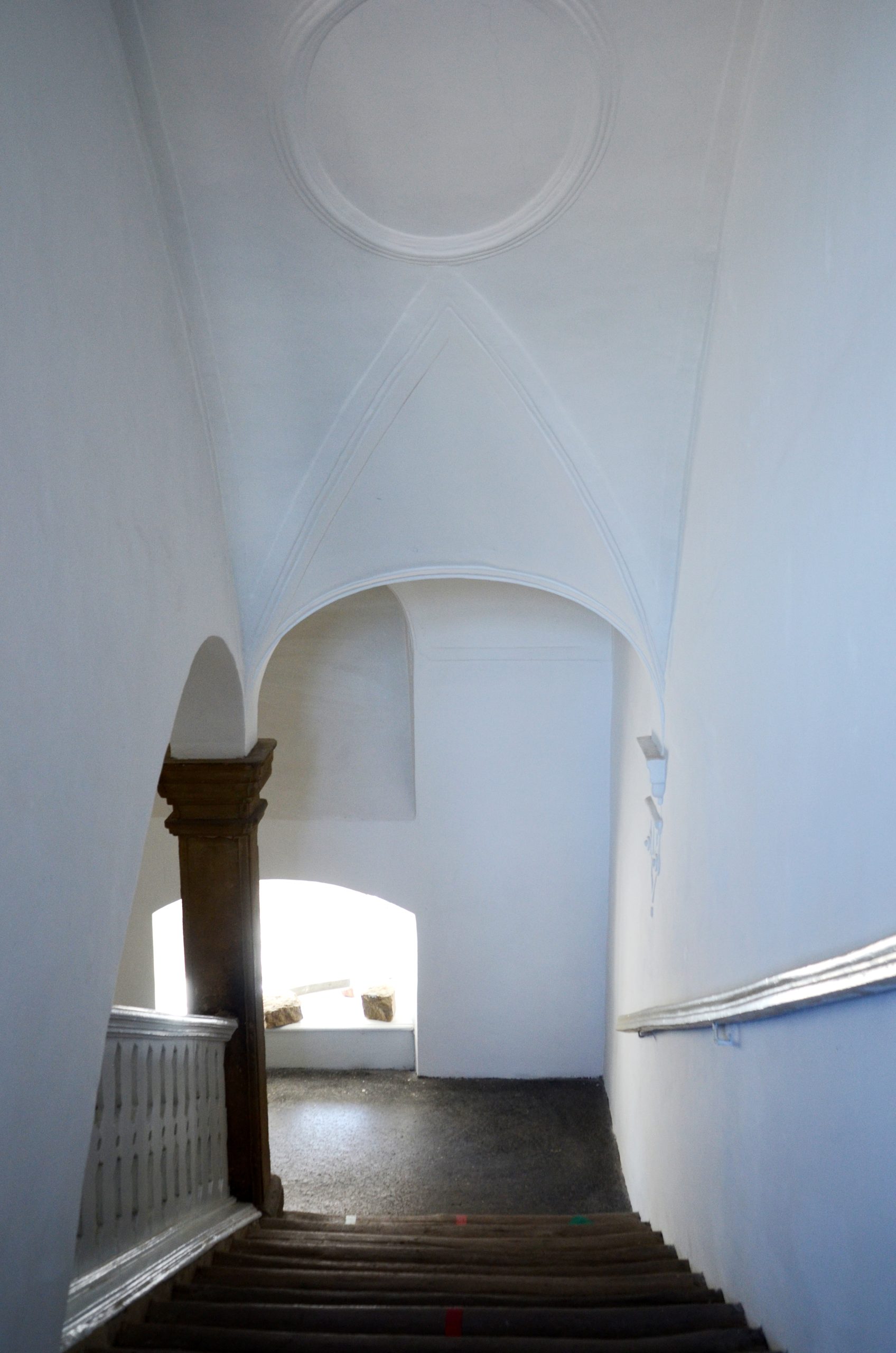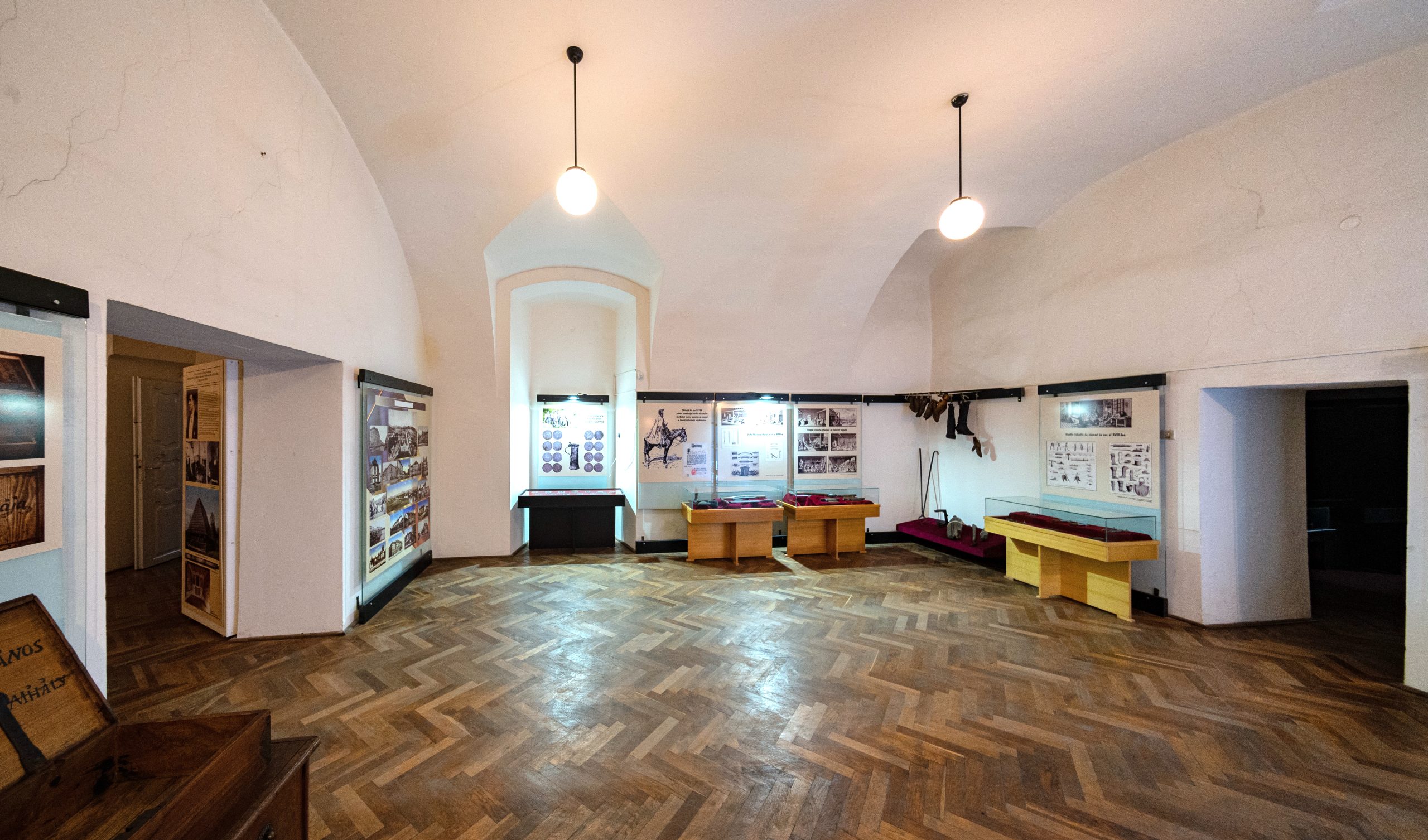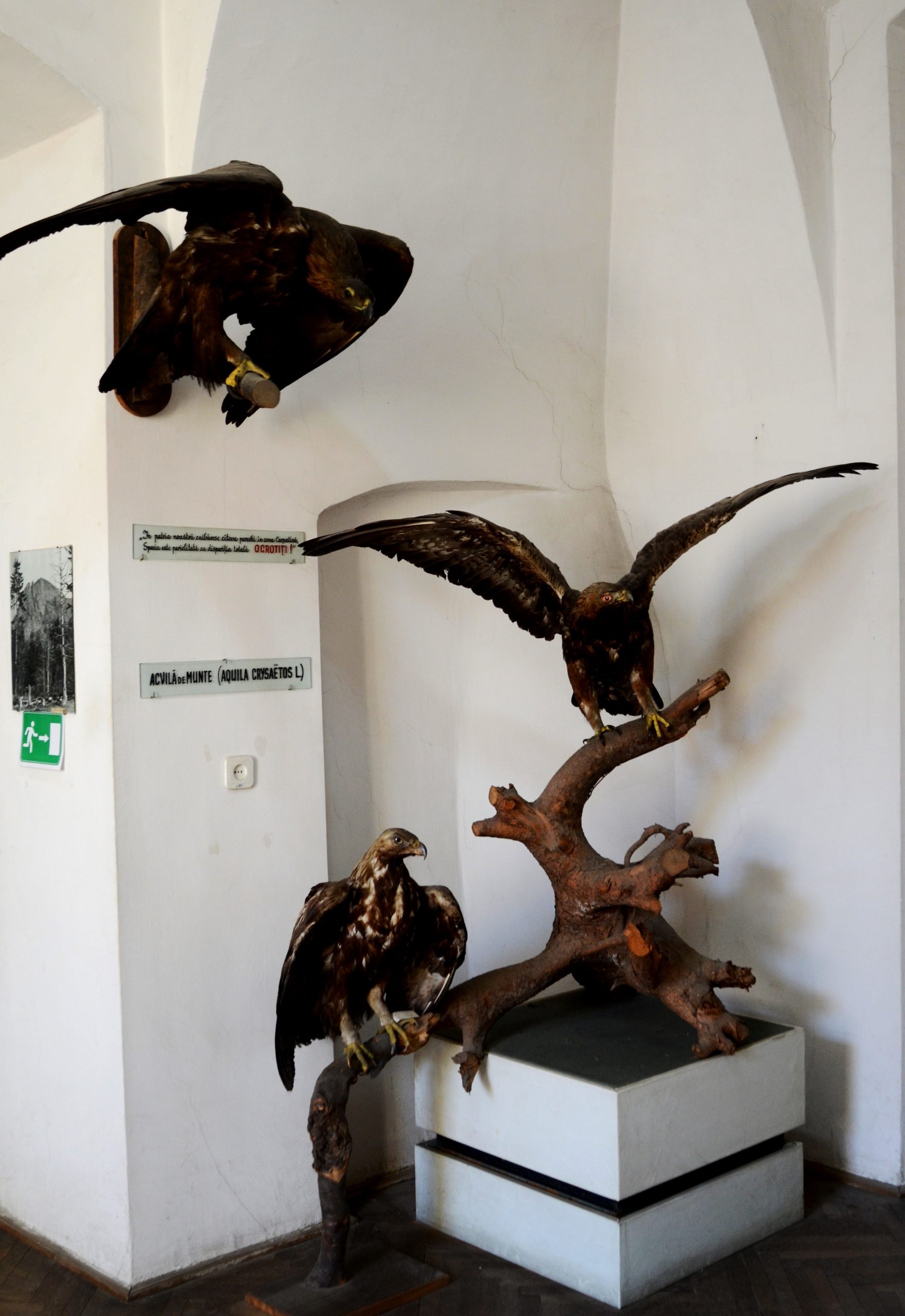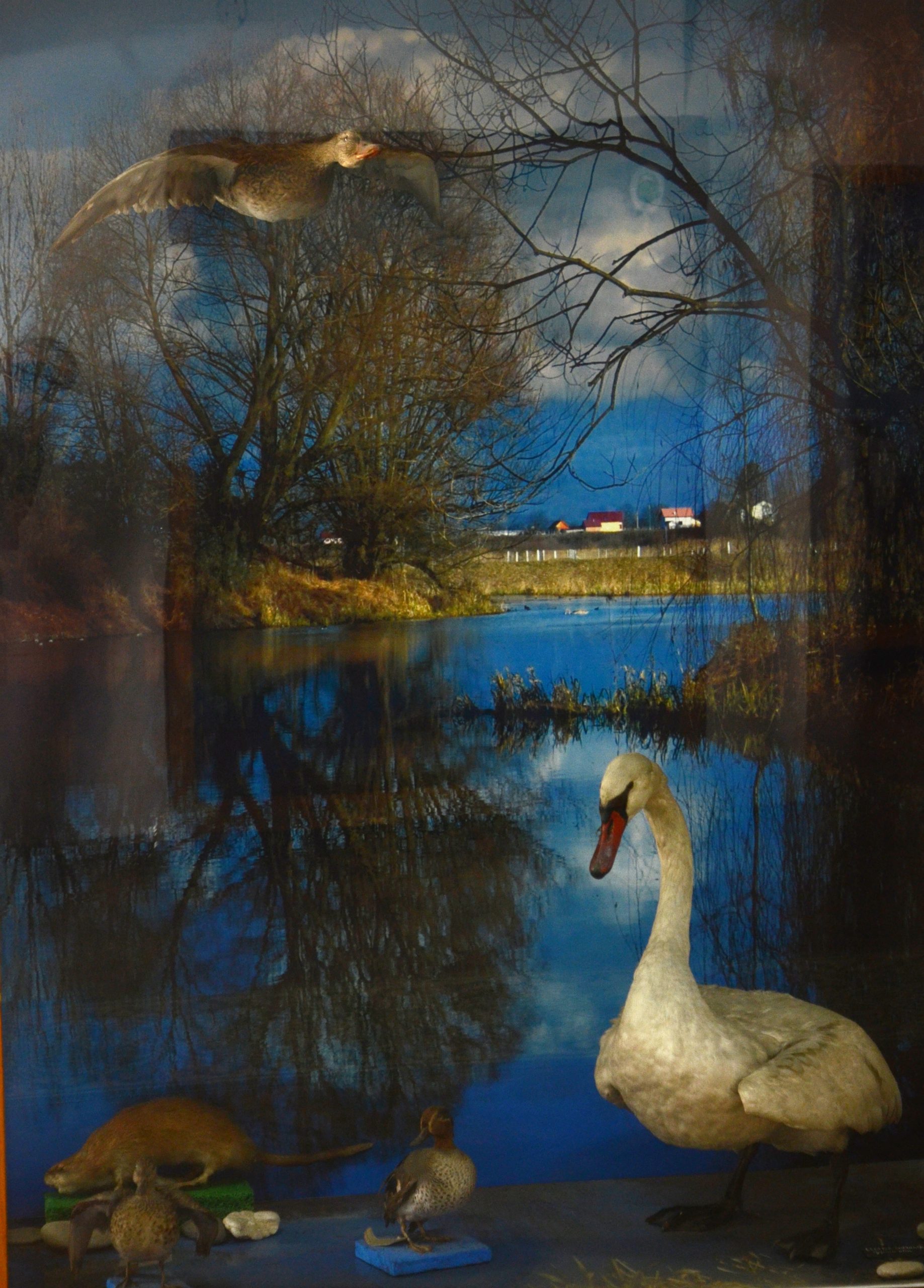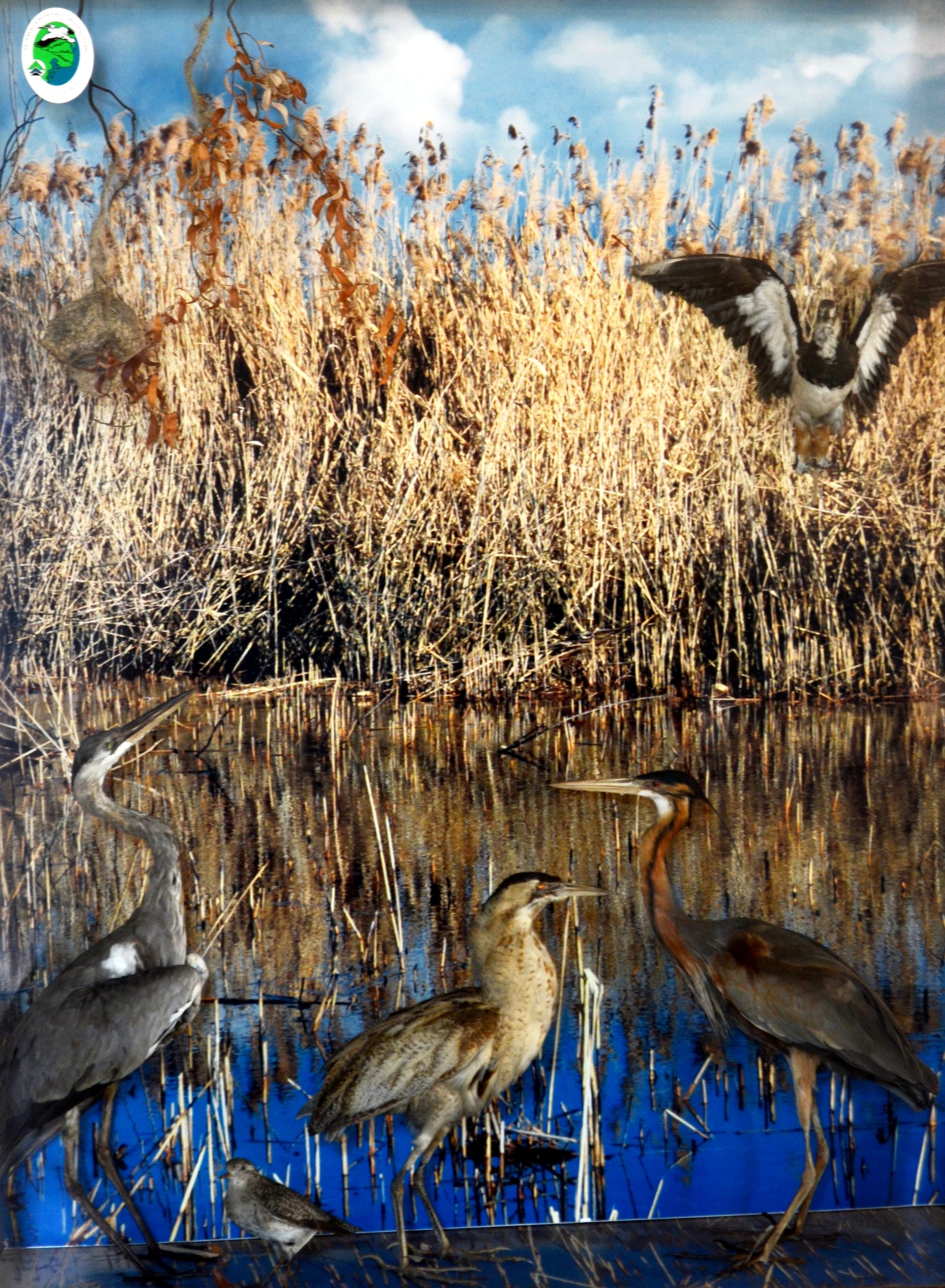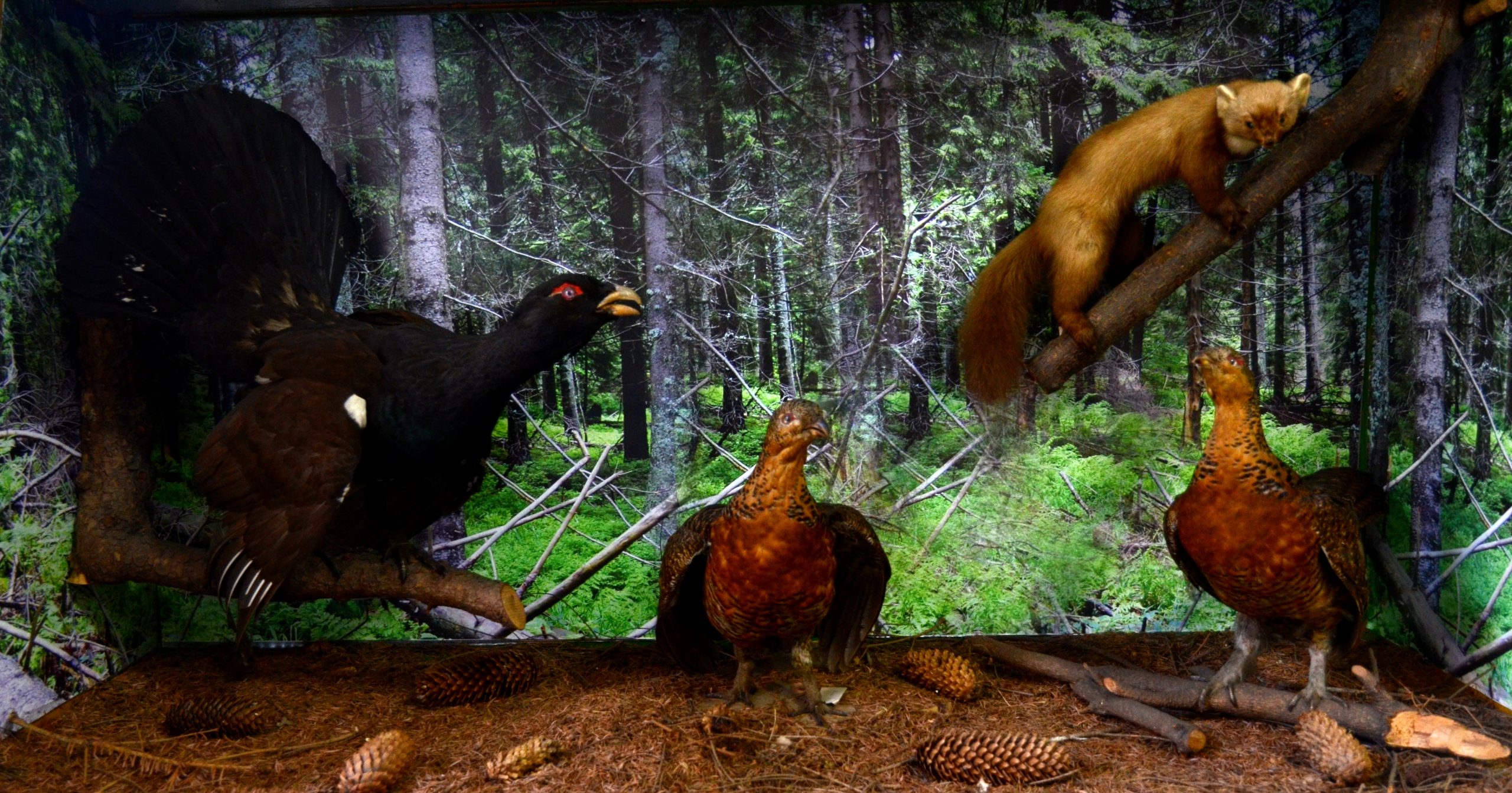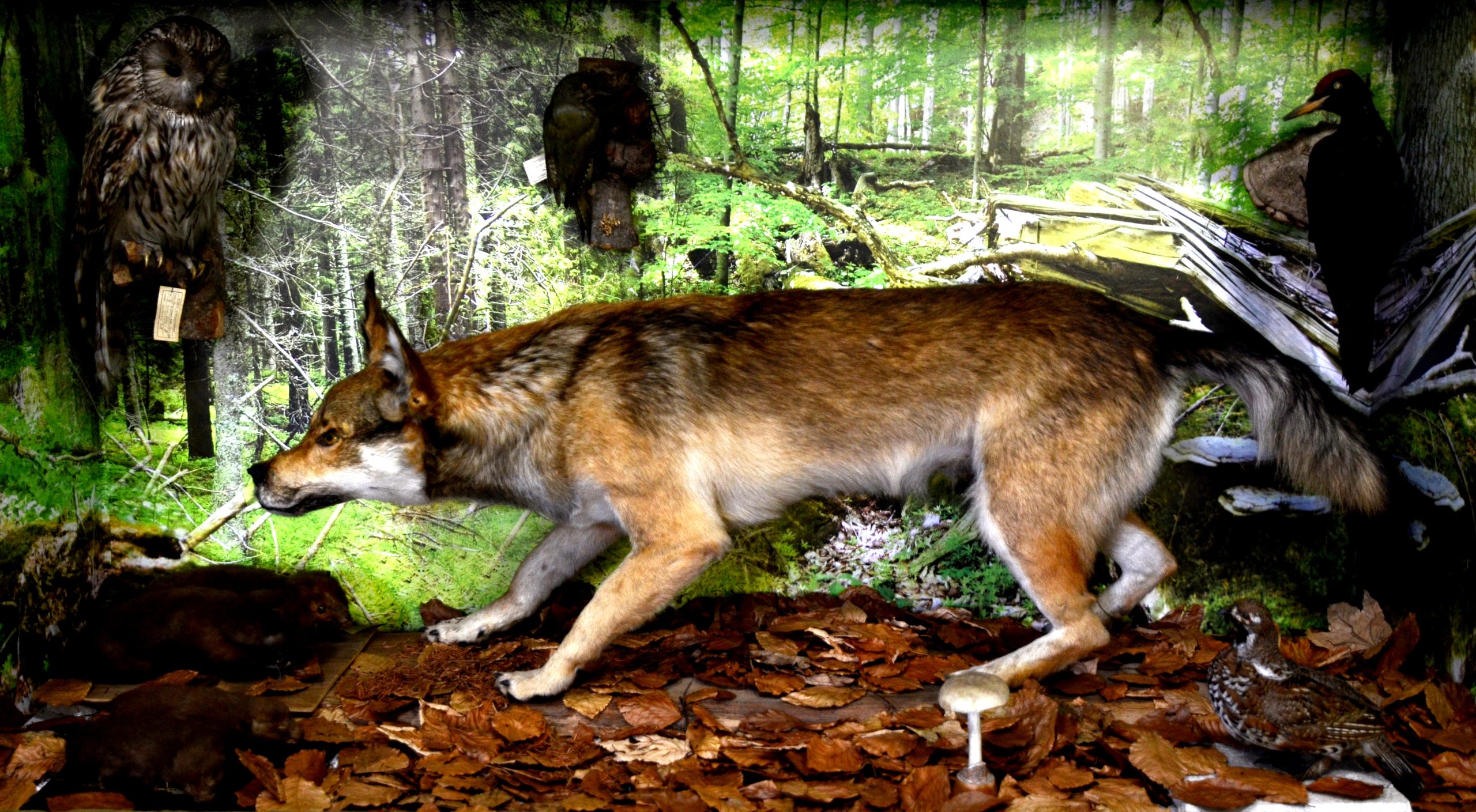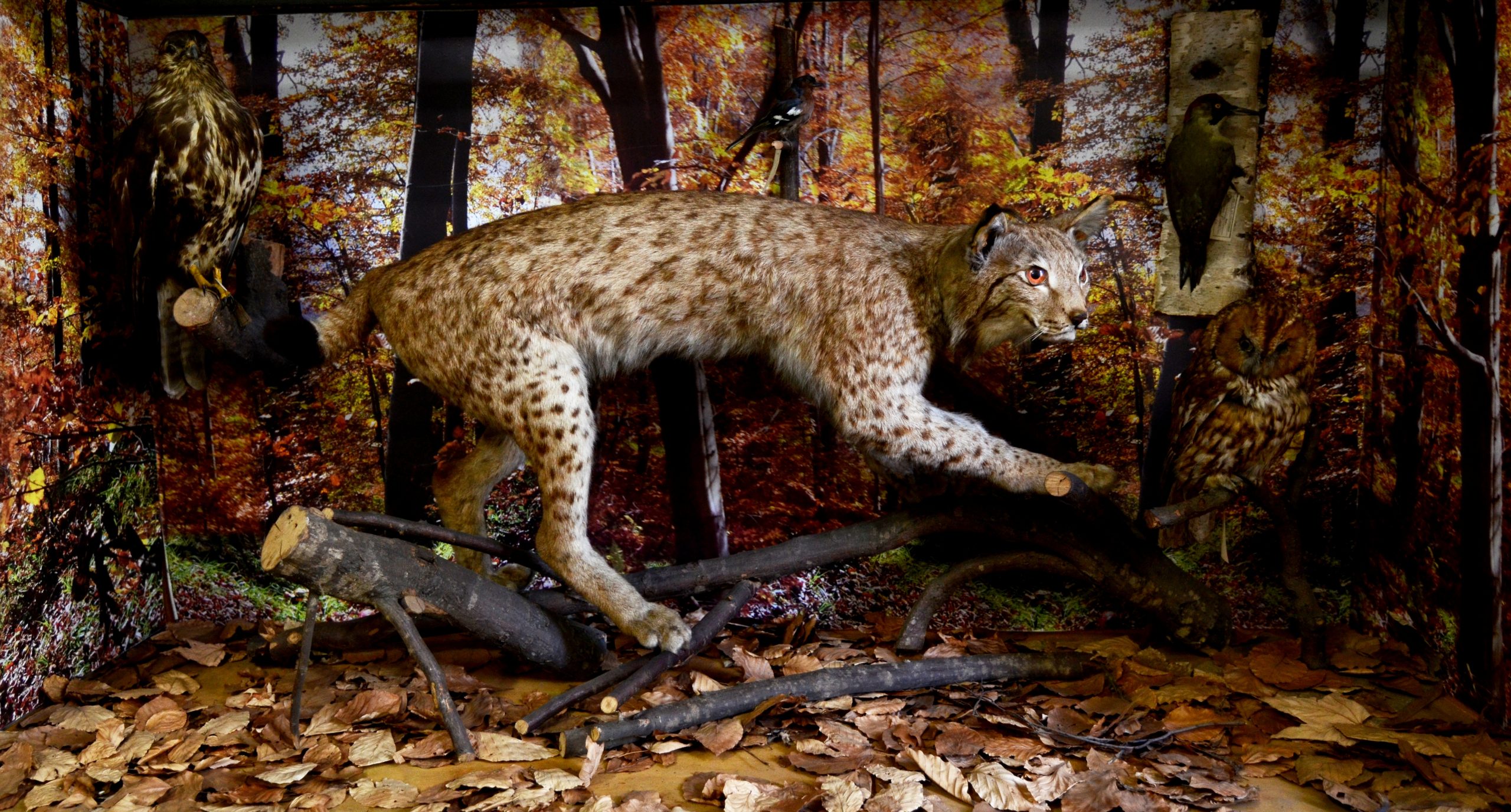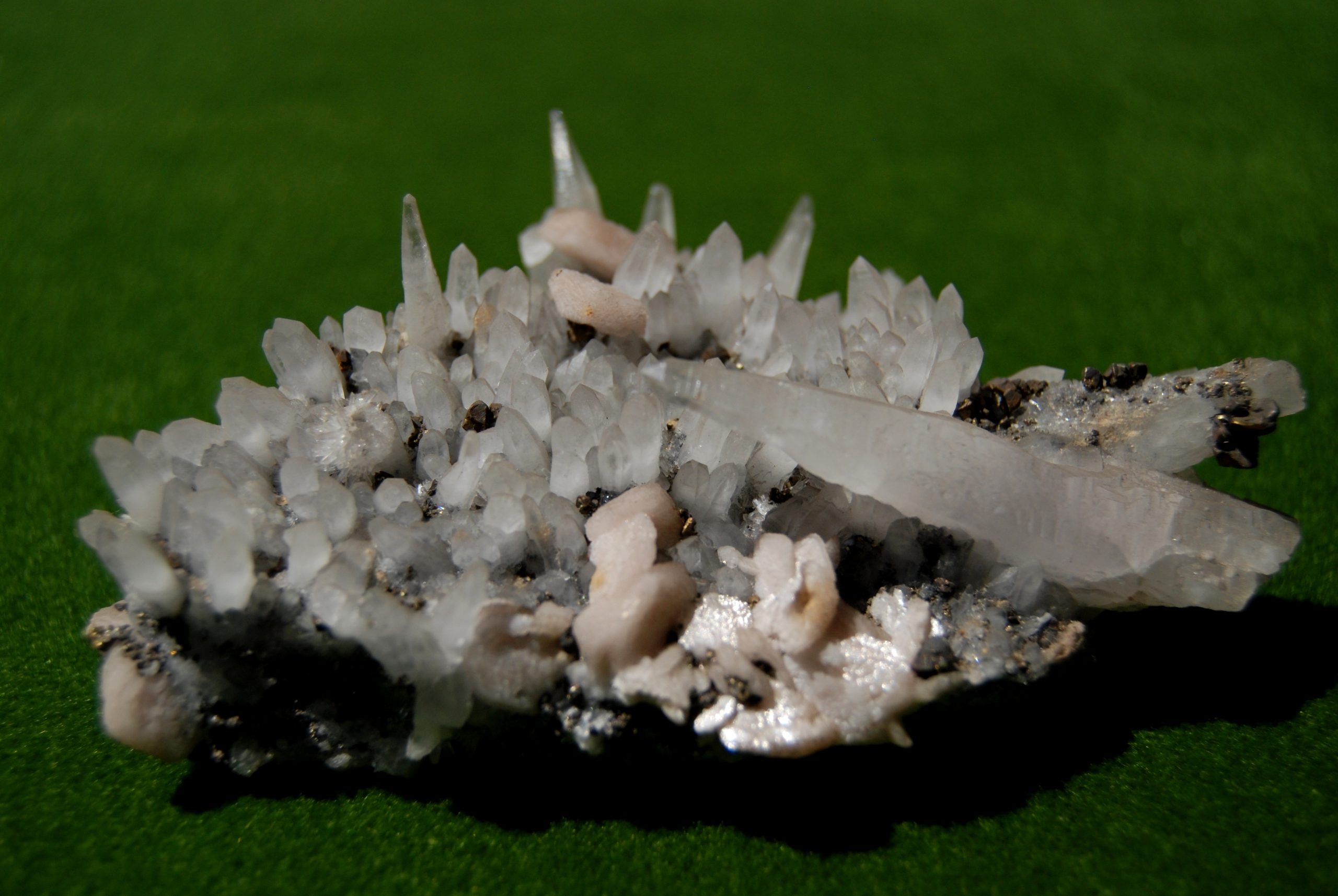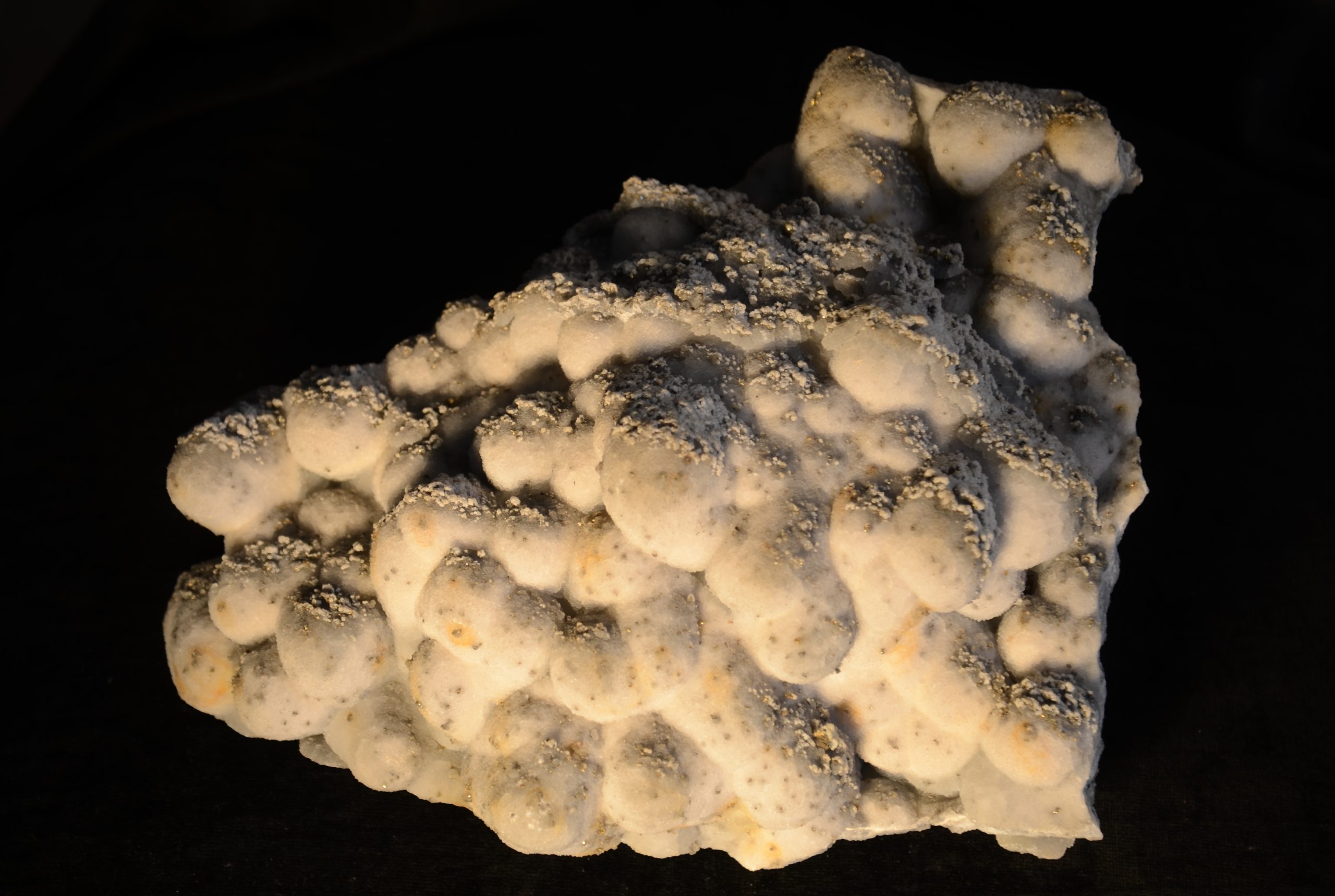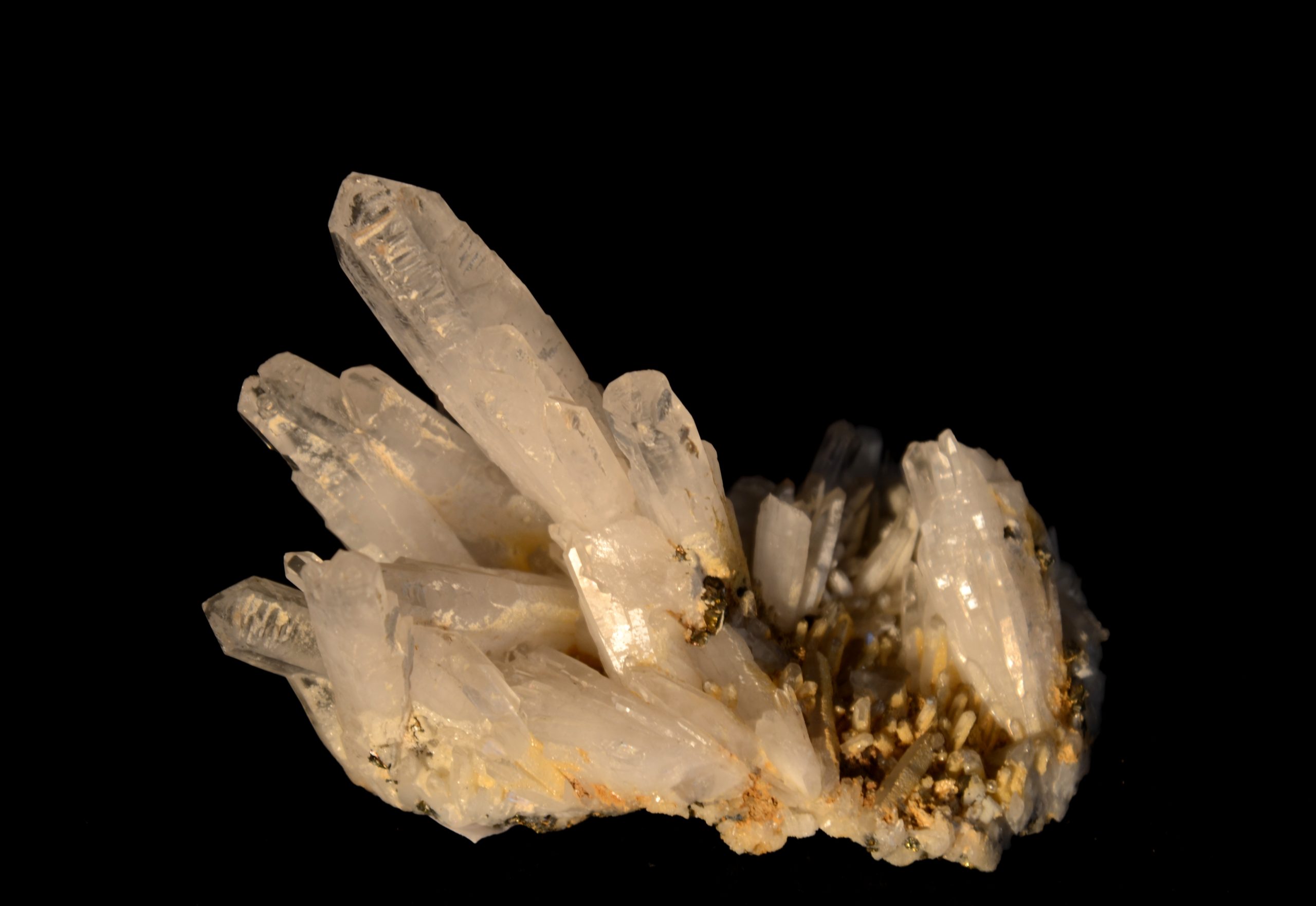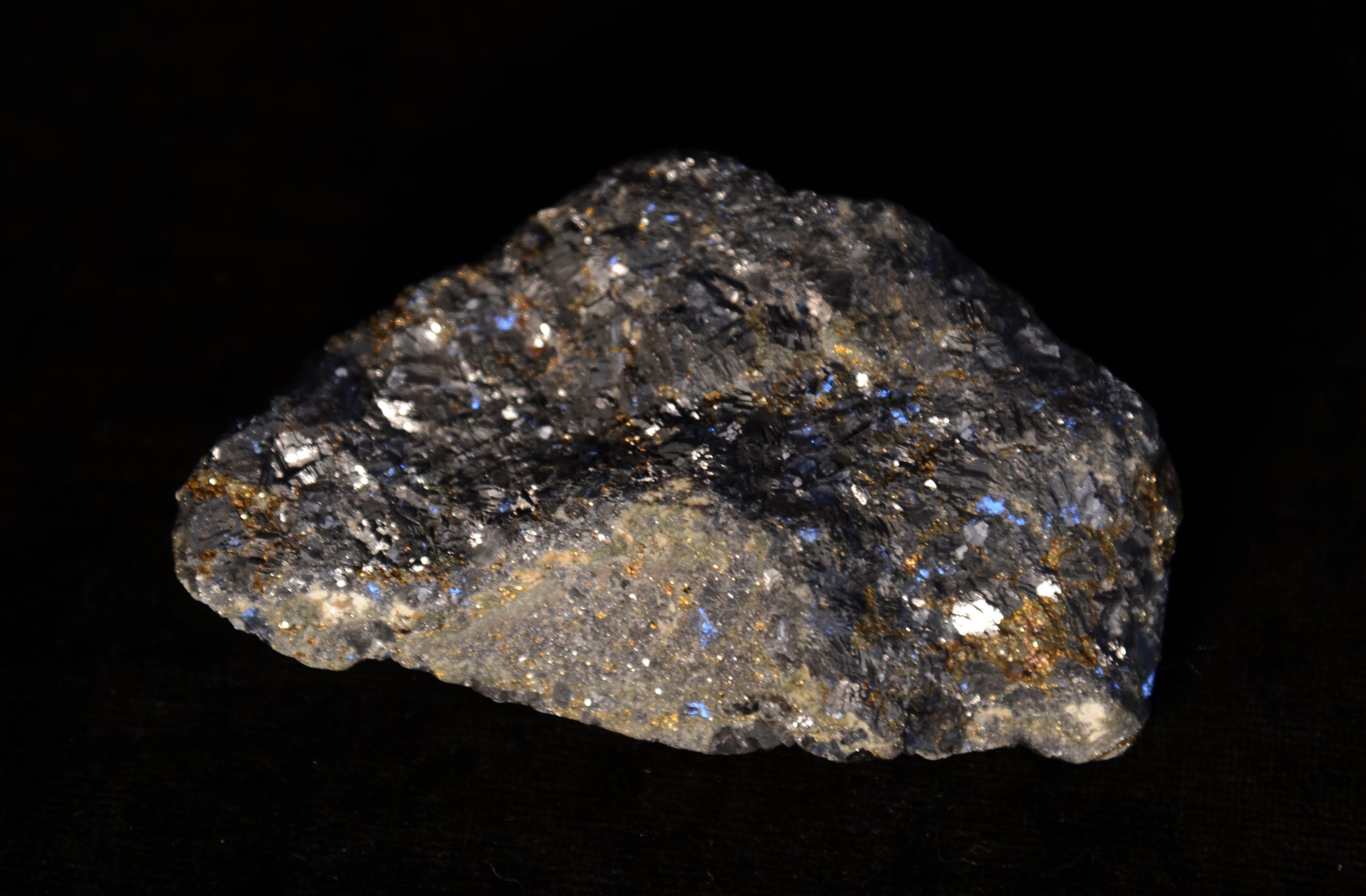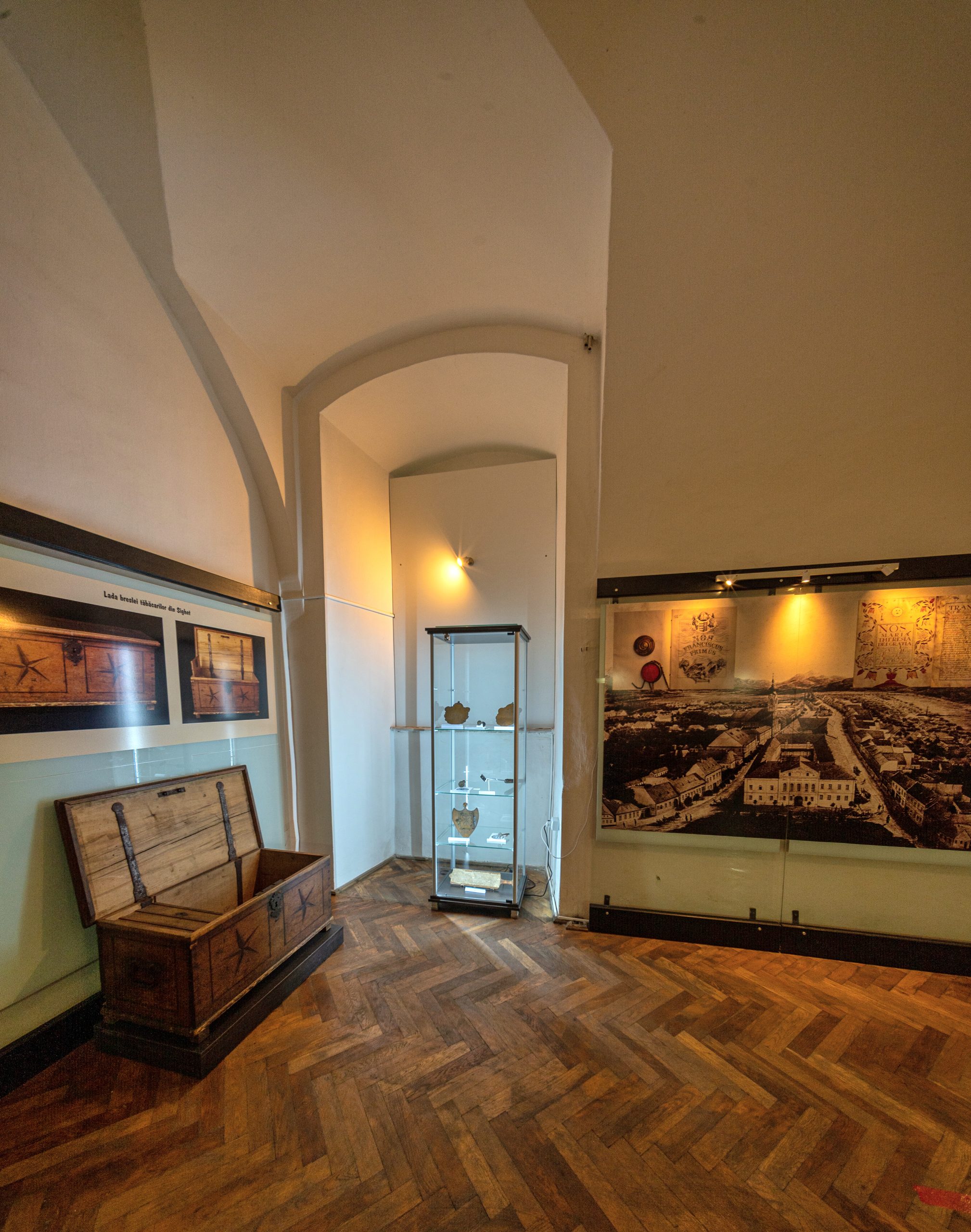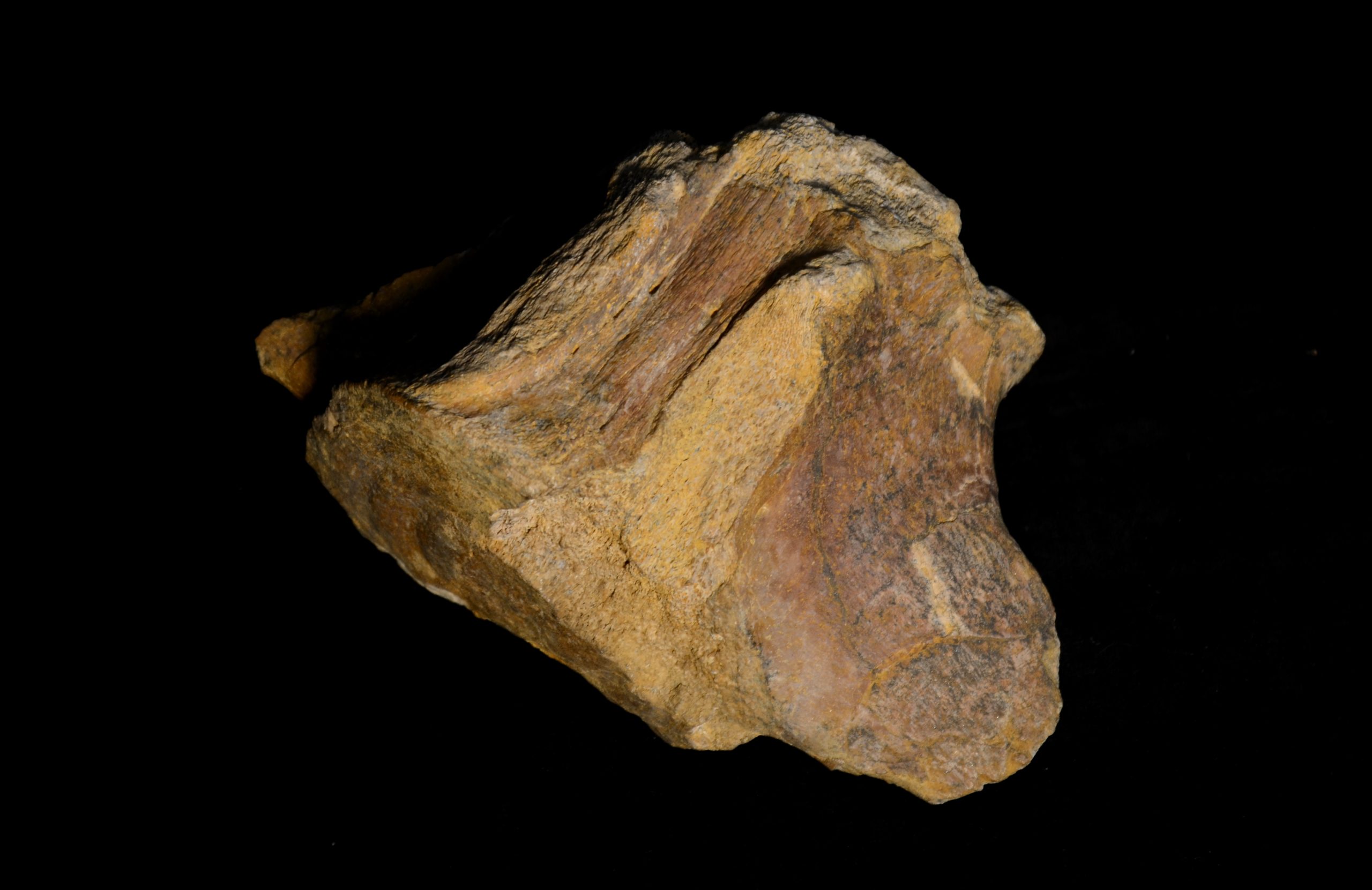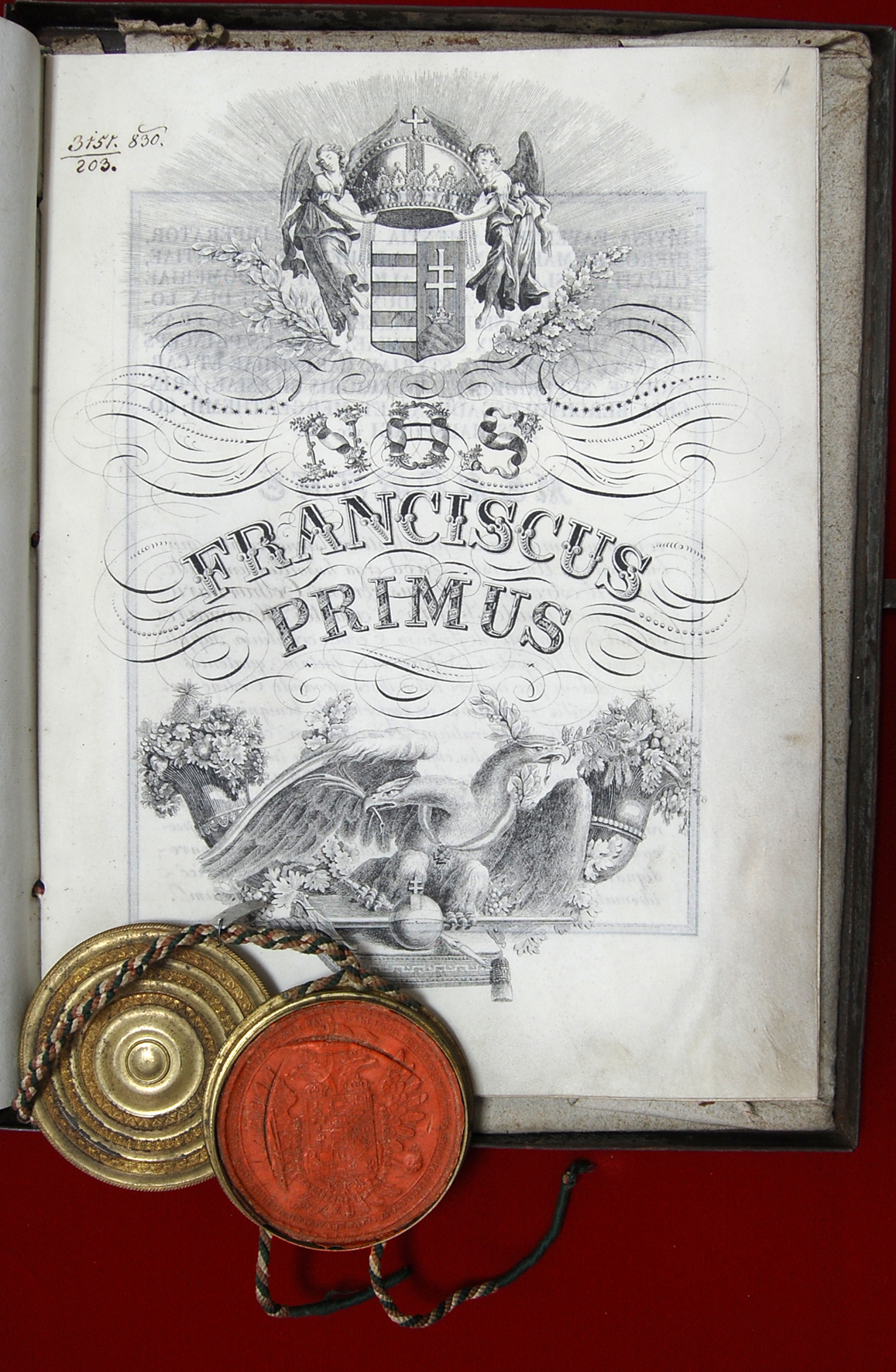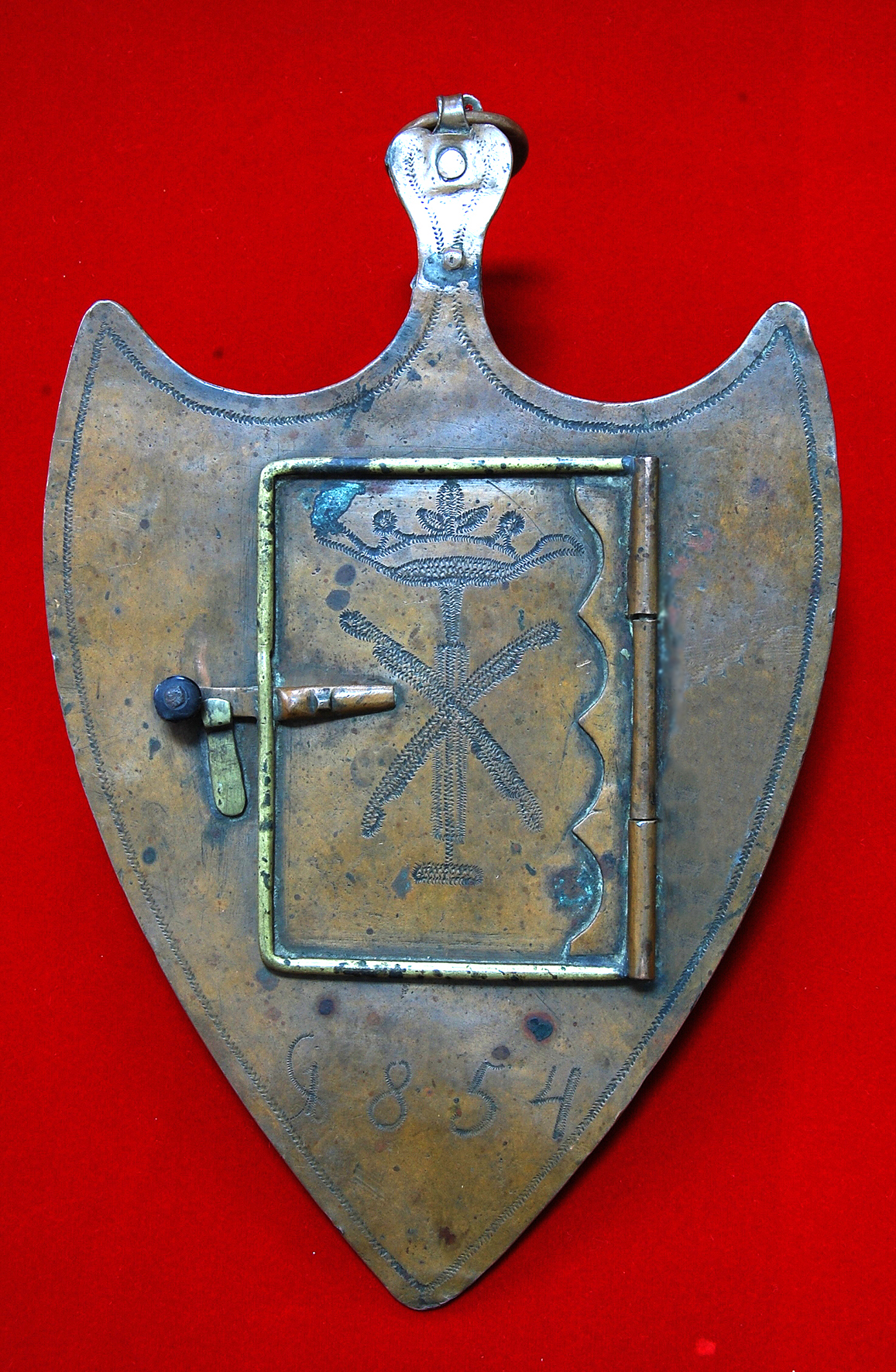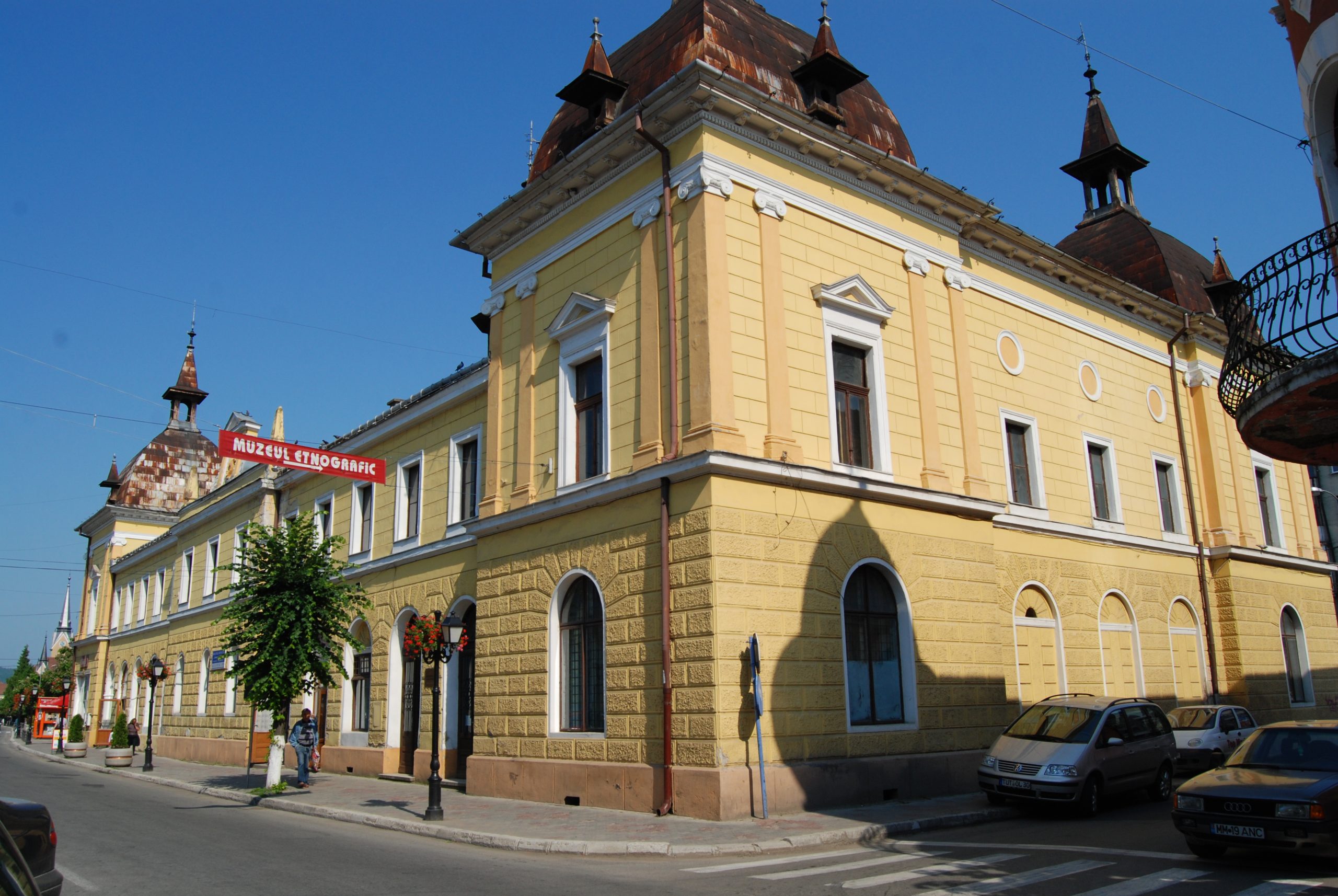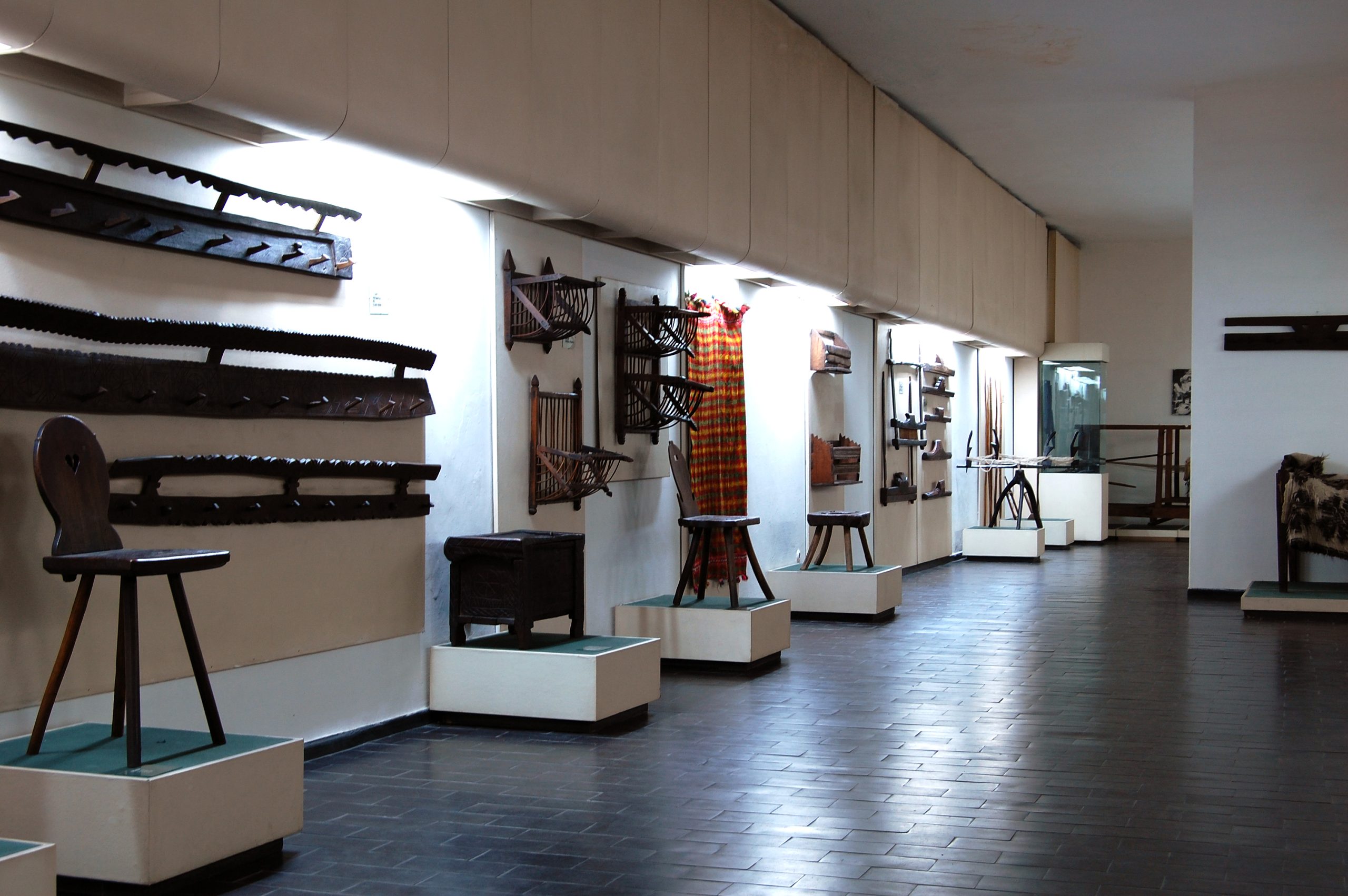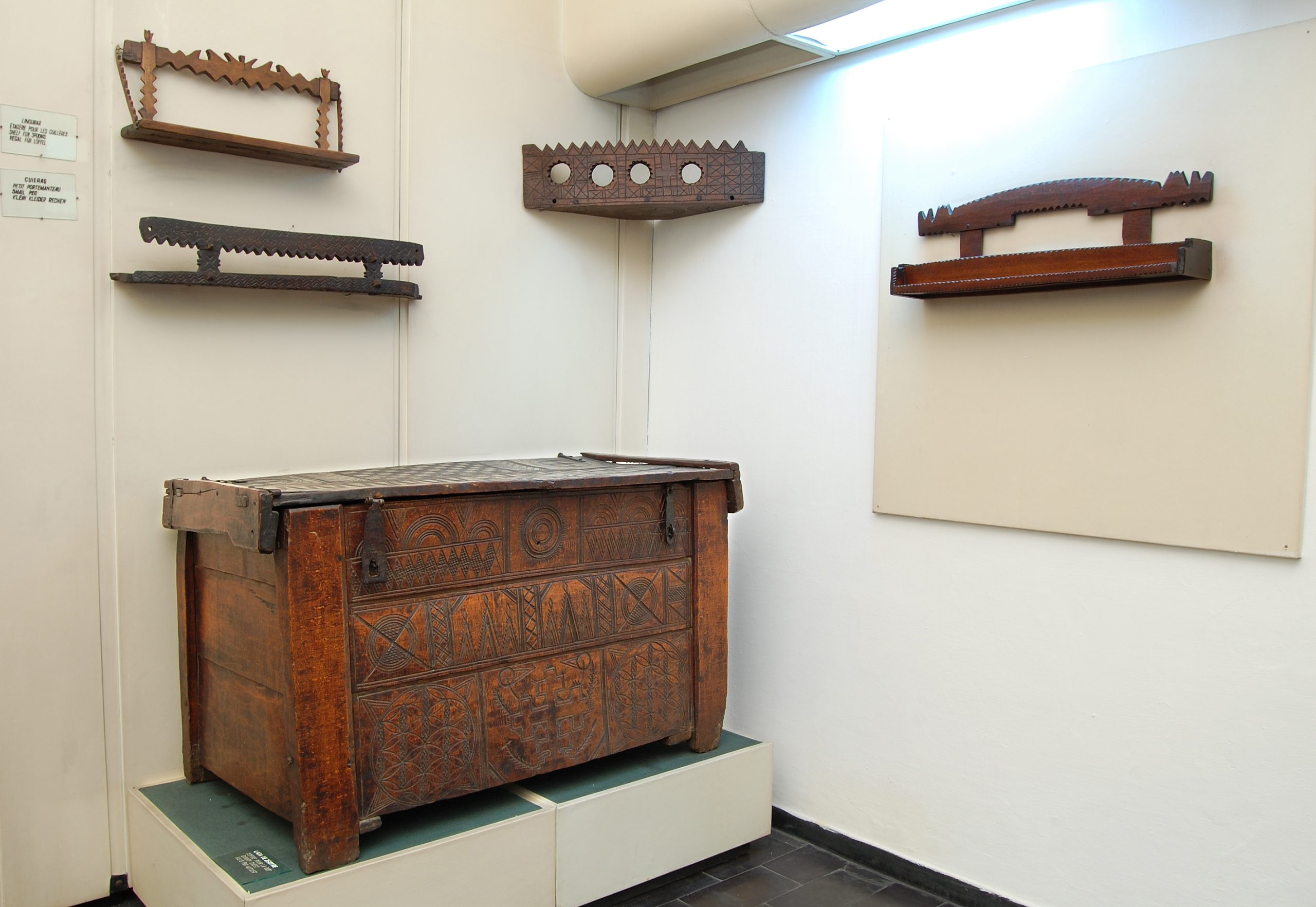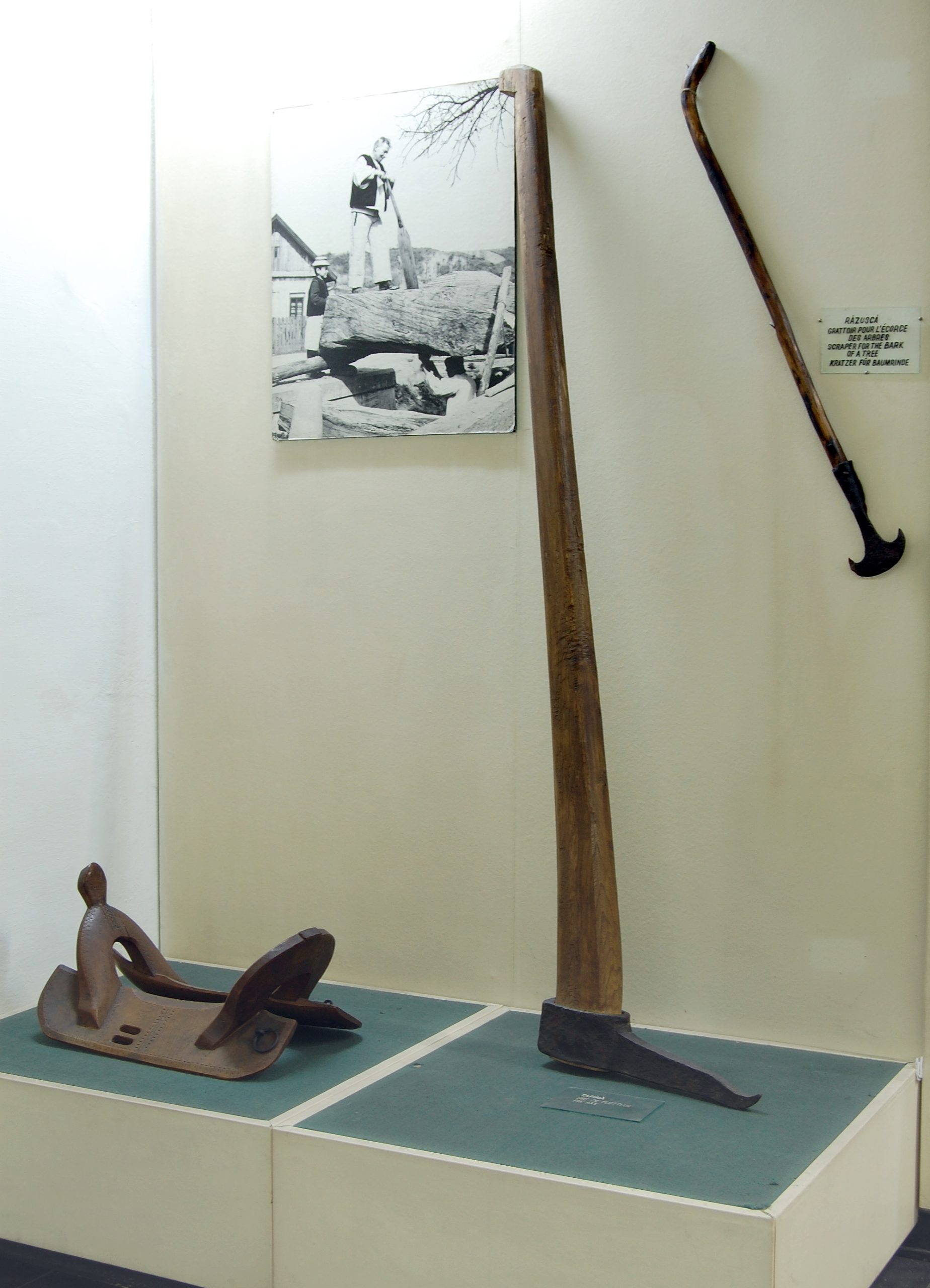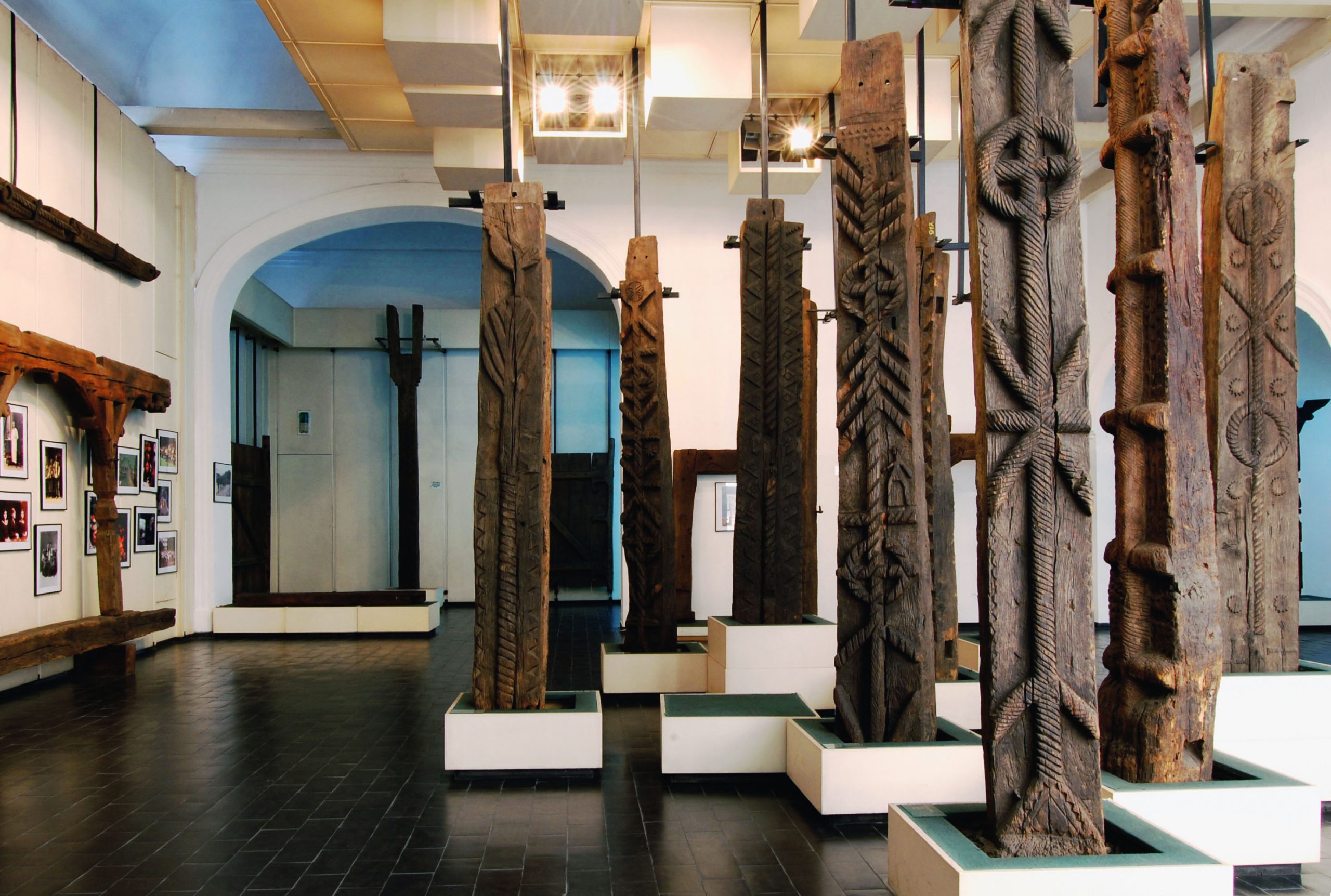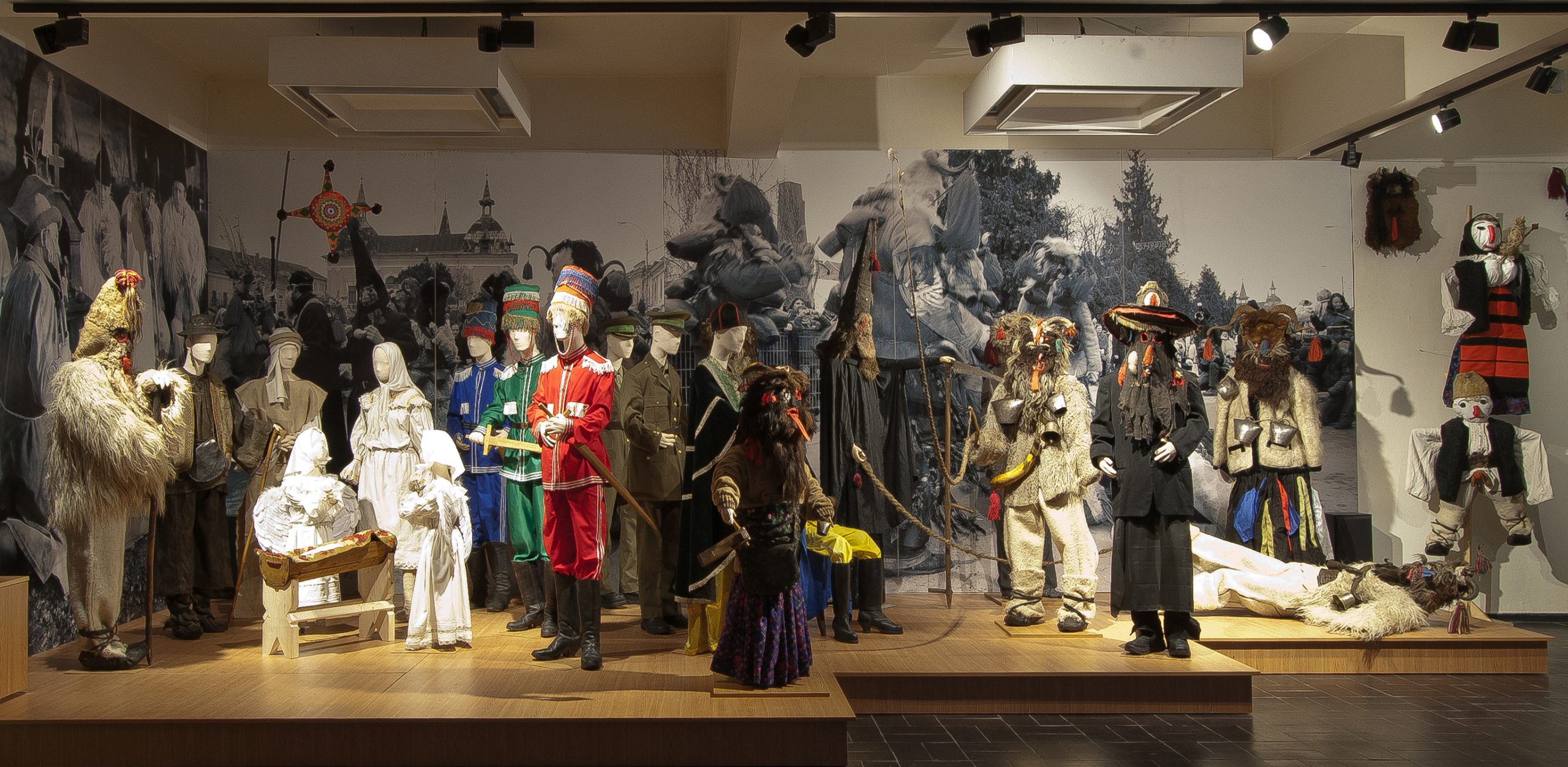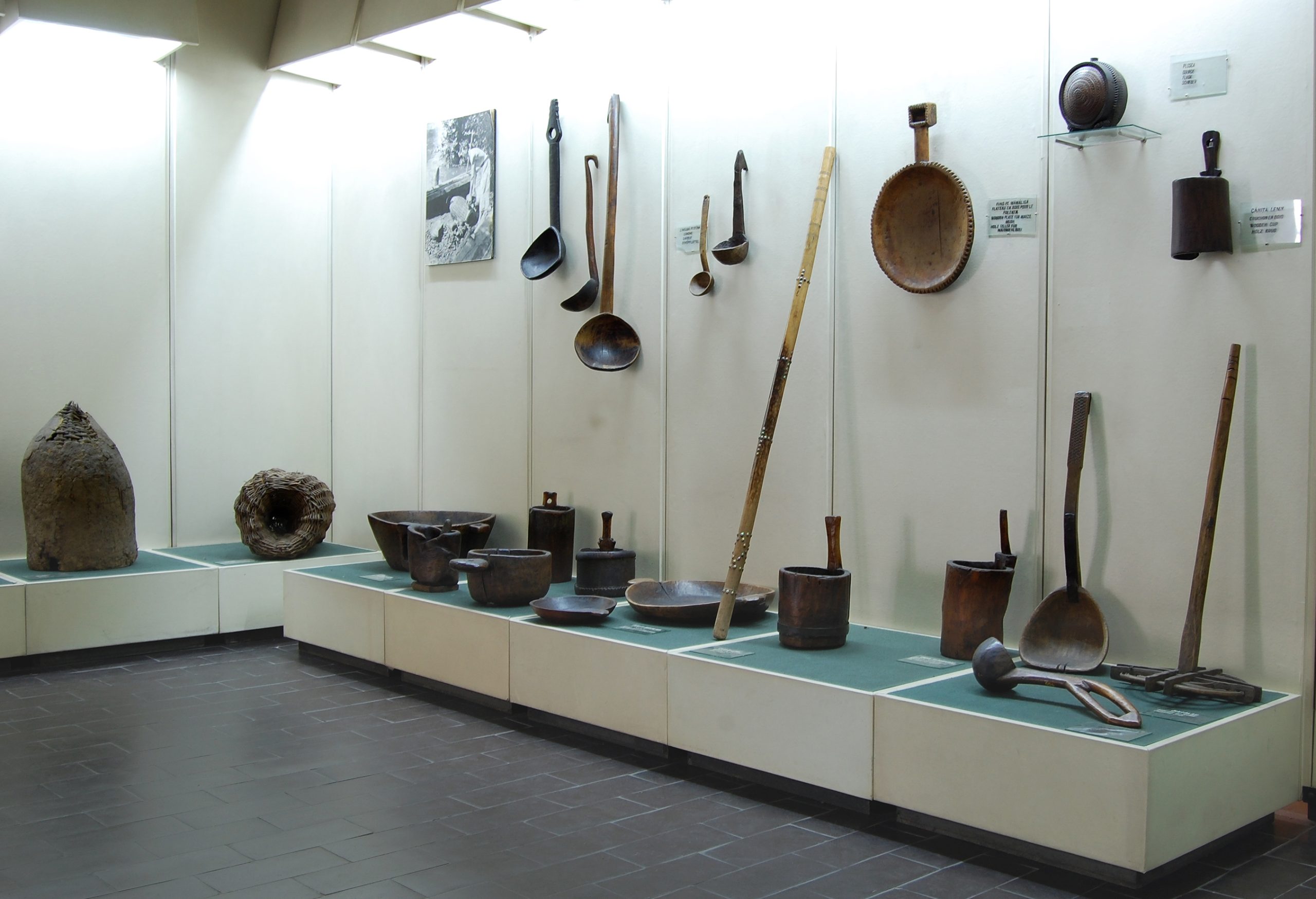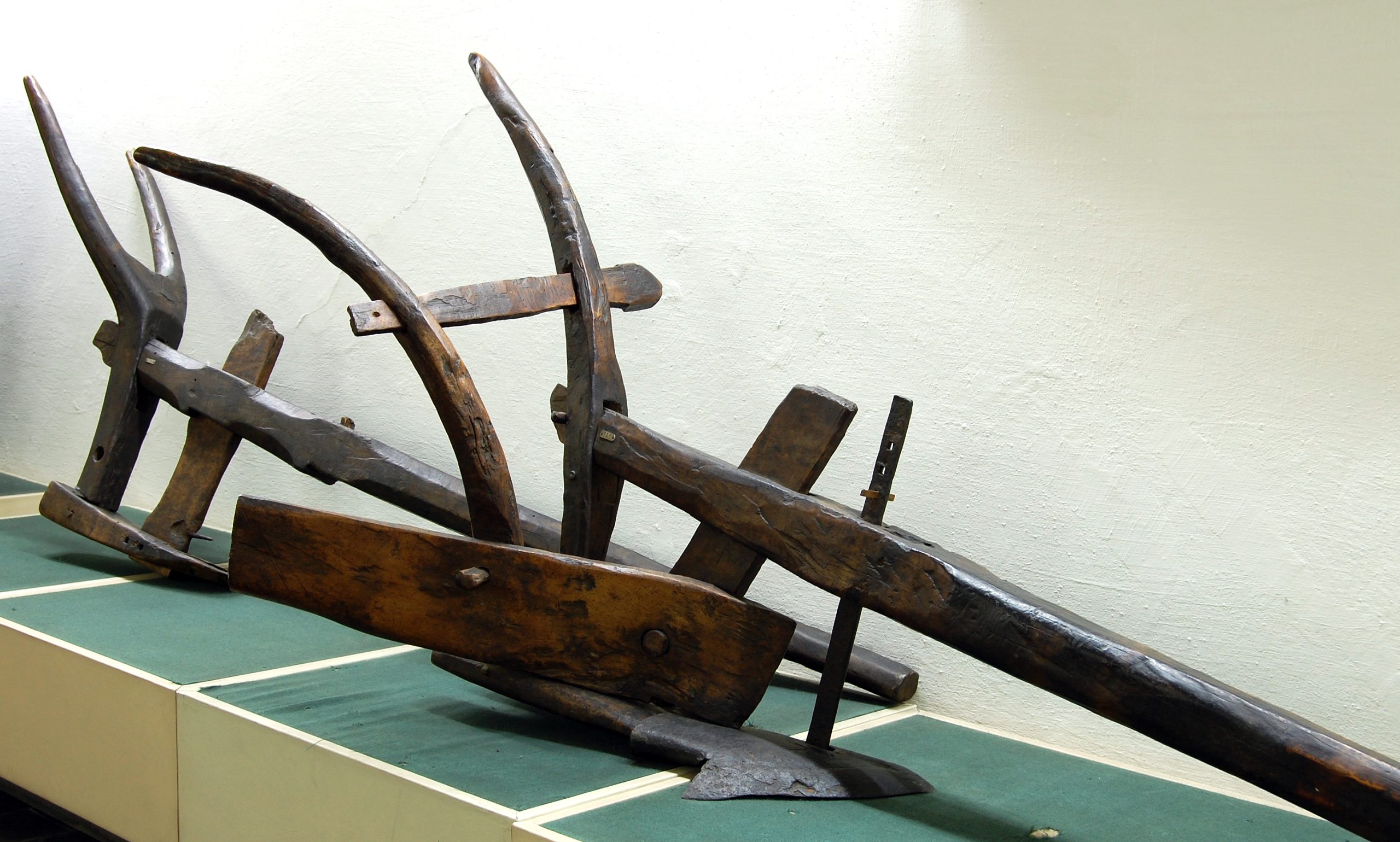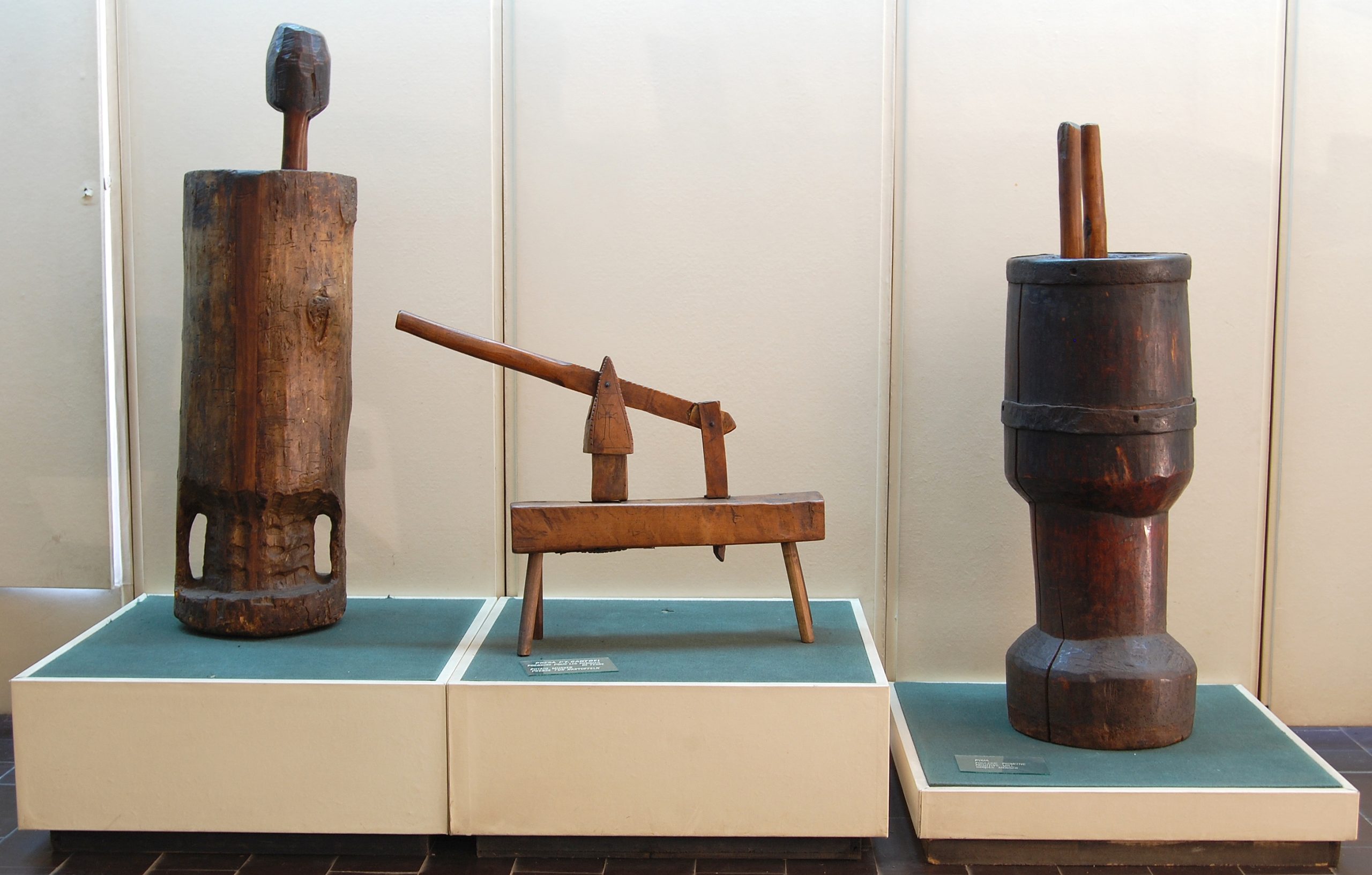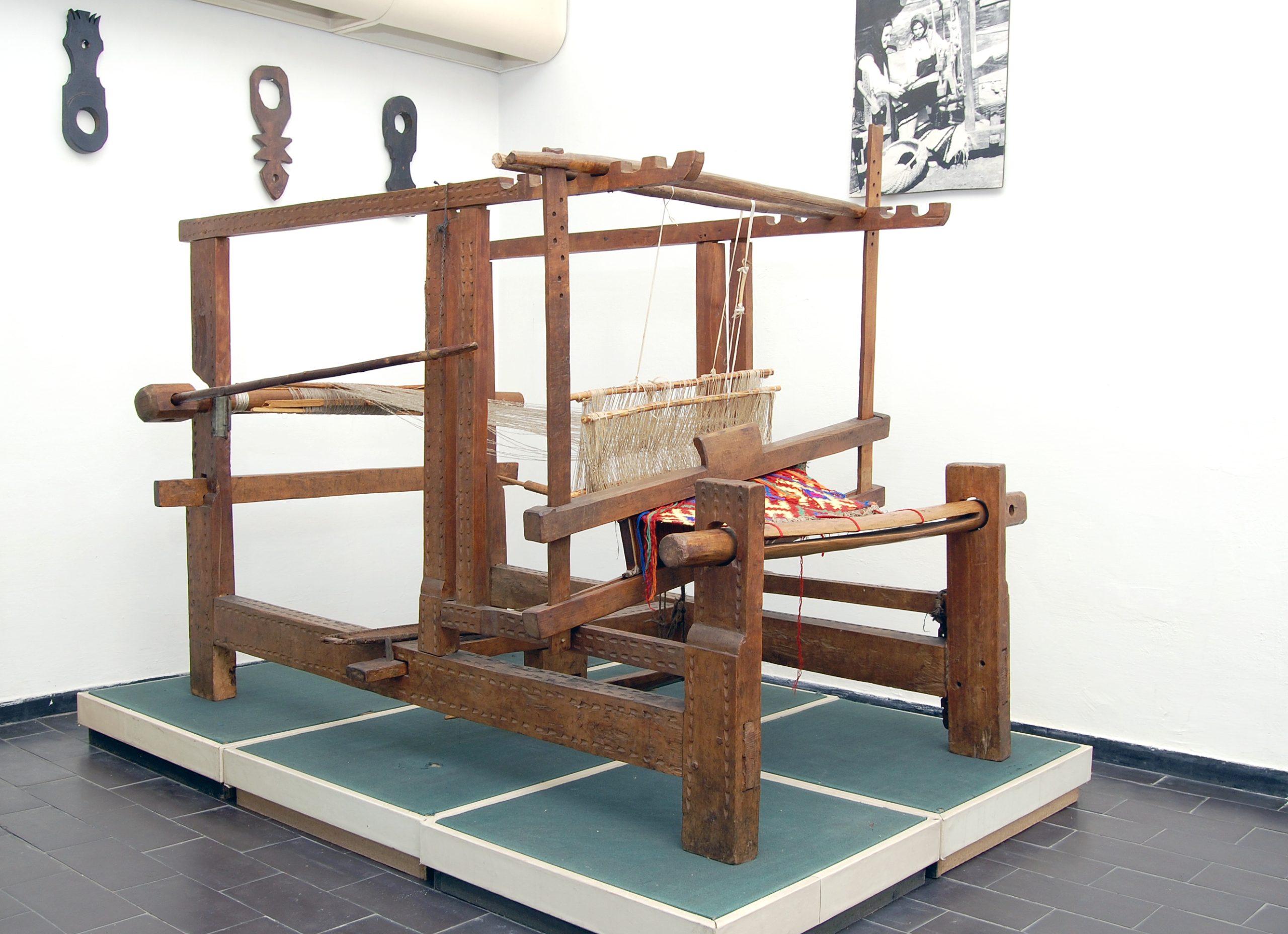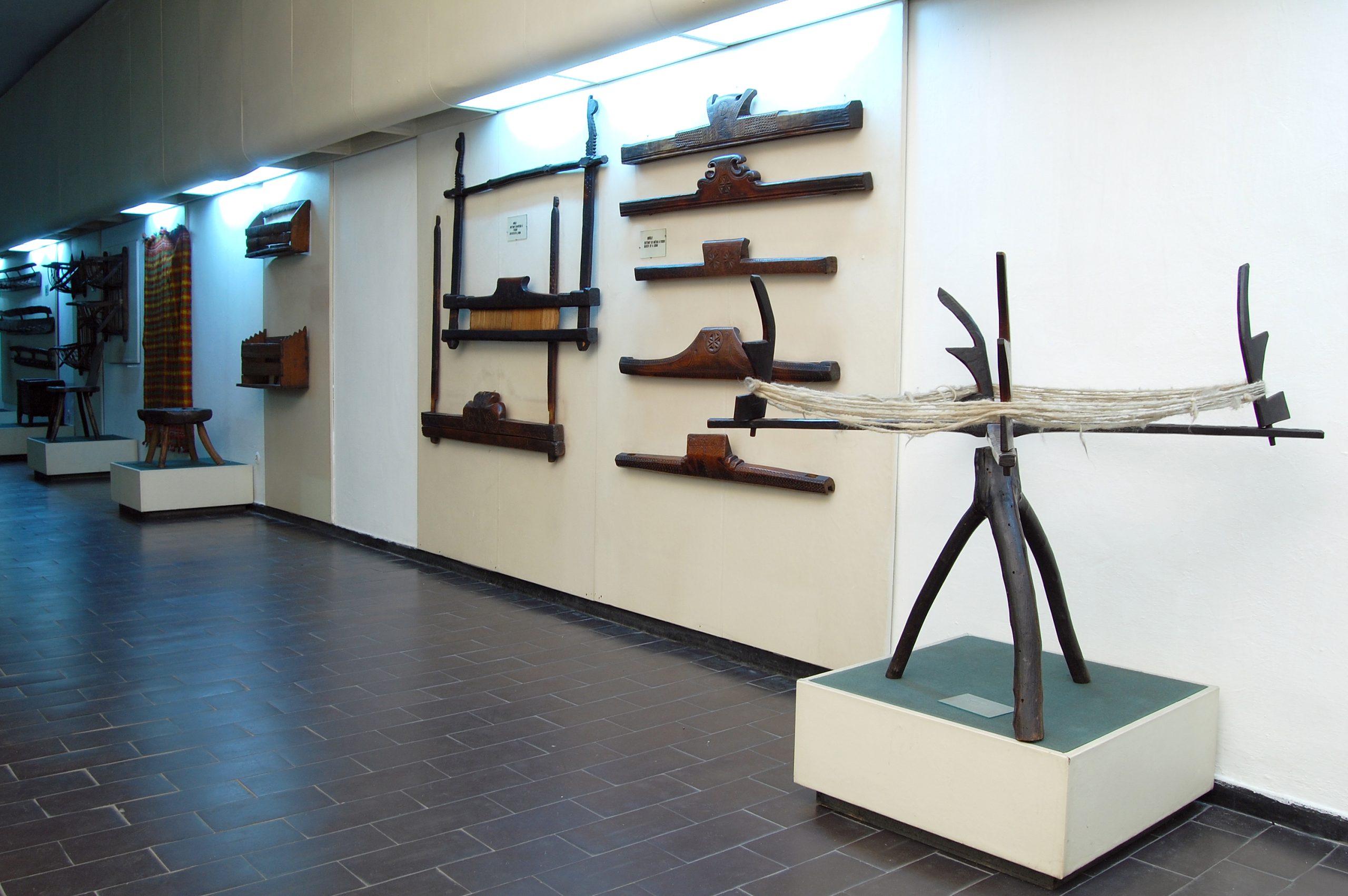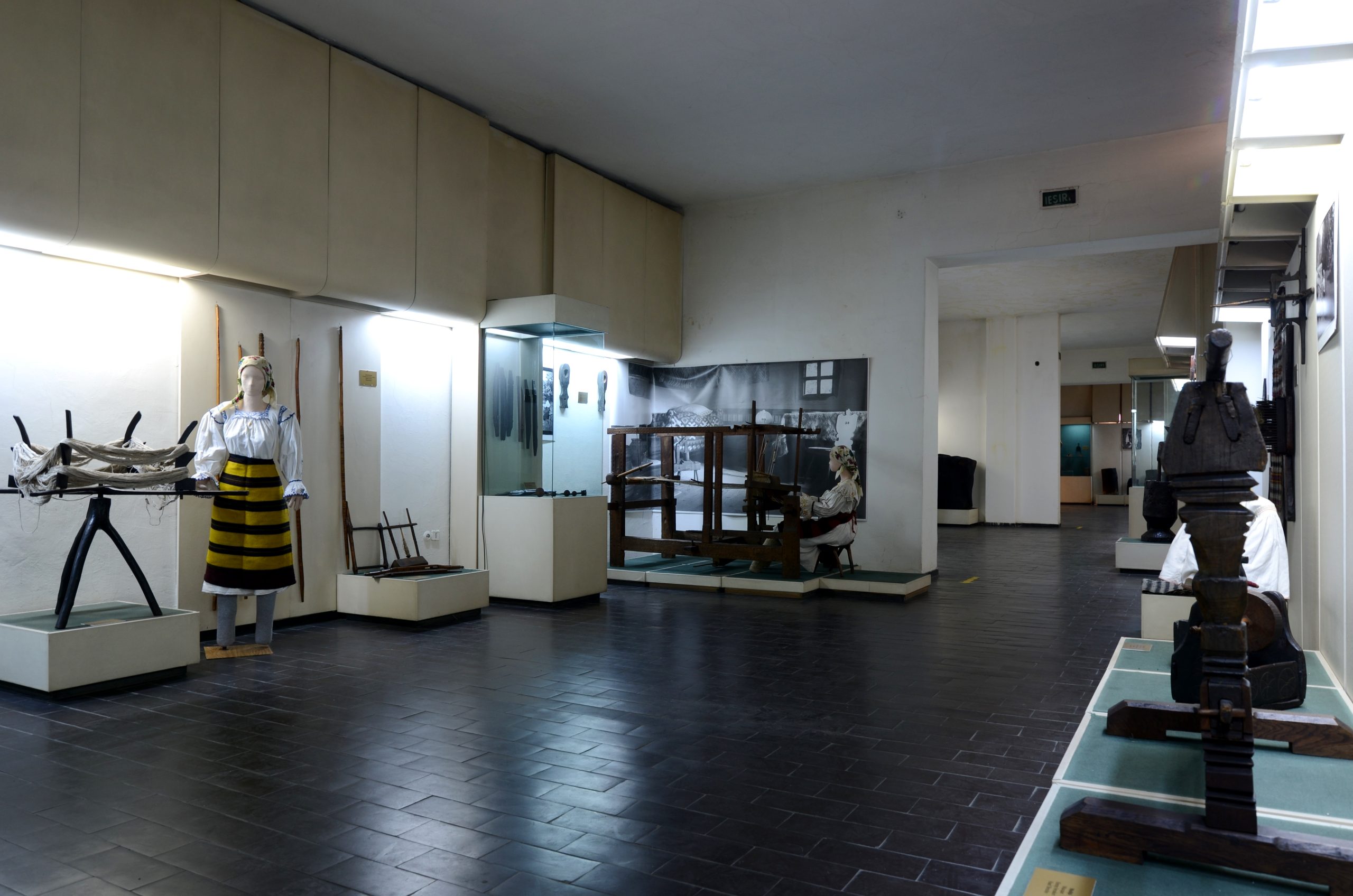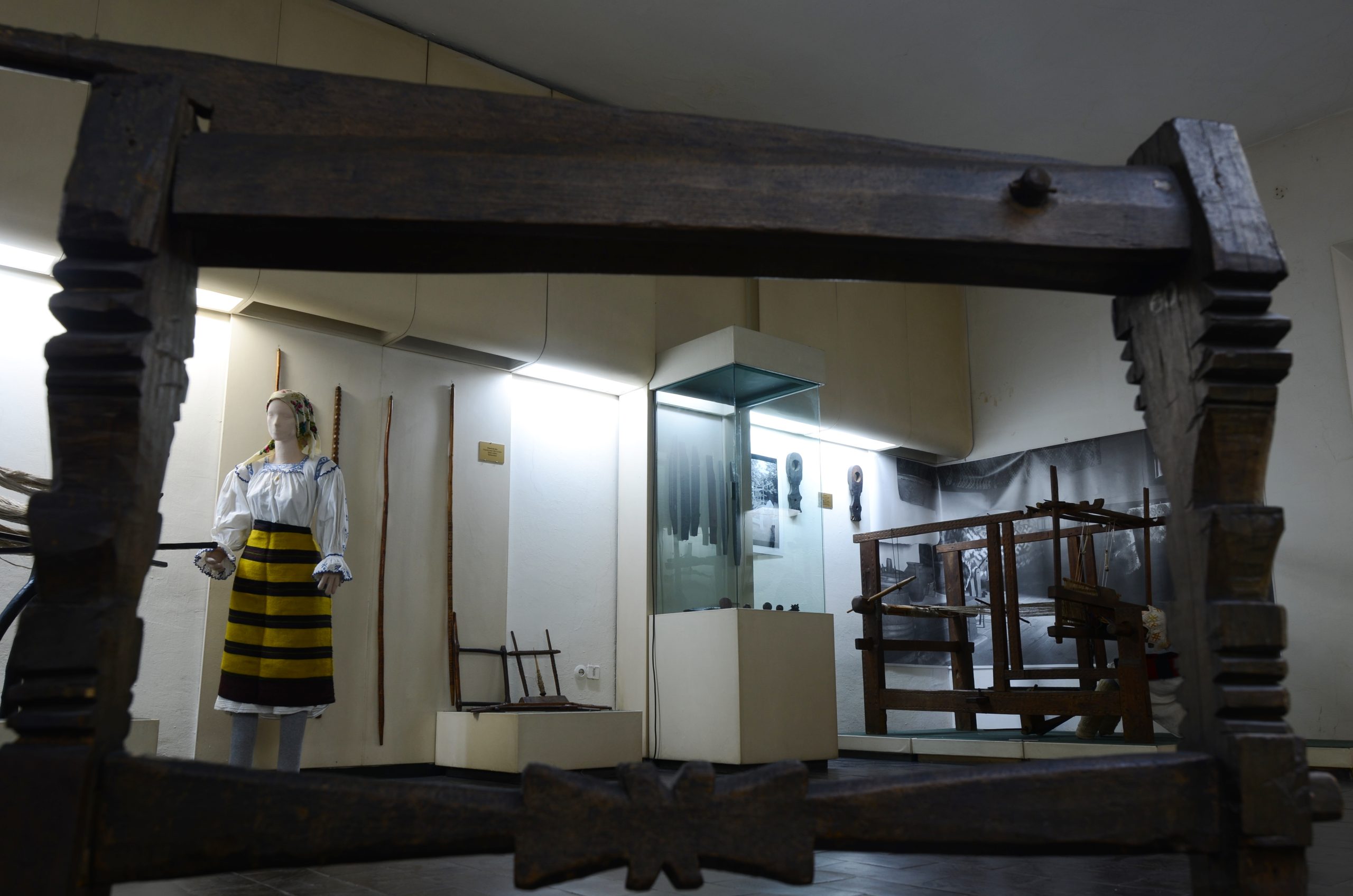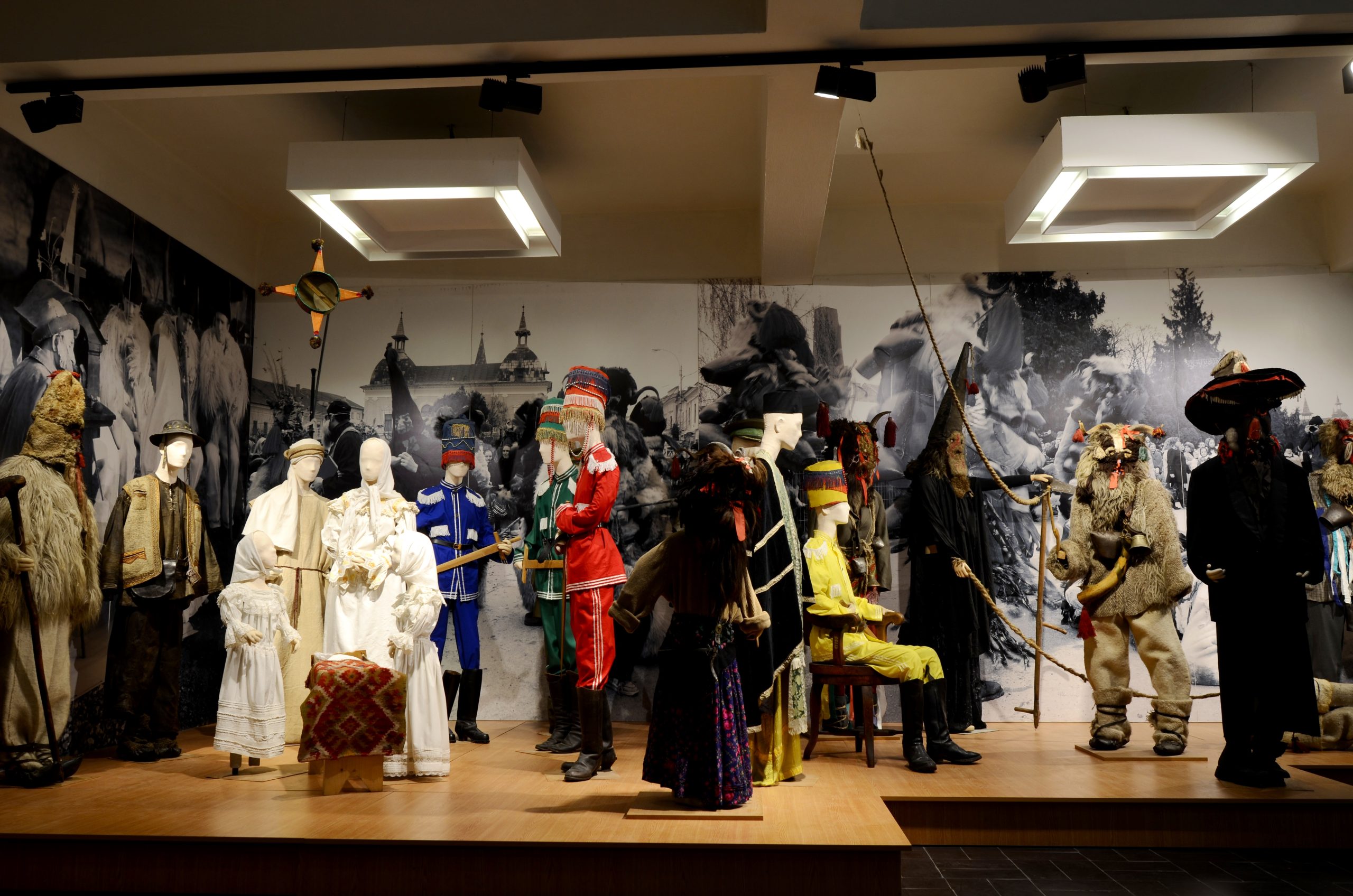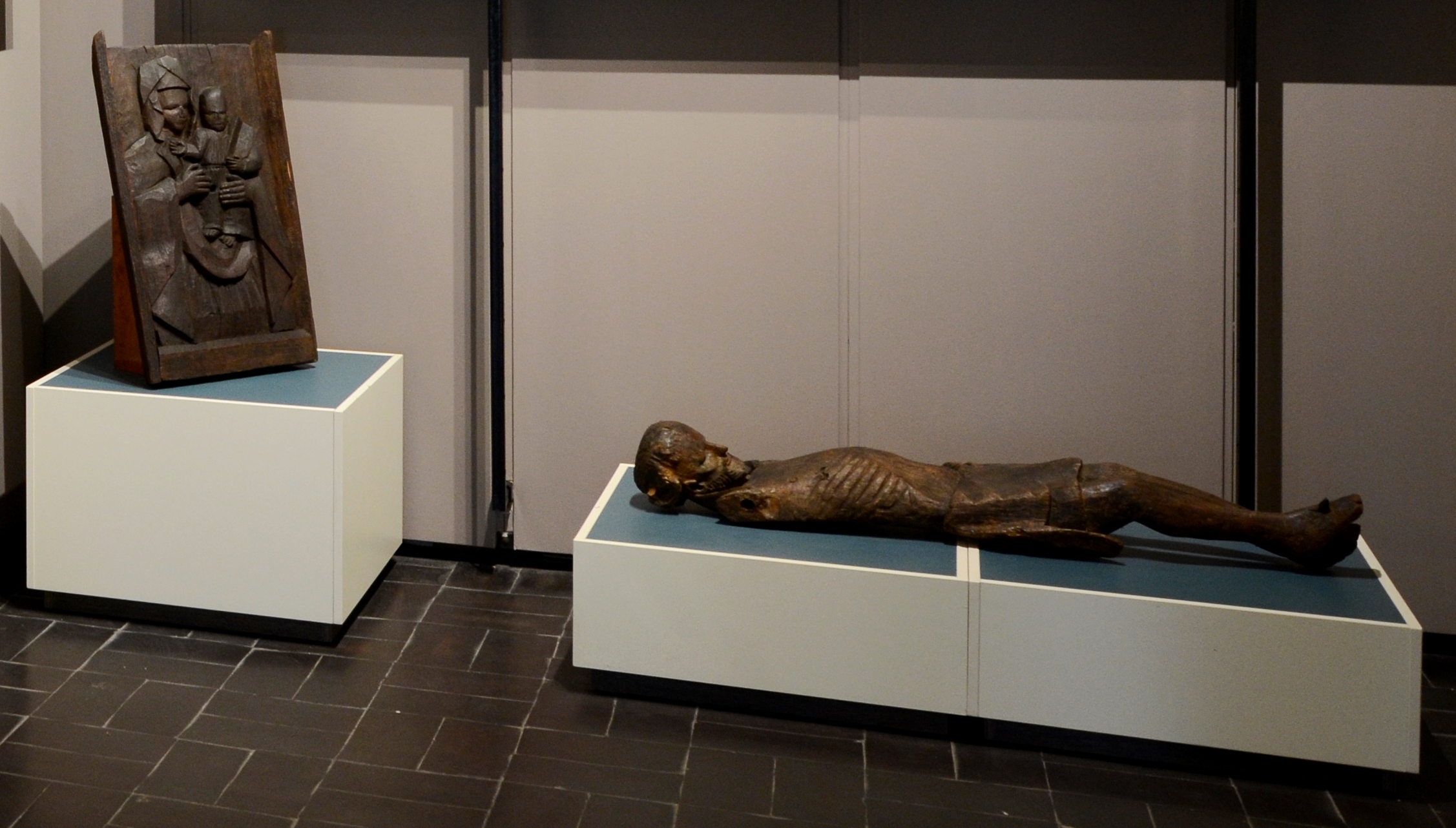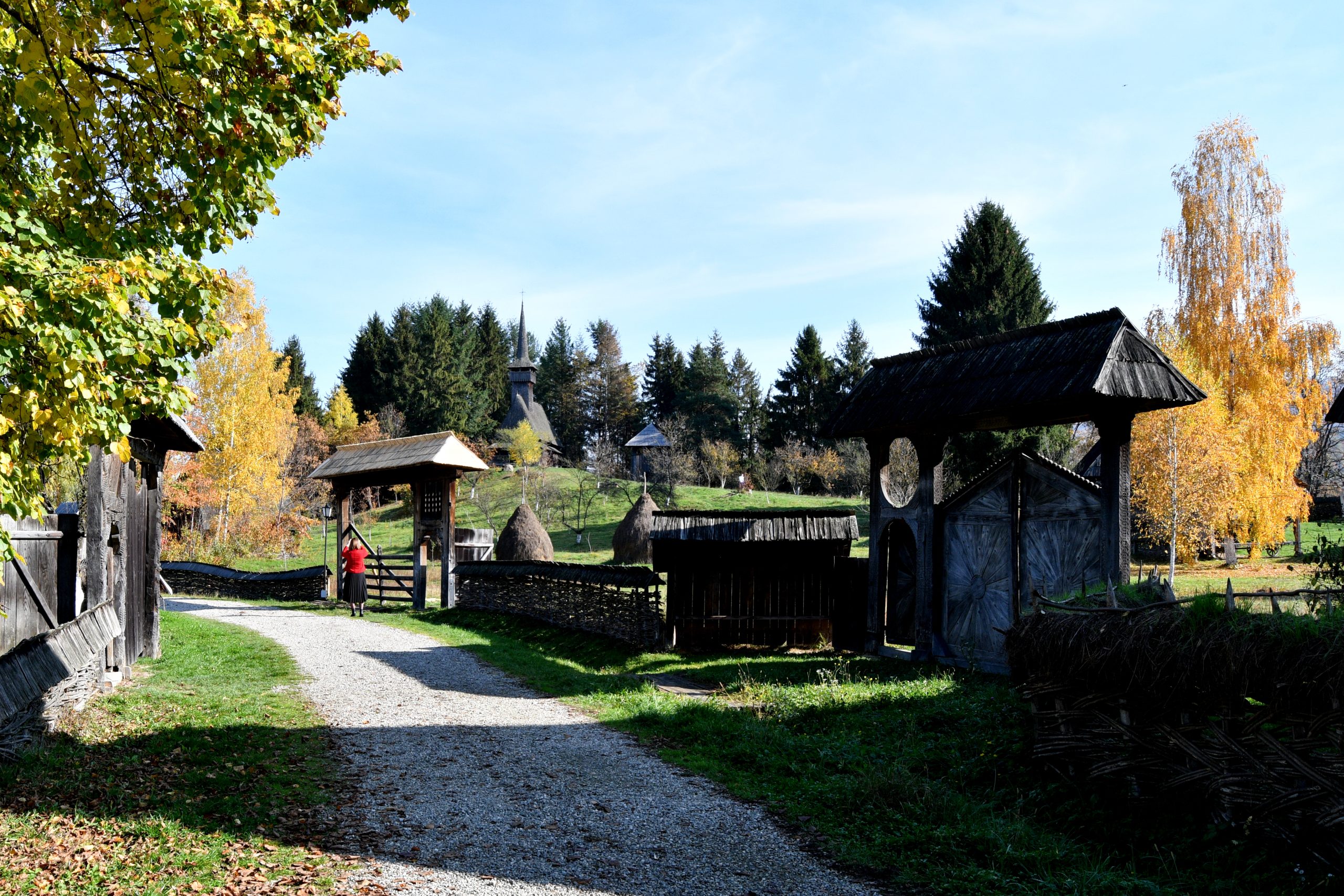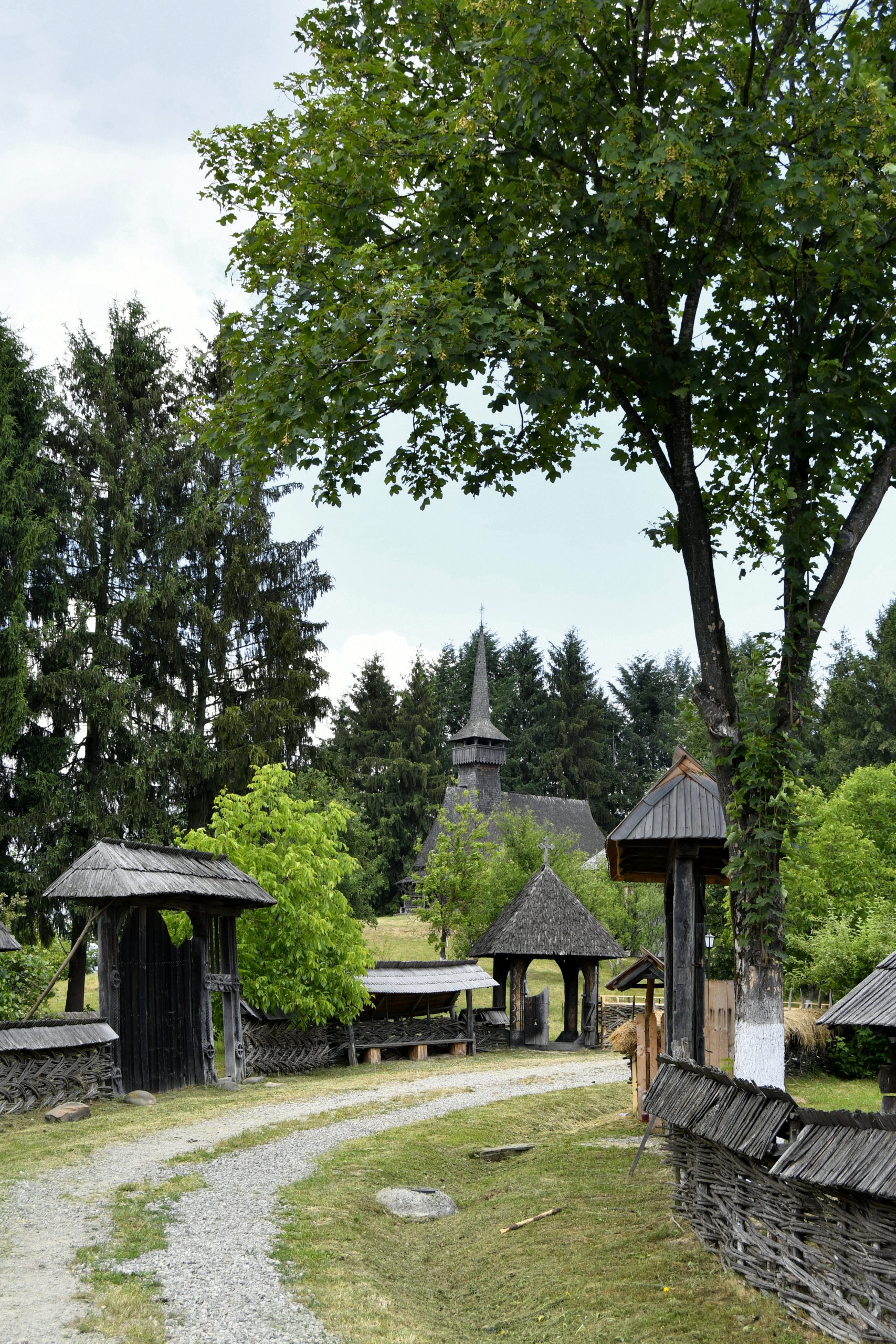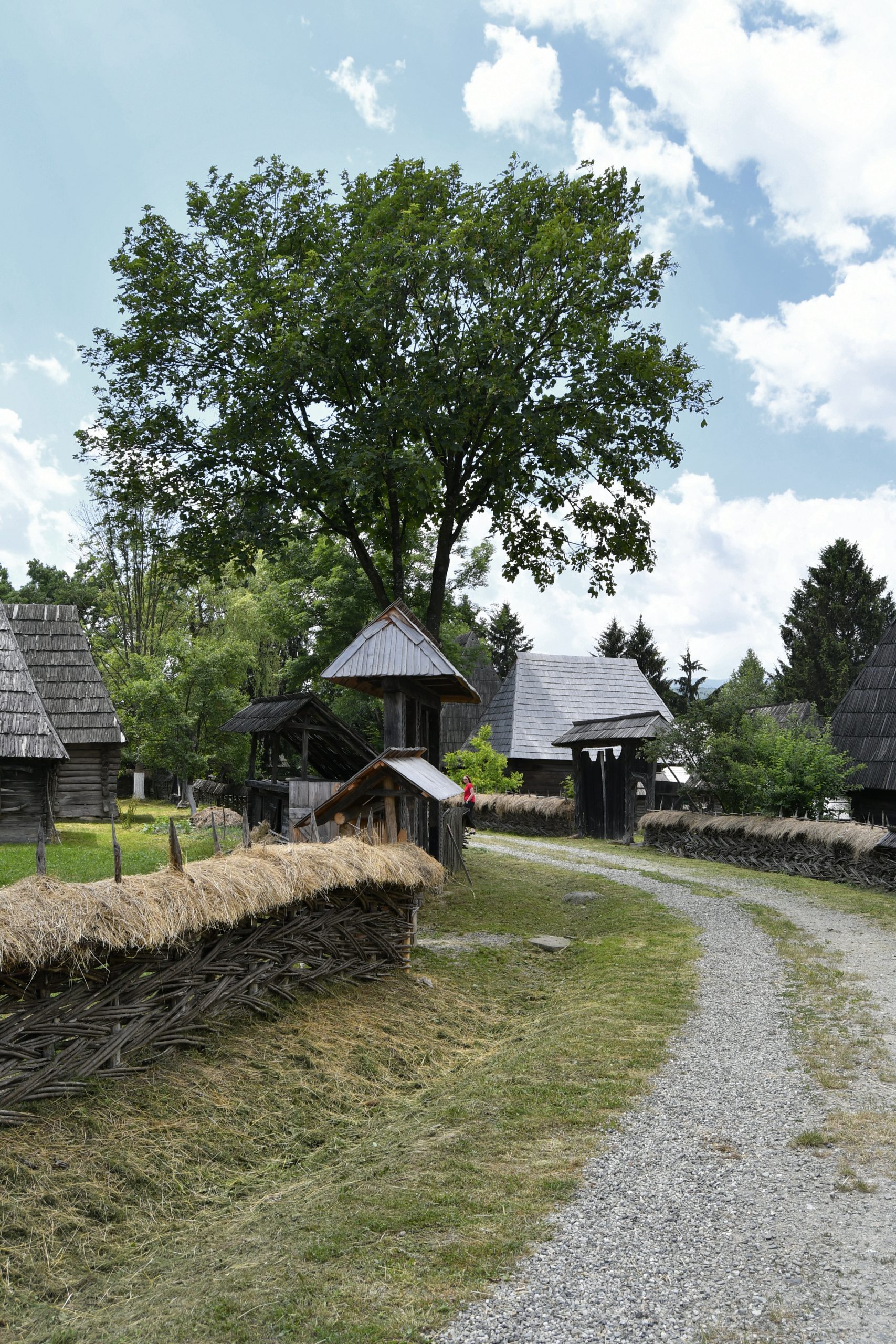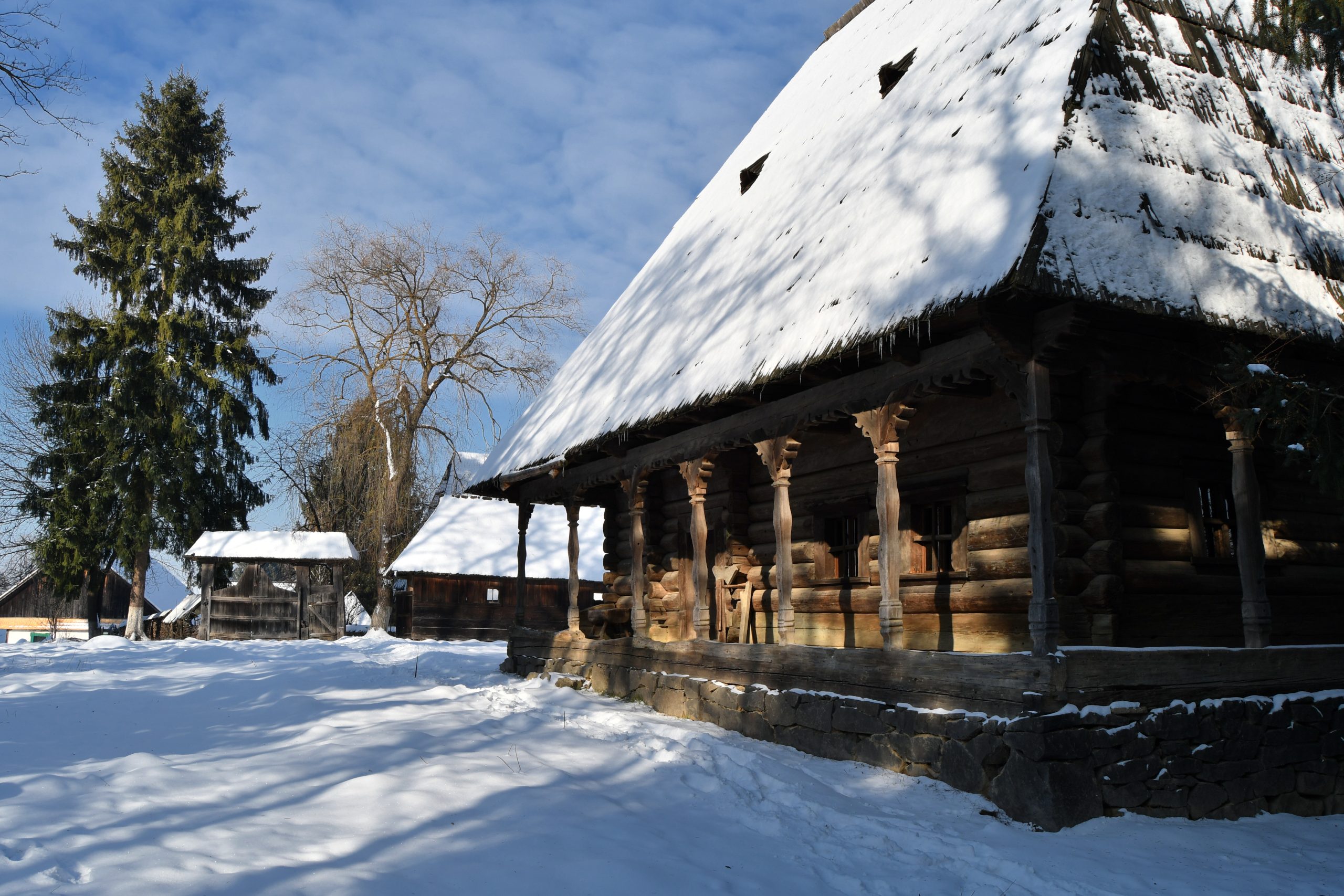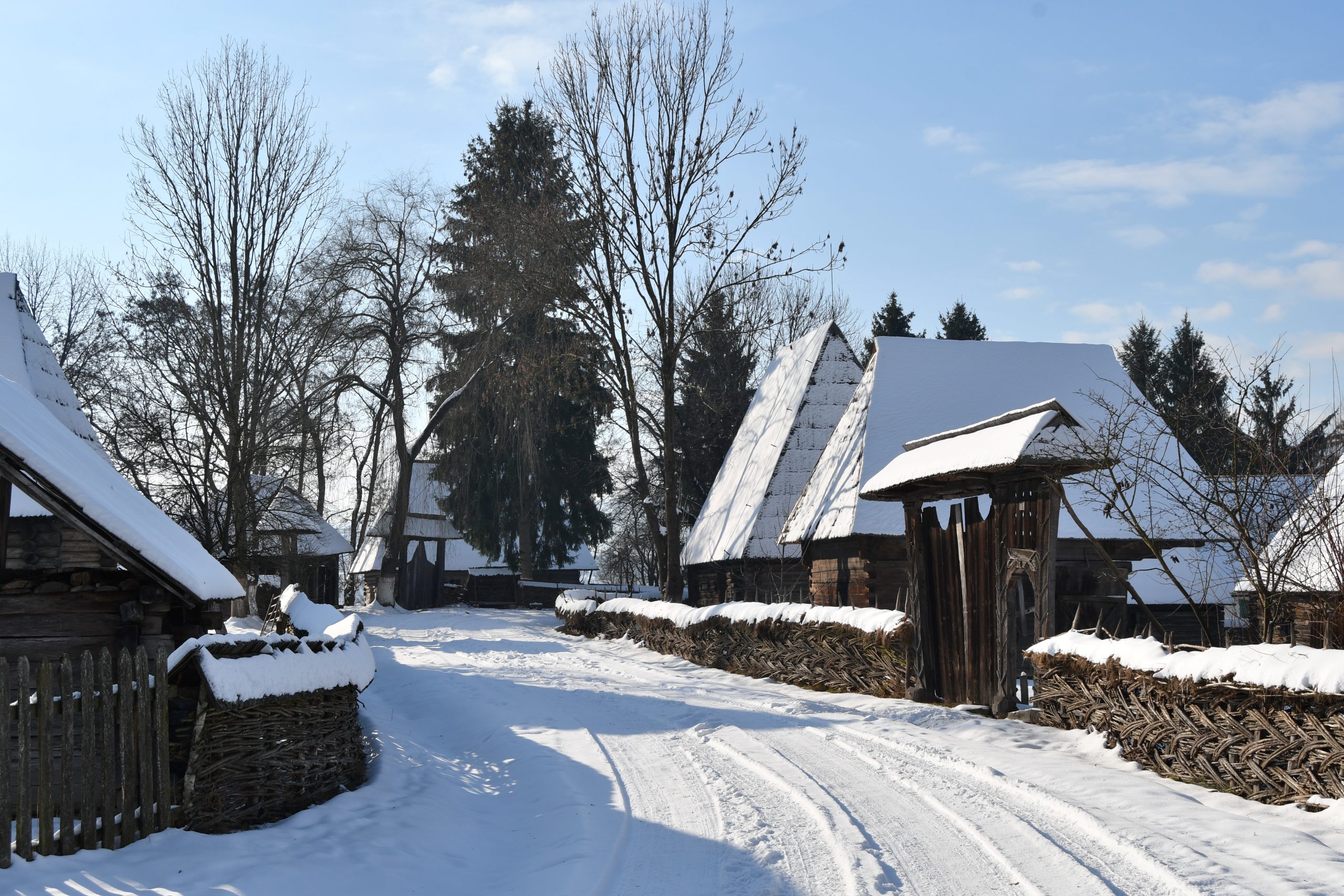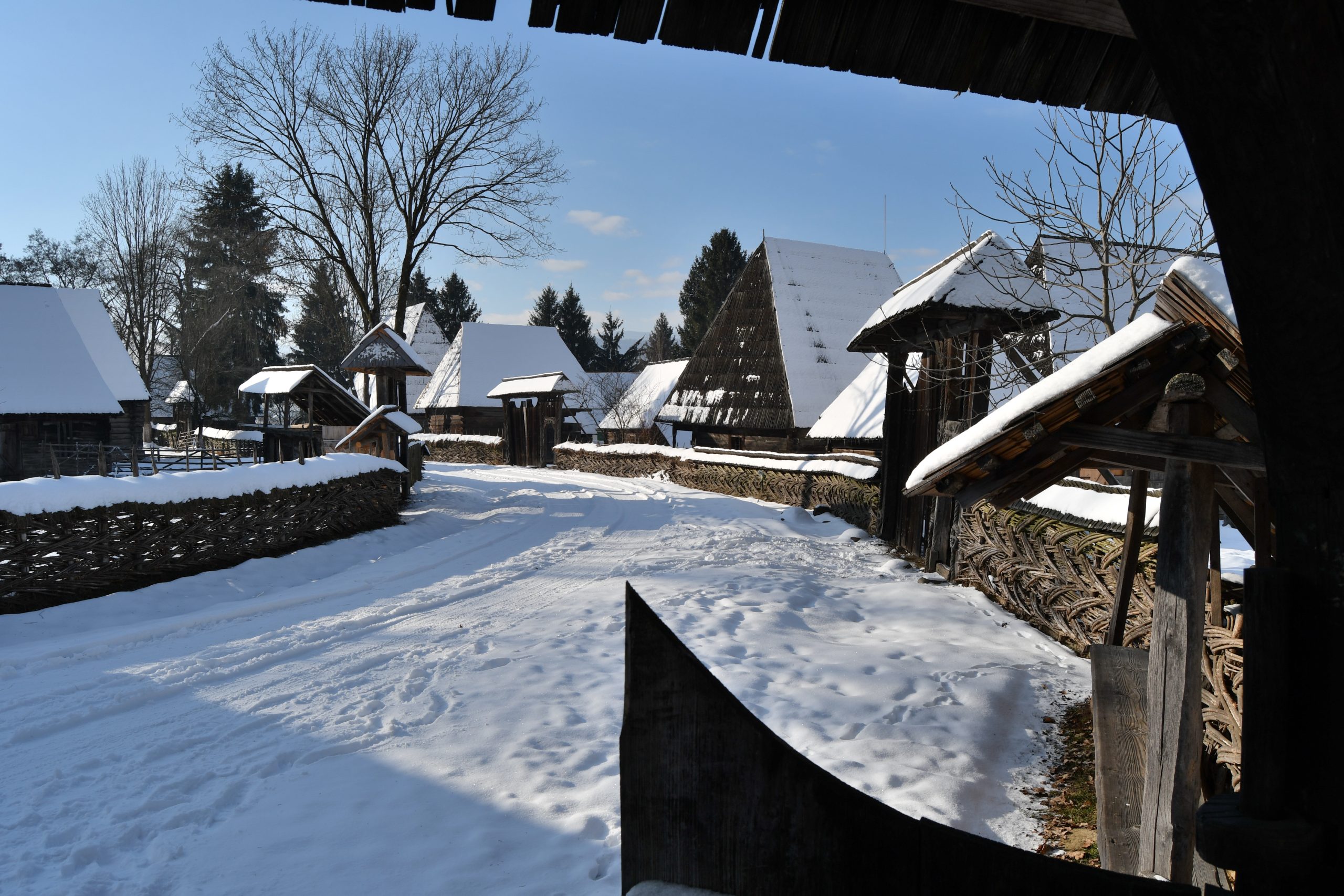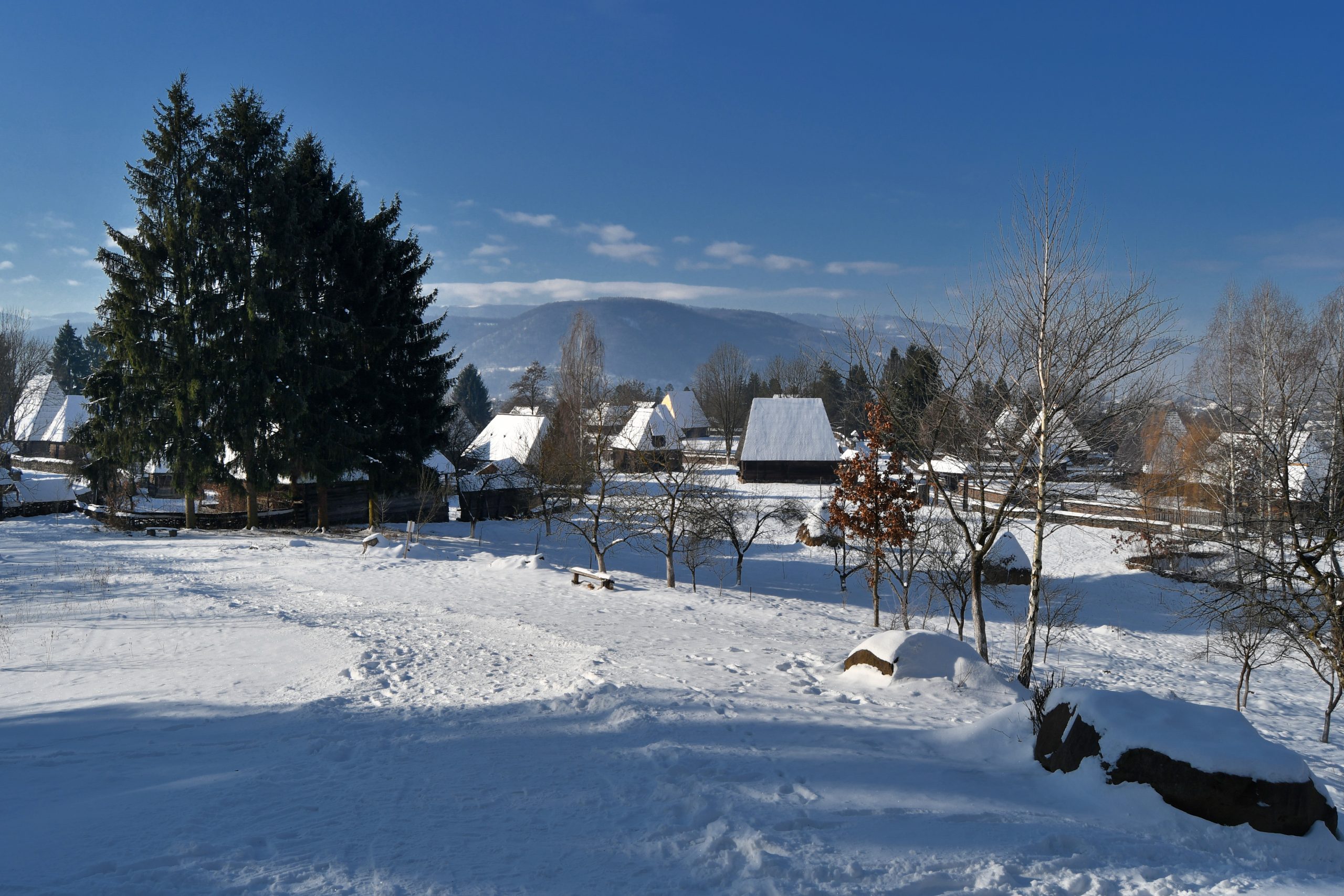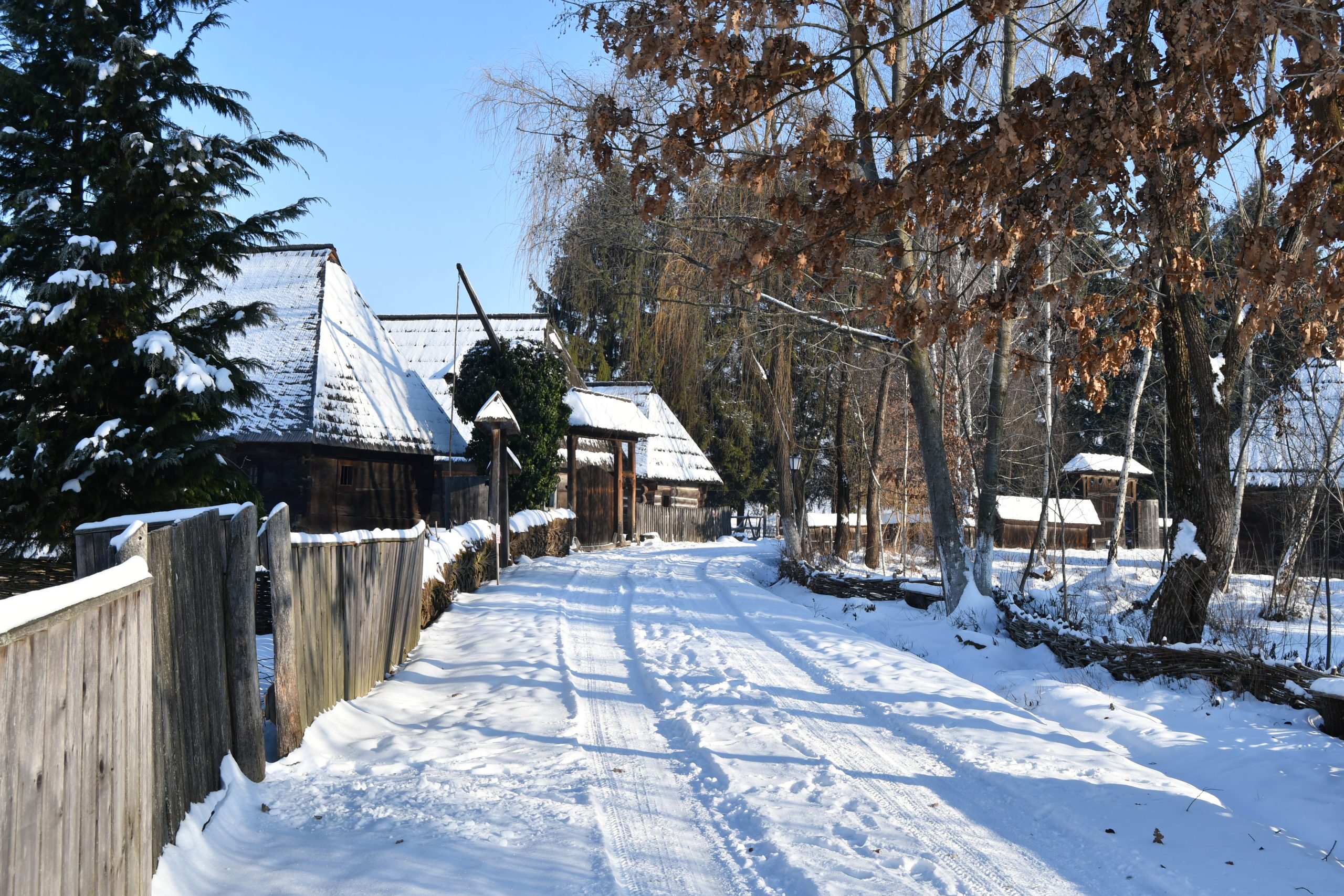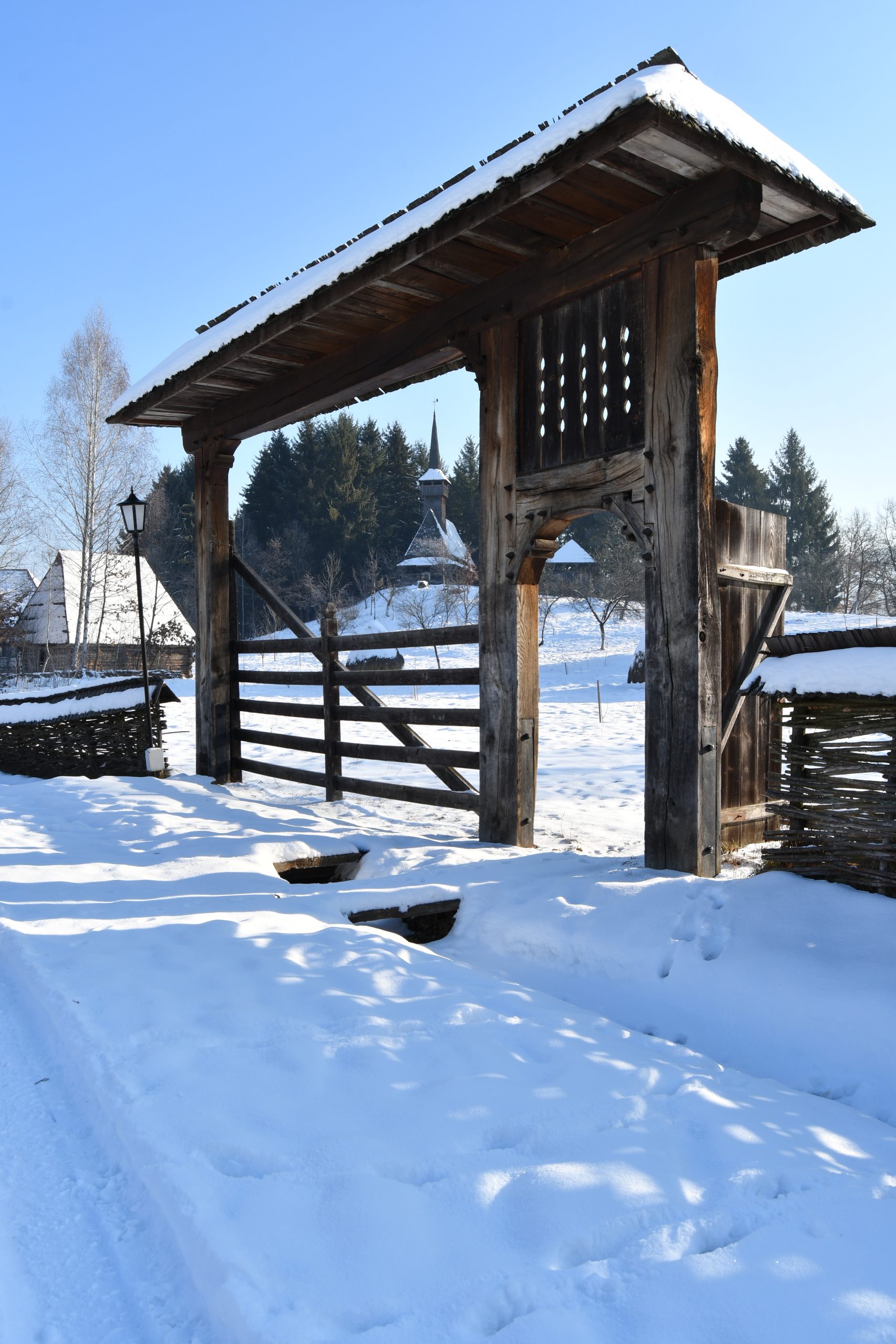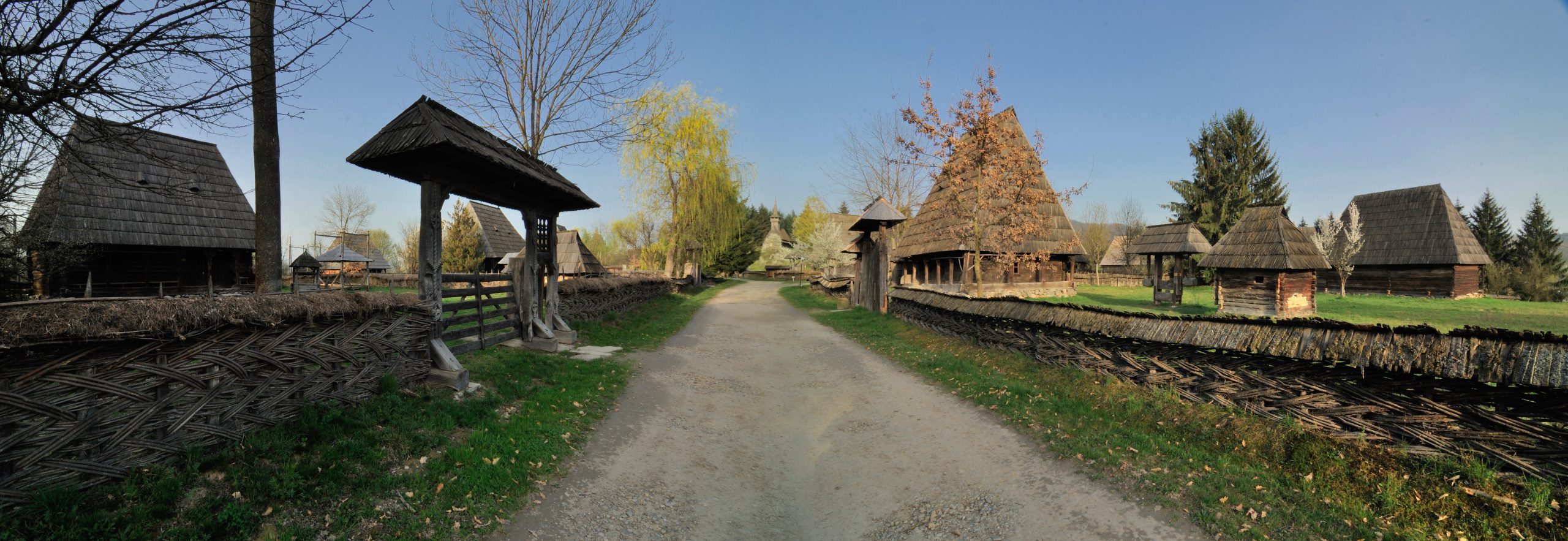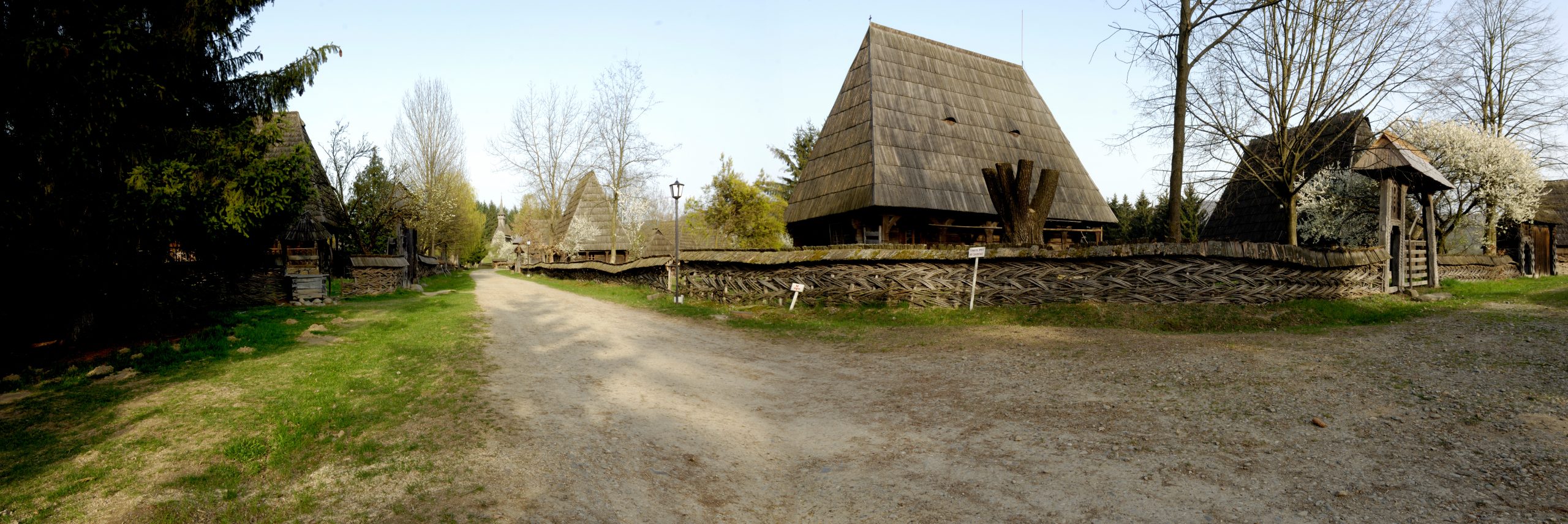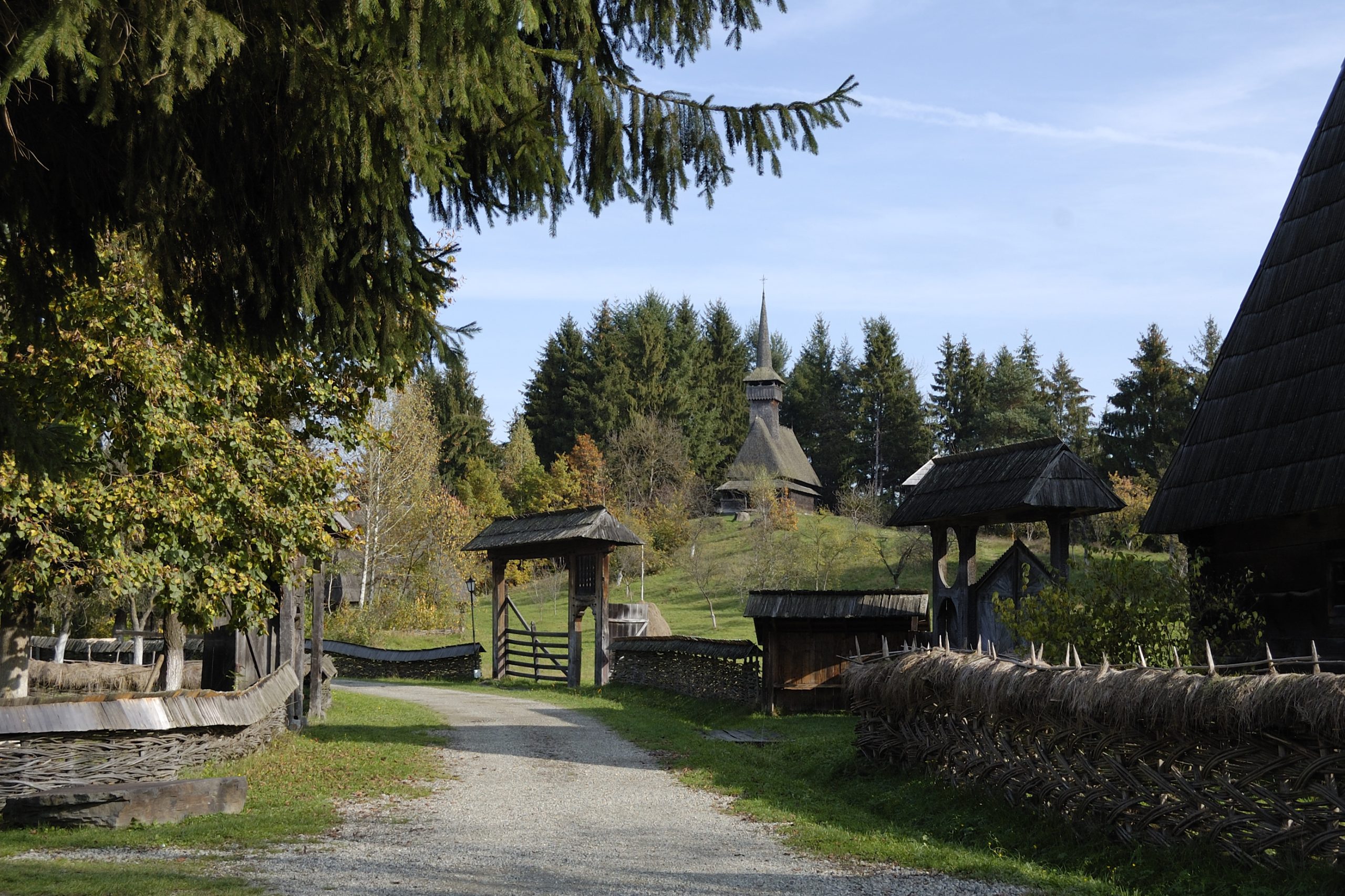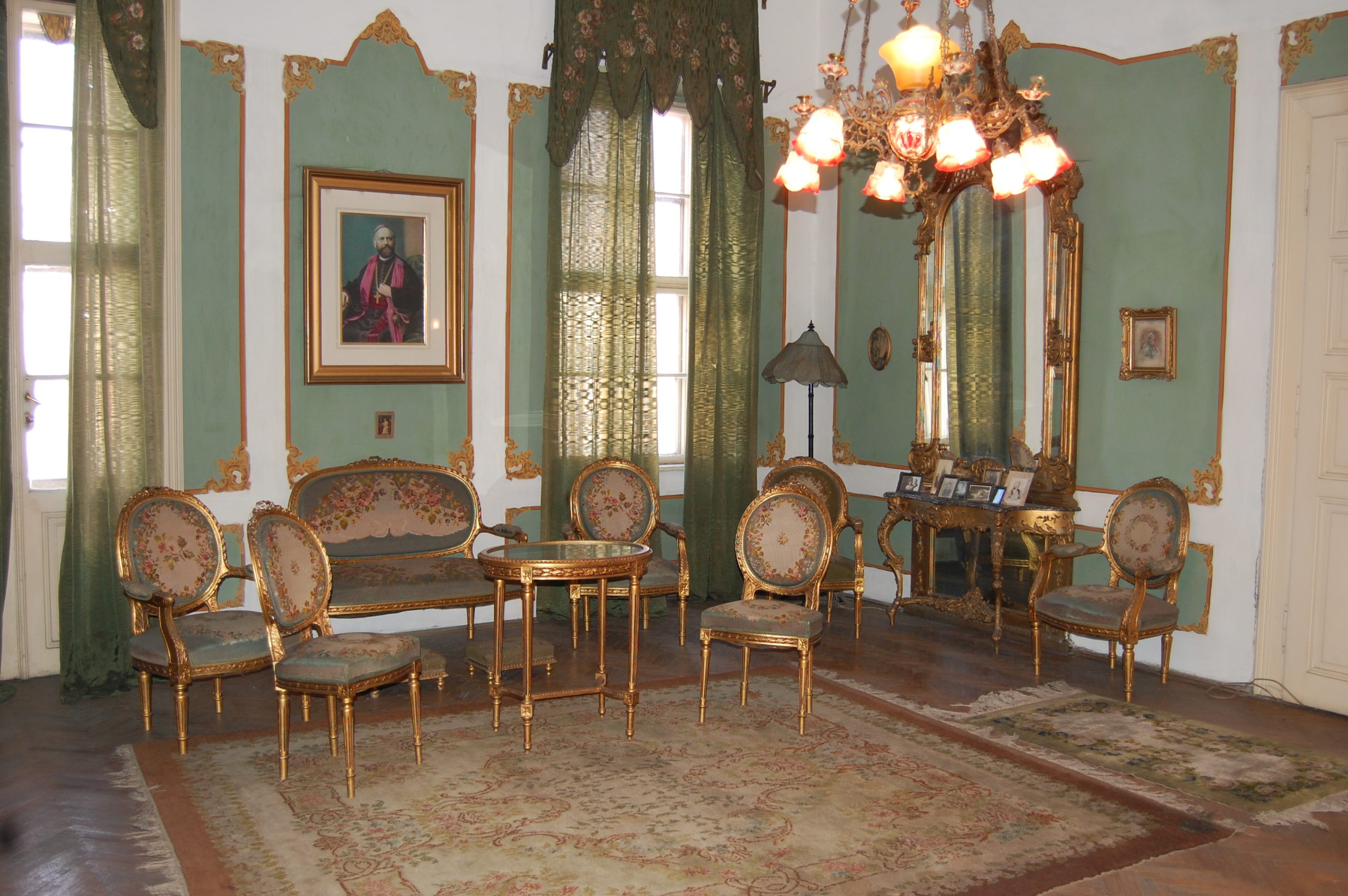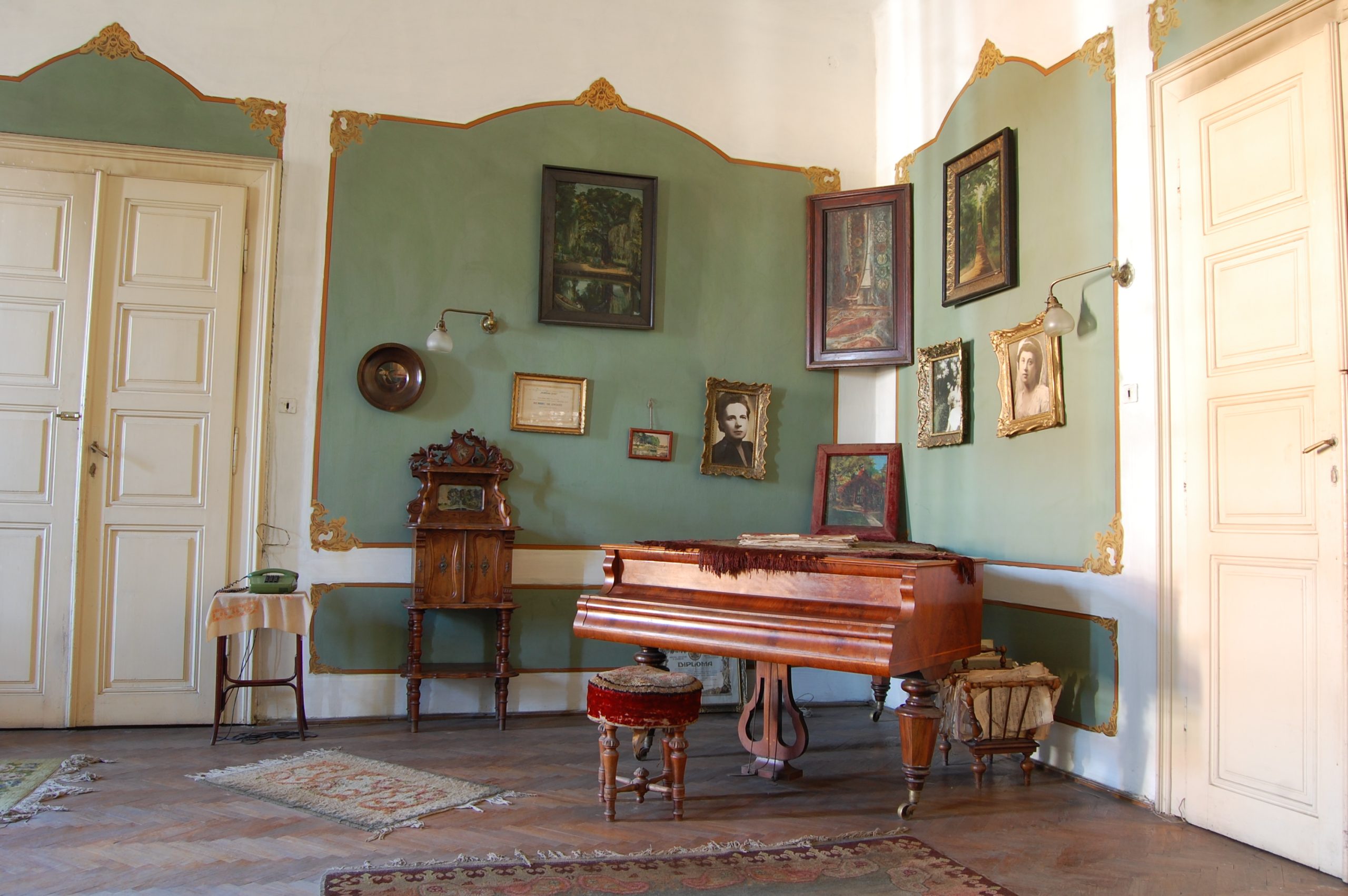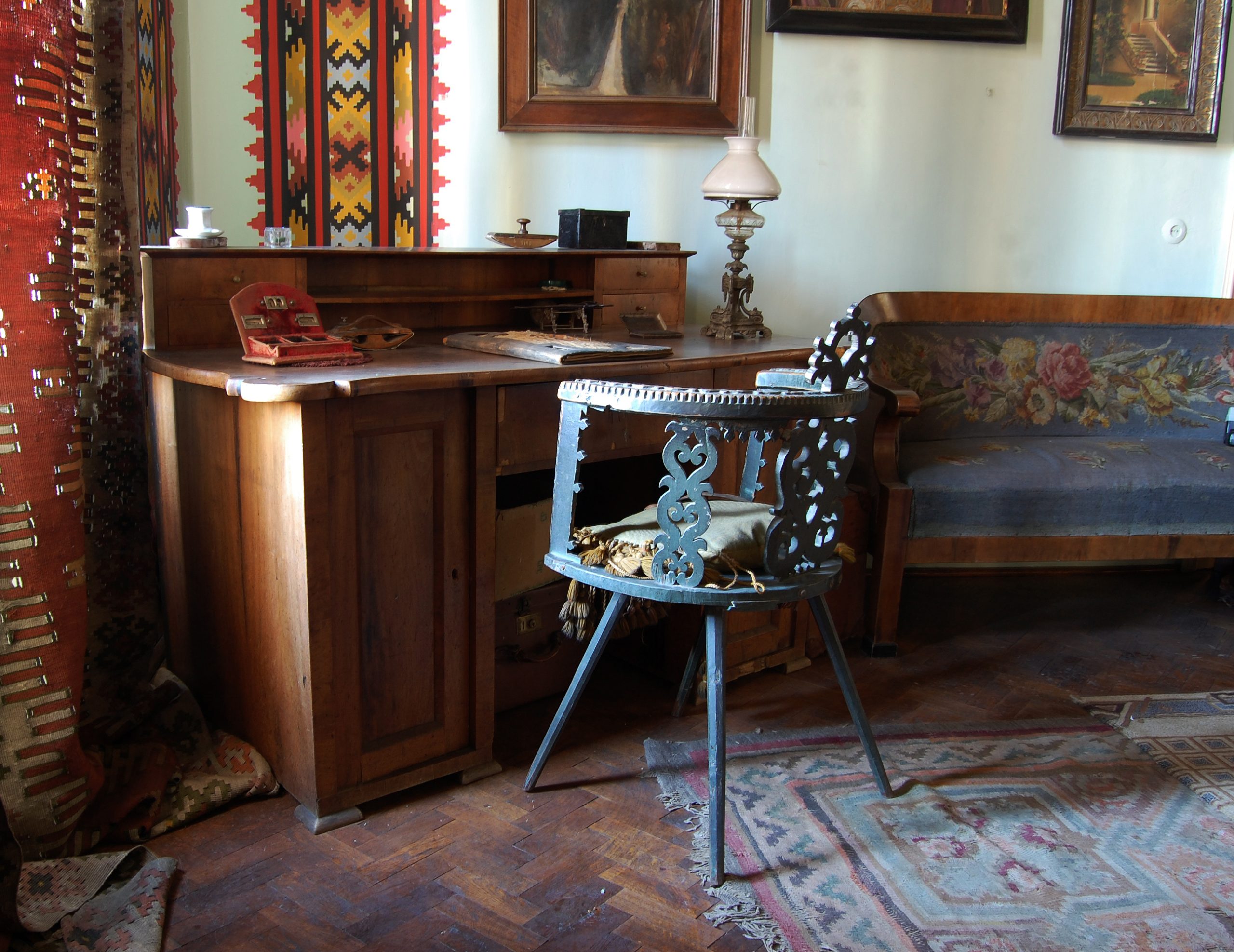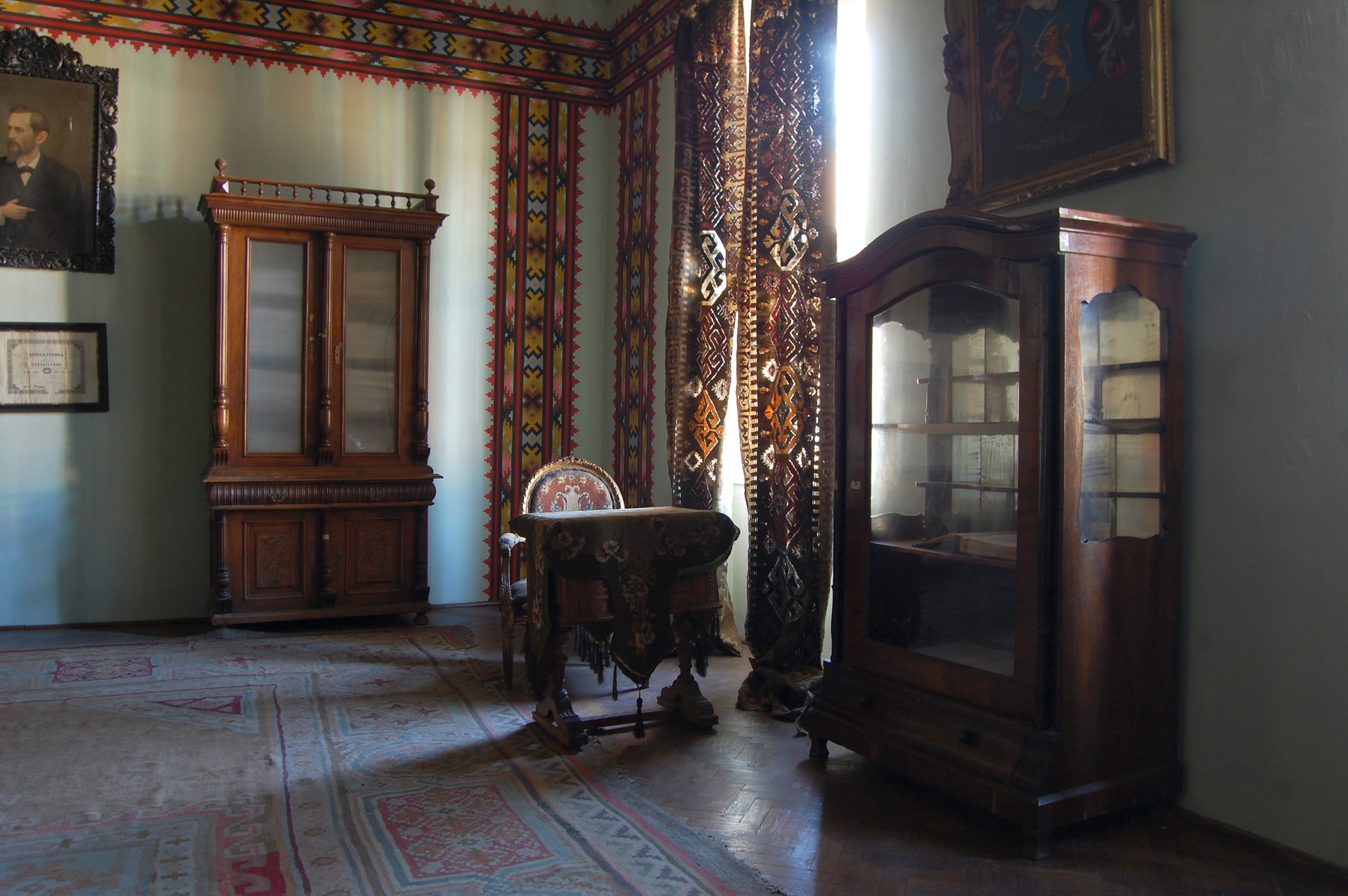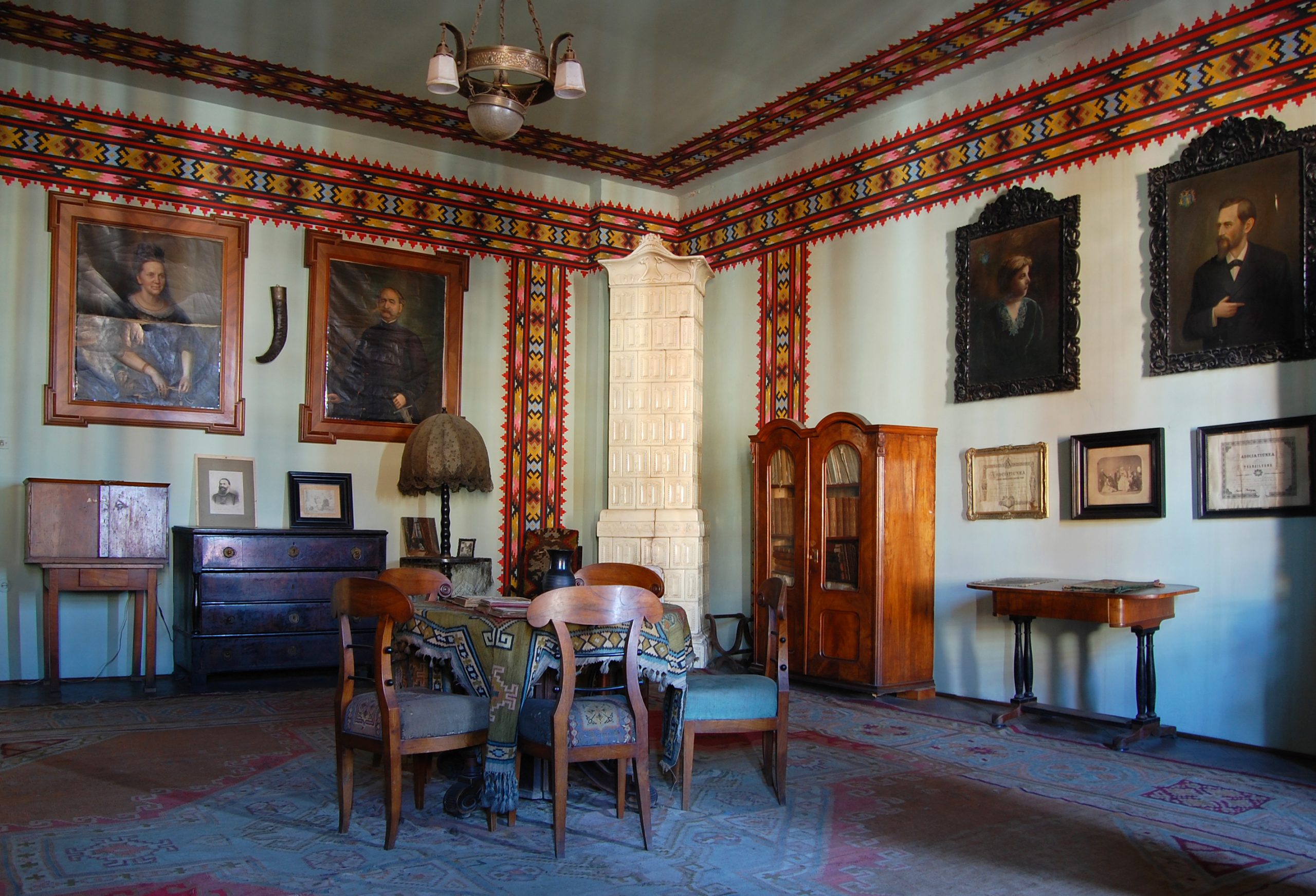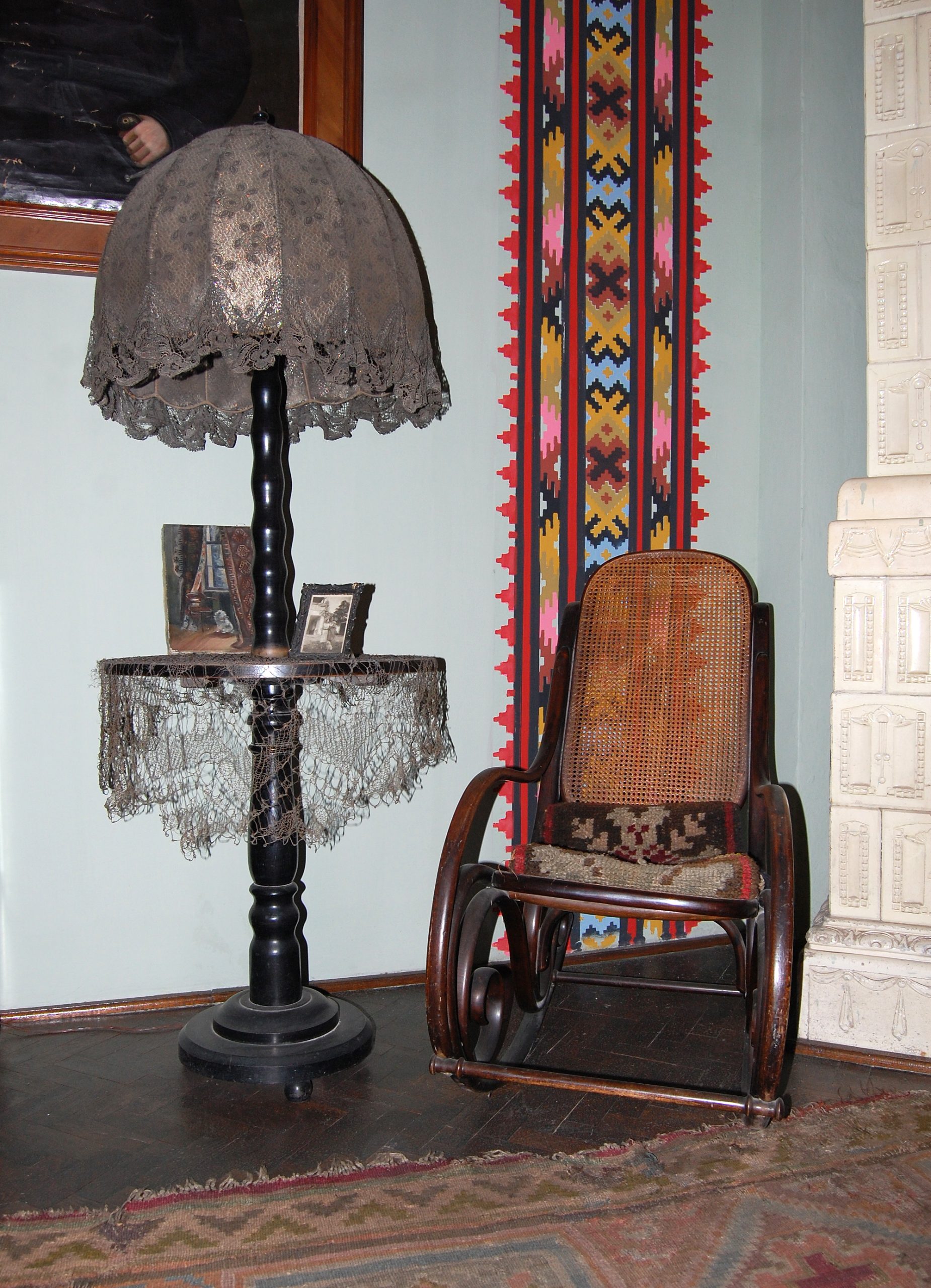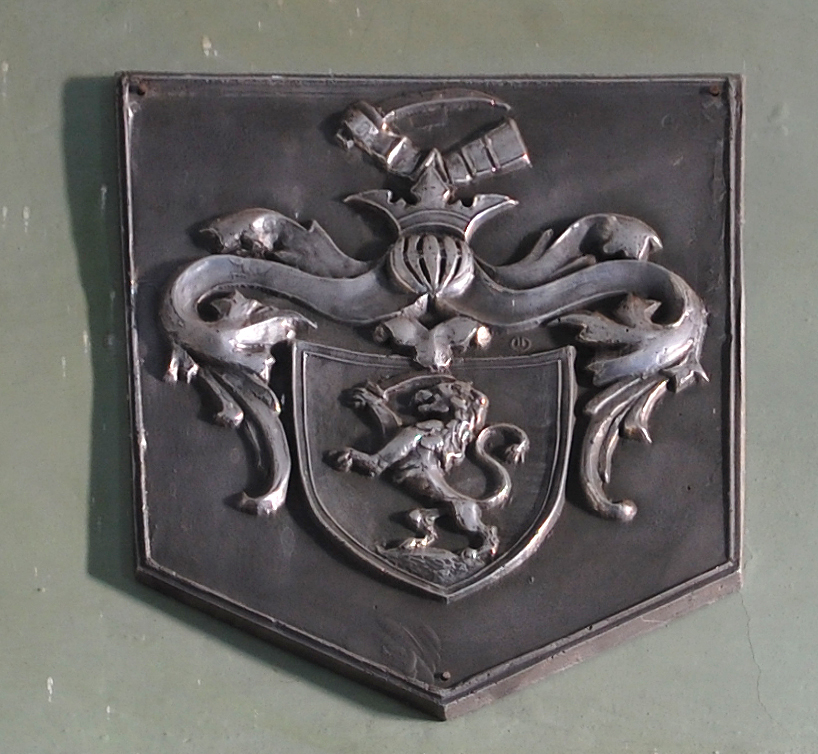Maramureș County Museum of Ethnography and Folk Art and the Village Museum, Baia Mare.
The Museum of Ethnography and Folk Art of Baia Mare County is a public cultural institution subordinated to the Maramures County Council. The museum is located on the Hill of Flowers, in a picturesque area of the city, near the historic centre. The institution consists of two locations: The Rural Museum and the Pavilion Section, located in the former Summer Theatre of the city.
In front of the Pavilion Section is a sculptural ensemble by the famous sculptor Vida Geza, consisting of 12 columns depicting figures from Maramures and masks from local mythology, reminiscent of the massacre committed on 14 October 1944 by the retreating Horthyst troops.
The Youth Field offers a wide green area located in the immediate vicinity of the Queen Mary Municipal Park, a recreational destination for those who enjoy long and relaxing walks.
Brief history. In 1899, the Baia Mare Museum Association was founded in Baia Mare, formed by the city’s intelligentsia, whose members donated the objects that made up the first collections of the Baia Mare Museum. The Second World War interrupted the work of the museum, which was resumed in 1950, but then a special emphasis was placed on the history department. It was only in 1964 that the section of ethnography and folk art was approved.
The significant increase in the collections of the Ethnography Department, as well as the special value of the works recognised by major experts in this field: Tancred Benecianu, Boris Zderciuc, Silvia Zderciuc, Nicolae Ungureanu, Cornel Irimiei, and Giorgeta Stoica, led to the organisation of an ethnographic museum with an ex-pavilion. For this purpose, the building of the Summer Theatre, which was then in deep degradation, was obtained, and later underwent major repairs and refurbishment to accommodate both the exposition and the department’s warehouses. The idea of preserving the space for performances was not abandoned: a stage and an amphitheatre with a capacity of about 800 seats.
On 1 July 1978, the first exhibition of the main pavilion of the Department of Ethnography and Folk Art opened. This exhibition was kept until 2007, when a new main exhibition was opened: Wood in Traditional Communities from Cradle to Grave.
On 15 August 1985, after long efforts by industry experts and local authorities, an open-air section, the Village Museum, was inaugurated. The monuments of folk architecture represent four ethnographic regions of the county: Historic Maramures, Chioar, Lăpuș and Codru.
The museum also tried to present the types of farms according to the main occupation of the inhabitants of the area of origin. Thus, we have farms from the Lapusului region, vineyards from the Baia Mare sub-zone, fruit growers from the Maramuresului region, etc. Technical structures, such as water wheels, pipes, whirlpools and water mills, were not left out.
The museum was developed around a wooden church originating from the village of Chechiș (Dumbravita commune), an area that belonged to the domain of Baia Mare (cf. documentary evidence from 1566). The church has been on this site (Dealul Florilor – Baia Mare) since 1939 and dates back to 1630.
"Elie Wiesel" Memorial House, Sighetu Marmatiei.
“If the Greeks invented tragedy, the Romans invented the epistle and the Renaissance sonnet, then our generation has invented a new literature – the literature of witnessing. We have all been witnesses, and we feel that we will have to witness the future. And this became the mana, the single and strongest bosom that marked all the lives, all the dreams, all the works of these people. Even a minute before he died, they thought he had to do it.” Elie Wiesel
Elie Wiesel’s memorial house. At the Maramures Museum of Jewish Culture, we connect people with the memory and life experiences of the Jews of Maramures through the cultural heritage of Nobel Peace Prize winner Elie Wiesel. The story we tell is the story of a place and of special people, and we try to capture, through reflection, interaction and exchange, the essence and complexity of the region with its contrasts and harmonies through collections, exhibitions and programmes for a wide audience. We take an active part in the life and history of Sigit and contribute to the cultural, educational, social and economic cohesion of the city with all our activities.
Located at the birthplace of Elie Wiesel, where he was born and lived until the age of 15, the Museum of Jewish Culture in Maramures is a place where we can understand the past in order to shape the future.
The house in which Elie Wiesel was born is located on Dragoș Vodă Street, at the corner of Tudor Vladimirescu Street, in an area that was part of one of the Jewish neighbourhoods of Sighet. It is characteristic of the areas of Transylvania and Central Europe in the late 19th and early 20th centuries, both in terms of architecture and interior design.
Its aim was to highlight Elie Wiesel’s personality, life, and activities, and to commemorate the Jewish community in Sigit and Maramures in a synthesis, as space and documentation allowed: rooms with antique furniture belonging to various Jewish families in Maramures, objects of worship and everyday life, documents, relevant photographs, photo and documentary reconstructions of the Holocaust in Maramures and Northern Transylvania, periodically supplemented by temporary exhibitions related to the communal, cultural, and social life of the Jews of Maramures. As an extension of the Elie Wiesel Memorial House, two Jewish houses, the Drimer House in Bârsana and the Jewish shepherd’s house in Poienile-Izei, were converted into the Village Museum. Both houses, by agreement, contribute to completing the portrait of the Jewish community of Maramures.
Bârsana Monastic Complex, Bârsana.
One of the most visited attractions in Maramureș, the Bârsana Orthodox Convent is a monastic ensemble consisting of several wooden buildings and following the traditional style of Maramureș, with a church tower that stands out, 74 metres high.
The foundation stone of the new monastery was laid in 1993 on the site of the old monastery, which operated from the beginning of the 14th century until 1791, when it was dismantled and the monastery church was moved to the village in 1806.
The wooden church of the “Entry of the Virgin into the Temple” in Bârsana is of particular beauty and is specific to the small churches of Maramureș with a double roof. The shrine, built in 1720, was originally the church of the old Bârsana Monastery, converted into a parish church in 1806, when it was moved to its current location. The interior walls were decorated with paintings in 1806. Due to its inestimable value, the church has been a UNESCO World Heritage Site since 1999.
Saint Anne (Sfânta Ana) Monastery, Rohia.
Among the valuable church and religious art monuments, which attract the admiration and appreciation of visitors from the country and abroad, a leading place is occupied by the The “Saint Ana” Monastery from Rohia, in ” Lapuşului Land”, Maramureş County. Located in a picturesque setting, on the ridge of a hill, in the middle of a beech and oak forest, the Rohia Monastery is the privileged place of seekers of peace and comfort, lovers of artistic and natural beauty.
The beginnings of the monastery are related to the person of the Romanian Orthodox priest, Nicolae Gherman (1877-1959), parish priest in the village at the foot of Vineyard Hill – Rohia, hill on which the monastery is located. The founding priest erected the monastery in memory of his daughter, the child Anuţa, whom he lost, being called to the Lord in November 1922, at the age of only 10. This little girl became a herald of God’s will because, nights in a row, the child would appear in a dream to her father, asking him to erect a “house of the Virgin Mary” on the Viei Hill, on the border of Rohia. At first, the grieving father kept his dreams in his heart, until one day a faithful woman, named Elijah’s Flower, came to him and said: “Father, why don’t you listen to the voice of God, who commands You through the child Anuta, to build a home to the Mother of God on the Hill of the Vineyard?” Confused the father asked her – “What house shall I make to the Mother of God?” to which the woman replied – “Convent to do, father!” At that moment Father Nicholas realized that it was a divine judgment, and filled with peace of mind, he decided to erect a monastery in memory of his daughter and for the comfort of the faithful in these areas. Supported by his fellow villagers, the priest decided to build the Holy Monastery in a clearing called “at Pintea’s oak” where, according to custom, a cross was placed. A few days later, however, they were astonished to find that the cross they had placed in the clearing was no longer in place, but was somewhere else, precisely on the spur of the hill, on a cliff. Suspecting that a malevolent hand had made this move, the cross was brought and placed in its place, and a believer, named Alexandru Pop remained on guard overnight. Late in the evening, when it began to snow, the believer returned home. The next morning, when he arrived there, although there was no trace on the newly fallen snow, the cross was not in place, but was again found on the site of the present monastery church. All considered that this could only be a revealed sign, showing the place where the church of the holy monastery should be erected. The works for the construction of the church began in 1923.
After many hardships, with great sacrifices and helped by the enthusiasm and arms of hundreds of believers, a modest church and a monastic house were erected within two years.
The monastery was consecrated only in 1926, by the worthy bishop Nicolae Ivan of Cluj, on August 15th, the celebration of the Assumption of the Virgin Mary, which became the monastery’s patron. Thus, “the first settlement of this kind” was founded in the attached Transylvania. For a long time, the settlement remained at the stage of a hermitage, unable to develop due to very difficult access. The monastery would develop after 1965 and especially in 1970, when electricity was introduced and the access road was arranged.
The zeal and dedication of abbots with a real vocation enriched the patrimony of Rohia Monastery, patrimony which today consists of the following values: “The Oak House” (1965), “The House of the Priory” (1969-1972), “The House with Chapel” (1973-1975), “The Poet’s House” (1977-1979), “The Summer Altar” (1980-1983), the “Maramures Gate” at the entrance to the monastery (1988), “The White House” (1988-1992), “The Village Gate” (1999-2001), “Maramures Corner” composed of a house and a wooden church (2001) etc. One of the very important achievements of this settlement was, is and shall remain the fact that here, during its 100 years of existence, hundreds of thousands of Romanians made their aspirations of unity of nation and faith come true.
Today, through the reorganization of the “Saint Ana” Romanian Orthodox Church, the Rohia Monastery is under the canonical protection of the Romanian Orthodox Diocese of Maramureş and Sătmar. It is located in the “Land of Lăpuş”, a beautiful, picturesque and blessed corner of the Romanian country, at about 50 km from Baia Mare Municipality and 43 km from Dej Municipality, on the border of Rohia village belonging to Târgu Lăpuș, in the middle of a beech and oak forest, on the ridge of a hill named “Vineyard Hill”, at an altitude of about 500 m.
Access routes:
The connecting junction to the monastery is the town of Târgu Lăpuș, which is located at a distance of about 9 km from the monastery. Târgu Lăpuș can be reached either on DN 18B Baia Mare – Târgu Lăpuș, or on the Dej – Baia Mare road to Gâlgău locality, and from there to Târgu Lăpuș. It can also be reached on the road Dej – Târgu Lăpuș through Măgoaja. The railway stations with connection to the monastery are Baia Mare, Dej and Gâlgău.
Teleki Castle, Coltău
Coltău is one of the most famous places of pilgrimage linked to poet Sándor Petőfi in Northern Transylvania. Mór Jókai’s visits and Petőfi’s poems established Coltău’s literary reputation.
The Coltău commune is located on the terrace of Lăpuş 10 km south of Baia Mare Municipality, the capital of Maramureș County, in the north-western part of Transylvania. It consists of Coltău, the commune centre and Cătălina – a belonging village.
The first documentary attestation of the village comes from 1405 and is mentioned under the name Kolcho in the document of the Convention of Leles (Slovakia), signed by the voivodes Drag and Balc. It was later ruled by the Drágffy family, and since 1549 it belongs to the Land of Chioar and since 1615 the region belongs to the Principalities of Transylvania.
Since 1674 Coltău and Cătălina come into the possession of the noble family Teleki, who receives the villages as a royal donation and would remain with this family until 1936.
For centuries, members of the Teleki family have played a major role in the political and cultural life of Hungary and Transylvania, and the family has given numerous personalities to science, literature and domestic and international political life. Here are some examples of some of the family’s best-known personalities:
● Count Sámuel Teleki (1739-1822) chancellor of Transylvania, man of culture, famous book collector, founder of the Teleki Library in Târgu Mureș.
● Count József Teleki (1790-1855), jurist and historian who served as President of the Hungarian Academy of Sciences between 1830 and 1855.
● Countess Blanka Teleki (1806-1862) born near Coltău, in Satulung, was an educator and activist for women’s rights, founded the first girls’ school in Budapest in 1846, then was imprisoned for 5 years after the Hungarian Revolution of 1848-49.
On the property in Coltău, in the middle of the 18th century count József Teleki organizes an economic household and erects a baroque building. This building, for one hundred years, was used by the family only on the occasion of receiving guests who arrived on hunting raids, while the family had lived for generations primarily at the estate in Şărmaşu, Cluj County. The most famous owner of the castle was the “wild count” Sándor Teleki, being a disciple of the politician Táncsics Mihály, travel companion of the musician Franz Liszt, the dearest colonel of the Bem and Garibaldi generals, the good friend of Petőfi Sándor, Victor Hugo, Jókai Mór and Alexandre Dumas (father and son).
Over the years, Coltău has become a place of pilgrimage for tourists who love Hungarian literature. It is known that the great Hungarian poet Petőfi Sándor, the poet of freedom and love, spent his honeymoon in Teleki Castle between September 9 and October 19, 1847. During this period of sweet harmony, the poet wrote 24 love poems to his wife. Under a horn in the castle park was born the most famous love poem “End of September” (translated into Romanian by Eugen Jebeleanu), being a true masterpiece of Hungarian and universal literature.
After 18 years in exile, in 1867 Sándor Teleki returned to Coltău and began to build the so-called “Red Castle”, now the headquarters of the local secondary school. At the beginning of the twentieth century, his son, Ioan Teleki, who lived at the castle in Coltău and managed the estate, when the family expanded, expanded the castle, modified it and rearranged it to make it more comfortable. Then they added to the building a terrace in the northwestern part of the castle, which offers a splendid panorama to the valley of the Lăpuş River and the Gutâi Mountains.Teleki Castle in Coltău, which before World War II was famous for its private collection of precious objects, since 1960 houses the Petőfi Sándor museum, which at first started with only a Petőfi memorial room, and at the beginning of the third millennium, expanded and occupied the entire floor.
Starting with summer 2020, tourists can visit the castle restored under the Regional Operational Program and co-financed by the European Union through the Regional Development Fund.
The restored castle consists of four levels: ground floor, first floor, cellar, where permanent exhibitions about the Teleki family are presented, visits of poet Petőfi Sándor to Coltău, life of the “wild count” Sándor Teleki, visit of writer Jókai Mór to the castle, and in the attic in the conference room you can visit temporary art exhibitions.
In the castle park there are several trees of rarity, several hundred years old, which evoke the atmosphere of the past: a black ash tree (Fraxinus excelsior), under which, according to legend, the fiddler Pócsy Laci played to the composer Franz Liszt; three marsh cypresses (Taxodium distichum); a legendary horn, under which on a stone table the poet Petőfi wrote most of his poems at Coltău.
In the park there are the following statues: the statuary group Petőfi-Szendrey (Pogány Gábor Benő, 1998); bust of Count Sándor Teleki (Dinnyés László, 2008); bust of composer Franz Liszt (Dinnyés László, 2011); bust of General Bem (Deák Árpád, 2014).
We suggest tourists to visit Colt not only on the occasion of tourist destinations in Maramureş County, but also when they want to reach more distant lands. The guesthouses in Coltau, with a total reception capacity of 150 people, offer tourists high quality hosting services and local facilities. You can spend several nights here and daily you can visit in the shape of a star the historical Maramureş and the north-western region of Transylvania.
We wish you pleasant stay!
"Baia Mare Art Center" County Art Museum.
The County Art Museum the « Artistic Centre Baia Mare» is a cultural institution located in the Old Center of Baia Mare, at 1 Mai Street, no.8. The building of the museum operates was erected in 1748 and is a historical monument of national importance. Although seen from the outside it may seem quite unimpressive from an architectural point of view, inside visitors will be pleasantly surprised by the vaulted ceilings in the ground floor rooms, by the Art Nouveau ornaments existing on the ceilings of the high halls upstairs, as well as by the stoves made in the Rococo style. Also, the edifice that currently houses the museum’s exhibitions is distinguished by its history. The basement and ground floor of the building were built during the Habsburg Empire with the purpose of serving as a salt deposit and headquarters of the Saline Office. After about 100 years, it was refurbished and transformed into a bank headquarters, and from the early 1900s it became the private house of lawyer Dr. Teofil Dragoș. Being an important personality in the community from a political and social point of view (besides the legal profession, Teofil Dragoș was also President of National Liberal Party of Satu Mare, prefect, deputy, president of the “Aurora” Credit and Savings Institute in Baia Mare and president of the Satu Mare Chamber of Commerce and Industry) and having the necessary financial resources, Teofil Dragoș resorted to extending the building by superposing. After his death in 1934, the building was donated to the City Council, and in 1954 it was given to the administration of the Maramureș County Museum. Subsequently, the Art Department of the museum operated in the building, which in September 2006 was reorganized as the County Art Museum « Artistic Centre Baia Mare ». This museum is distinguished at national level by the fact that it is the only institution focused exclusively on collecting, hoarding and exhibition capitalization of works of art created by artists from Baia Mare, as well as by artists who worked in Baia Mare, although they were born or were professionally trained in other cultural spaces in the country and abroad.
The foundations of the artistic movement in Baia Mare were laid between 1896-1901 by Simon Hollósy and a group of painters from Baia Mare, namely Béla Iványi Grünwald, Thorma János, Réti István and Károly Ferenczy. Hollósy Simon, native of Sighetu-Marmatiei, completed his professional training at the Royal Academy of Fine Arts in Munich, where he later came to be recognized “as a first-rate talent”. Before his 30th birthday, he became a master of fine arts for students around the world and founded an internationally acclaimed private painting school in Munich. As a result of this resounding success and his Maramures origins, the officials from Baia Mare invited him to come and work together with his students on his native lands. This context was considered by Hollósy to be an excellent opportunity to overcome the limits of studio painting, for which he accepted the invitation of Mayor Thurman Oliver and, in May 1896, brought his first group of students from Munich to Baia Mare.
For six years, until 1901, Hollósy continued to come with his students to Baia Mare during the summer. Thus, during this time, over 400 artists from various European countries, but also from North America, Australia and India, created in Baia Mare under Hollósy’s guidance. The cosmopolitan character of these groups of artists, correlated with the academic and professional studies that many of them followed in other centres, such as Munich, Budapest, Bucharest and Paris, made the artistic activities carried out in Baia Mare to be strongly influenced by the ideas and aesthetic models existing at international level. These influences were reflected in the multitude of stylistic currents existing in the art of Baia Mare, starting from the plein air realism specific to the first creations, and up to the postmodernism that characterizes contemporary art.
After 1901, the pedagogical activity in the artistic field continued in Baia Mare under various forms and names (Free School of Painting, School of Fine Arts, Free School of Fine Arts, etc.), which made over time in the city to carry out their creative activity over 3,500 artists from Europe and beyond. The relief, the natural setting and the beautiful landscapes of Baia Mare and its surroundings were important attraction factors of the artists in this area, significantly influencing their creation. For this reason, Baia Mare, also called “the city of painters”, came to own one of the few European artistic colonies that functioned uninterruptedly, starting from the 19th century until today.
In this context, the cultural heritage of the County Art Museum « Artistic Centre Baia Mare» has progressively increased over time, currently totalling over 6,790 cultural goods, divided into the following collections: painting, graphics, sculpture, decorative art, art photographs and documentary fund. Among them, visitors can admire in the permanent exhibition of the museum, entitled “Baia Mare Artistic Center. European landmarks between traditions and innovations“, a selection of 350 works, exhibited in 11 halls. The exhibition presents a chronological synthesis of the artistic creation made in Baia Mare, starting with 1896 and until now, being organized problematically, thematically and chronologically.
The museum’s opening hours are from Tuesday to Sunday, between 10:00h and 17:00h.
"Victor Gorduza" County Museum of Mineralogy, Baia Mare.
The “Victor Gorduza” County Museum of Mineralogy Baia Mare – MusMin – is one of the most important museums with natural sciences profile in Romania and the largest regional museum of mineralogy in Europe, whereas the entire museum patrimony, either exhibited or stored, comes from the north-western area of Romania.
The museum developed on the structure of the Natural Sciences Department, founded on January 17th, 1976, within the Maramureș County Museum and which had its headquarters in the Iancu de Hunedoara House, in the Old Center of the city, a space that also hosted the first permanent exhibition of the department. On February 8th, 1988, the Department of Natural Sciences was relocated, in order to build an adequate headquarters, the building located at 8 Traian Blvd. And, after almost two years of intense work, on November 6th, 1989, the current permanent exhibition officially opens in a new, representative and properly endowed headquarters. On December 10th, 1992, following the decision of the Permanent Delegation of the Maramureș County Council, it receives the legal status of museum, separating from the Maramureș County Museum, and today it proudly bears the name of the one who had the idea of establishment, led it and made it known in the country and abroad, namely Victor Gorduza.
The continuous development activity of the museum heritage, in over 45 years of activity, is materialized today through an impressive heritage, comprising over 20,800 pieces, grouped in four collections: minerals, fossils, rocks and ores. All these come from outcrops and especially from underground mining exploitations, which operated until 2006 in the so-called Baia Mare mining region.
The valorization of the heritage is achieved primarily through the permanent exhibition, at the museum headquarters and also through temporary exhibitions, organized at the headquarters, in the country and abroad. In over 45 years of activity, of which 33 in its current location and structure, the Museum of Mineralogy has organized and hosted over 210 temporary exhibitions in the country and abroad. Among the 45 exhibitions organized abroad, we mention: Vienna (1982, the first exhibition organized abroad), Austria (travelling exhibition in 10 localities, between 1984 and 1986), Germany (1990, 2001, 2002 and 2016), France (1991), Austria (1991-1993), France (travelling exhibition at 8 museums, between 1995 and 1997, also in 1999 and 2002), Monaco (2004), Belgium – Brussels (2007), Netherlands (2008), Chișinău (2013) and Hungary (2005, travelling exhibition between 2006 – 2007 at 4 museums, 2014, 2015 and 2017).
The permanent exhibition of MusMin is organized in four sections. The first section, Petrography, presents the overall geological structure of the area, the main types of rocks and their uses. The second section, Mineralogy, highlights the crystallographic forms, the physical properties of minerals, and mineralogical systematic by class. Within the Deposits section there are displayed the representative ores from hydrothermal, poly-metallic and gold-silver deposits, associated with Neogene magmatism, which were the object of mining exploitations. The fourth section, Mine Flowers, is dedicated to the most impressive mineral samples, which amaze the viewer with the special aesthetic qualities they reveal: crystallographic shapes, sizes, colours, mineral coalescences, etc.
The minerals and unique mineral associations in the museum’s collection are the main points of interest in the permanent exhibition. Stibnite, one of the most representative minerals for the Baia Mare region, is presented in the form of thick glossy prisms in samples from Băiuț mine, acicular crystals in paragenesis with transparent barite coming from Baia Sprie mine and in the form of radial aggregates specific to Herja mine.
A special variety of shapes and colours also appears in calcite – samples with lacy, radiating or spherical shapes, coloured white, gray, black, brown or colourless. Another mineral that brought fame to Baia Mare region, barite, appears in various colours: colourless, milky-white, yellow, gray, blue and of course intense red, unique colour worldwide for the barite from Baia Sprie mine.
Perfectly cubic pyrite crystals of impressive size, pink rhodochrosite rhombohedral crystals, green, violet and yellow fluorine cubic crystals, quartz varieties with coral appearance or in the form of columnar and transparent crystals, purple amethyst from Red Valley mine, as well as other special samples complete and perfect the permanent exhibition of the Museum of Mineralogy.
The mineral samples from the MusMin collection are spectacular from an aesthetic point of view but also rare worldwide, which is why some of them are classified in the treasure category of the national cultural heritage of Romania. Also noteworthy are mineral samples including semseyite, fizélyite, fülöppit, andorite, klebelsbergite and rhodochrosite – minerals that were discovered and described for the first time in the world in deposits in the Baia Mare area.The activity of the “Victor Gorduza” County Museum of Mineralogy Baia Mare has been recognized and appreciated locally, nationally and internationally. Thus, in 2001, the Ministry of Culture and Religious Cults awarded the Museum the “Grigore Antipa” Prize, the first of its kind awarded to a museum in the field of natural sciences. In 2004, Ion Iliescu, President of Romania, awarded the then director of the Museum, Victor Gorduza, the Order of Cultural Merit in the rank of Knight, in 2009, Maramureș County Council awarded him a Diploma of Excellence, and in 2014, the Local Council of Baia Mare awarded him the title of “honorary citizen”.
Maramureș County Museum of History and Archaeology
The idea of establishing a museum in Baia Mare originated in the late 19th century, when there were already quite consistent collections of “old objects”, capitalised on by the first historical exhibition. On 31 August 1899, thanks to the efforts of the historian Schӧnherr Gyula, the Baia Mare Museum Association was established, whose intensive activities led to the opening of the Baia Mare City Museum to the public on 19 June 1904.
From the very beginning, the museum replenished its collections mainly through donations, especially in the field of books, archaeological finds, coins, medals, ancient weapons, etc. Thus, in 1901, the museum’s collection consisted of 2,441 items, in 1904 – 6,938 items, so that during the First World War the number of exhibits reached 11,489 items.
In the interwar period, the Baia Mare Museum reorganised its collections, and the first exhibition was opened in 1924.
In 1951, the Baia Mare Museum became a local history museum, and in 1968-2006 it operated under the name “Maramures County Museum” with five departments: history and archeology, art, ethnography and folk art, natural history, and technical history.
Today, the Maramures County Museum of History and Archaeology is a public cultural institution subordinated to the Maramures County Council, which provides the financial resources necessary to achieve the goals derived from the museum’s core functions.
In addition to the Mint, which was built in the 18th century, the museum also houses an important historical monument that was part of the fortification system of the medieval city of Baia Mare, the Bastion of the Butchers. It was returned to the local community and re-entered the tourist route in 2011 thanks to the project “Restoration and Revitalisation of the Butchers’ Bastion in Baia Mare, Maramures”, implemented by the Maramures County Council.
The museum heritage, consisting of various categories of cultural property, some of which are of local, regional and even national significance, is displayed in the vast expanse of the city’s former Mint and the Butchers’ Bastion.
According to statistics, it has 75,509 inventory numbers, of which the archaeological heritage comprises 35,745 artefacts, and the History section includes 24,128 items structured in collections of medieval archaeology, monetary treasures, workshop tools, knives and specimens, prints and photographs, documents, mining equipment, and memorial heritage. These are complemented by 9278 volumes (16th-20th centuries) of the book and documentary collection, and the current book collection, which includes 10322 volumes (specialised publications, yearbooks, etc.).
The archaeological heritage comes from systematic and preventive archaeological research, surface investigations, as well as from accidental discoveries that trace the lines of human evolution over a long period of time. Some of the artefacts discovered are on display in the permanent exhibition “Bronze Age Treasures from Northern Transylvania”.
Another important segment includes monetary treasures, stone-cutting products, guild insignia and products, patterns and seals, white and firearms, stamps and documents, all of which make it possible to reconstruct the dynamics of the evolution of the free royal city of Baia Mare.
Mining has long been the economic backbone of the Baia Mare area, a museum heritage that allows us to reconstruct its evolution, with around 1500 exhibits. Tools, ore transport, underground lighting, documents and photographs can be found in the mining history collection, many of which are unique. These are complemented by components that were kept on site from Romania’s first refinery, which operated in this space from 1926 to 1967, including the Treasury, the place where gold and silver bars were stored before they went into NBR’s safes. All of this can be seen in the permanent exhibition Mining and Civilisation in Maramures, which is unique in the Romanian exhibition landscape.
A particular attraction for the public is the collection of clocks (around 300 pieces), with several exceptional pieces that give the permanent exhibition Journey Through the Universe of Clocks a special cultural and scientific value. From enormous tower clocks to small table and pocket clocks, from a wall pendulum from the French Revolution (1789) to a clock checker, they all arouse the curiosity of the audience, fascinated by the lavish decor typical of the Rococo style, some wall or pedestal clocks, as well as floral motifs and enamels painted with great talent by old masters.
This exceptional heritage is also an important mediator of museum education, an institution that runs successful programmes and projects at this level of activity: “Living Museum, Generation of Historians Teaching Society, Velenii Shomcutii Experimental Archaeology Camp, 4 Your Culture – 4 Medieval Monuments in the City Where I Live and Study, Museum Without Barriers – Access to Museum Culture for People with Disabilities, and Great Civilisations of Antiquity.
Scientific research on heritage is implemented through studies and articles published in the publications of the Maramureş County Museum of History and Archaeology, respectively, in the Marmatia Yearbook and the Bibliotheca Marmatia series, Museum Collections, Maramureş Studies and Research, Living Museum.
Memorial to the Victims of Communism and Resistance, Sighetu Marmatiei
The Memorial to the Victims of Communism and Resistance was created and is managed by the Civic Academy Foundation.
“The greatest victory of communism – a victory that was dramatically revealed only after 1989 – was the creation of a man without memory, a new brainwashed man who does not need to remember who he was, what he had, and what he did before communism.”
The realisation of the Memorial to the Victims of Communism and the Resistance is a form of counteracting this victory, a means of reviving collective memory.
Established by the Sigit Museum and the International Centre for the Study of Communism, based in Bucharest, and the organiser of the Summer School, the Memorial is a memory institution, unique in that it is a research, museum and educational institute.
To the question “Is it possible to restore memory?” The Memorial to the Victims of Communism and Resistance in Romania gives a convincing affirmative answer.” (Ana Blandiana).
In 1993, the Civic Academy Foundation took over the ruins of the former prison to turn it into a museum. Ana Blandiana proposed a framework project to the Council of Europe. It required, on the one hand, the fundraising necessary for the reconstruction of the building and, on the other hand, the creation of a database necessary for the creation of the museum. Thanks to the material efforts of the Civic Academy Foundation and the research work of the International Centre for the Study of Communism, both in Bucharest, the former prison became the world’s first memorial dedicated to the victims of communism.
Today, the former prison is a site of events that took place during the communist era in Romania and other Central and Eastern European countries. Each of its cells, which have been converted into a museum hall, contains a thematic or chronological detail of the political ugliness that caused suffering and death – inside or outside prison walls – during the twentieth century in Europe.
Maramureș Museum, Sighetu Marmației.
It is a regional museum that represents the historical province of Maramures. The current structure of the museum includes it as a type of museum complex, nationally representative of each historical province of the country. It differs from museums based on territorial and administrative structures, i.e. county museums, which are usually heterogeneous. The museum functions as a museum complex with ethnological dominance (a museum with a pavilion exhibition and an open-air museum), as well as with departments of history-archaeology, cultural history and memorials, natural sciences, an art gallery and several in-situ conservation as a museum of points in the main sub-districts of Maramures. The Maramures Village Museum is located on the Dobojes hill, 3 km from the centre of Sighetu Marmatiei, at the exit to Vada Izei. The museum in its current form gives the impression of a village with regional characteristics that have evolved from “scattered” and “dispersed” to “gathered”. Straight (main) and winding streets, paths and “fences” make up the intimate structure of the “village” and converge to a promontory, on which, like all Maramures villages, stands a church. Other existing departments include the Maramures Ethnographic Museum, the Historical and Archaeological Museum, and the Natural History Museum.
The Historical and Archaeological & The Natural History Museum
The History-Archeology Department of the Maramureș Museum operates in a beautiful historical monument building which is almost 300 years old. This department of the Museum of Maramureș brings to the attention of visitors the exhibition entitled “Sighetu-Marmației – 680”, which first opened its doors to the public in 2006. The valuable museum collection includes Paleolithic, Mesolithic and Neolithic exhibits, as well as one of the more comprehensive collections from the Bronze Age, comprising over 140 exhibits. The collection of knives and firearms, which still bear the marks of the conflicts that have left deep wounds in our past, is particularly interesting. Here, visitors can observe pages from the history of Sighet, the documents exhibited recreate the course of the political, economic and cultural life of this area, from the Middle Ages to the present day. The historical testimonies take us through the key moments of our national past, such as the Great Union that gave life to the centuries-old wish of our people, the horrors of the Second World War or the turning point of the Revolution of December 1989. The museum’s efforts to preserve and promote Romanian cultural values were recognized in 2020, when the institution was awarded the Anniversary Medal “Centenary of the Great Union”, conferred by the President of Romania, Mr. Klaus Iohannis.
In 1876 the first museum was established in Sighetu Marmatiei, which had a Natural Sciences and a History department. “A Máramaros-Vármegyei Muzeum-Egyesület” is the first catalogue of this museum and was published in 1905. The catalog presents the history and inventory of the collections in that museum, being one of the oldest catalogs in the country. During World War I this museum is dismantled, many pieces are destroyed, disappeared or end up in the inventory of schools in the city. Two pieces from this museum, a mammoth molar and a naturalized chamois (Rupicapra rupicapra L.) are in the patrimony of the current museum.
In 1932, the operating regulation for the Sighet County Public Museum is approved. Within this museum is also mentioned the section “Natural riches”, with subsections: “flora and fauna; ores, mineral waters and spas; agriculture and cattle breeding; tourism and natural beauty”.
In 1968, museographer Béres Iosif founded the current Natural Sciences Department within the Maramureşan Museum in Sighetu Marmatiei.
The collections of the Museum of Natural Sciences come from the Maramureş Depression and include the following fields: rocks, minerals, fossils, botany, fungi (macromycetes) and vertebrates. Within the museum’s collections there are also documents, slides and black and white negatives about flora, fauna, landscapes, traditions and customs from Maramureș and other areas.
The scientific data of these museum collections were and are used to elaborate monumental works such as: Flora of Romania, Vertebrate fauna of Maramureş as well as numerous scientific papers published in specialized journals.
The permanent exhibition of the Museum of Natural Sciences for visitors is located on the floor of the monument building from the eighteenth century (Liberty Square, no. 16), where some of the natural richness of the Maramureş Depression are exhibited in dioramas and showcases. The exhibited heritage includes: fossils, rocks, minerals, mine flowers, flora, fauna, hunting trophies and a thematic exhibition about old-growth forests.
The Ethnographic Museum of Maramureș ”Francisc Nistor”
The Ethnographic Museum of Maramureş is housed in an imposing building, which represents a historical and architectural monument. Although the efforts to organize an ethnographic collection with Maramureș exhibits go further back in time, the Ethnographic Museum of Maramureş was inaugurated in 1926. Unfortunately, in the years following the Vienna Dictate, a significant part of the institution’s collections was lost, the local museum being re-established only in 1954, with the careful involvement of Francisc Nistor, famous ethnographer, archaeologist, teacher and photographer. The permanent ethnographic exhibition, which can be seen today, opened its doors to the public in 1971. It included objects used in agriculture or pastoralism, but also for manufacture of various textiles, all these exhibits illustrating the specific occupations of the people living in the Maramureș area. Also, traditional pieces of furniture, elements of folk costumes, ceramic pieces, as well as a collection of authentic masks, specific to the winter holidays traditions in Maramureș are presented in this permanent exhibition. Those who visit this important tourist objective have the opportunity to admire religious art objects used in the church traditions of Maramureș. The whole exhibition is an illustration of the life of the simple peasant from Maramureș, with all its natural stages.
The Village Museum of Maramureş ”Mihai Dancuș”
Opened to the public in 1981, the museum, which originally looked like a scattered village, now has more than 40 heritage sites. The oldest building that enriches the museum’s collection is the church, moved here from Oncești, where it was brought from the village of Criciova, on the right bank of the Tisza River. The painting of the place, dating from the 16th century, was remade in 1802. The traditional architectural monuments in the museum were arranged so as to describe the specificity of the subzones Cosău – Mara and Lower Iza, Middle Iza, Vişeu – Borşa, Tisza and the Ruscova basin, from Historic Maramureș. The houses and outbuildings were made of wood on a stone foundation or boulders, maintaining a simple floor layout. Each building illustrates the social status of the owners, either through inscriptions or through specific decorative elements. It should also be mentioned that this museum is a true example of the Maramureș village, showcasing houses specific to ethnic minorities in these areas: Jews, Hungarians, Germans, and Ukrainians. The inside of the houses is traditionally decorated, some preserving the original pieces of furniture and others having original features. The museum, included in the ICOM and UNESCO networks, hosted the 16th Conference of the European Association of Open Air Museums in 1993, and the European conference entitled “The Wood Route in Europe” in 2000. One year later, the institution received the “Gheorghe Focşa” Award from the Ministry of Culture and Cults, and in 2019 it was included in the top museums in Romania, according to the prestigious Michelin Guide.
“Dr. Ioan Mihalyi of Apşa” Museum House
The historical monument building where the great jurist, historian and academician Dr. Ioan Mihalyi of Apşa lived and created his valuable writings, reveals a double exhibition role. On the ground floor, an Art Gallery of the Maramureș Museum has been arranged, inside which the works of great artists from Sighetu Marmației are exhibited, as well as works belonging to famous schools, from the country or abroad. An exhibition of local history and culture can be visited on the first floor of the building, as well as the museum-house set up in memory of Dr. Ioan Mihalyi of Apşa, open to the public since 1984. Ioan Mihalyi dedicated himself to researching and collecting medieval documents of Romanians from Maramureș, his efforts being included in the famous work “The History of Maramureș County, volume I, Maramureș Diplomas from the 14th and 15th century”. Maintaining an air of antiquity which carries visitors into the past, the memorial house preserves the ambiance of the times when it hosted the meetings of the Association for the Culture of the Romanian People from Maramureş, also serving as headquarters for the “Dragoşiana” Reading Society. Here, one can also visit the library of the Association for the Culture of the Romanian People, as well as impressive collections of memoirs.

